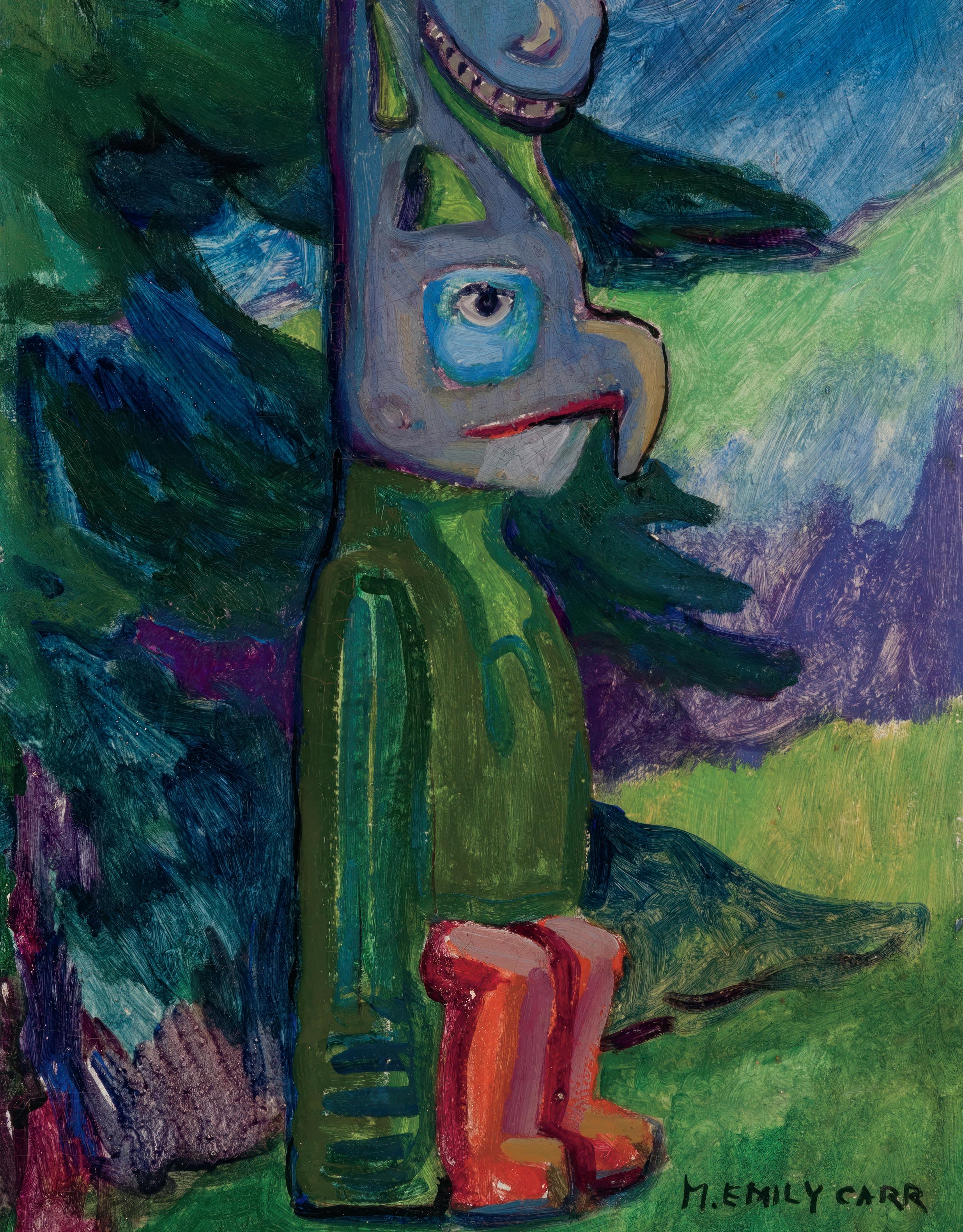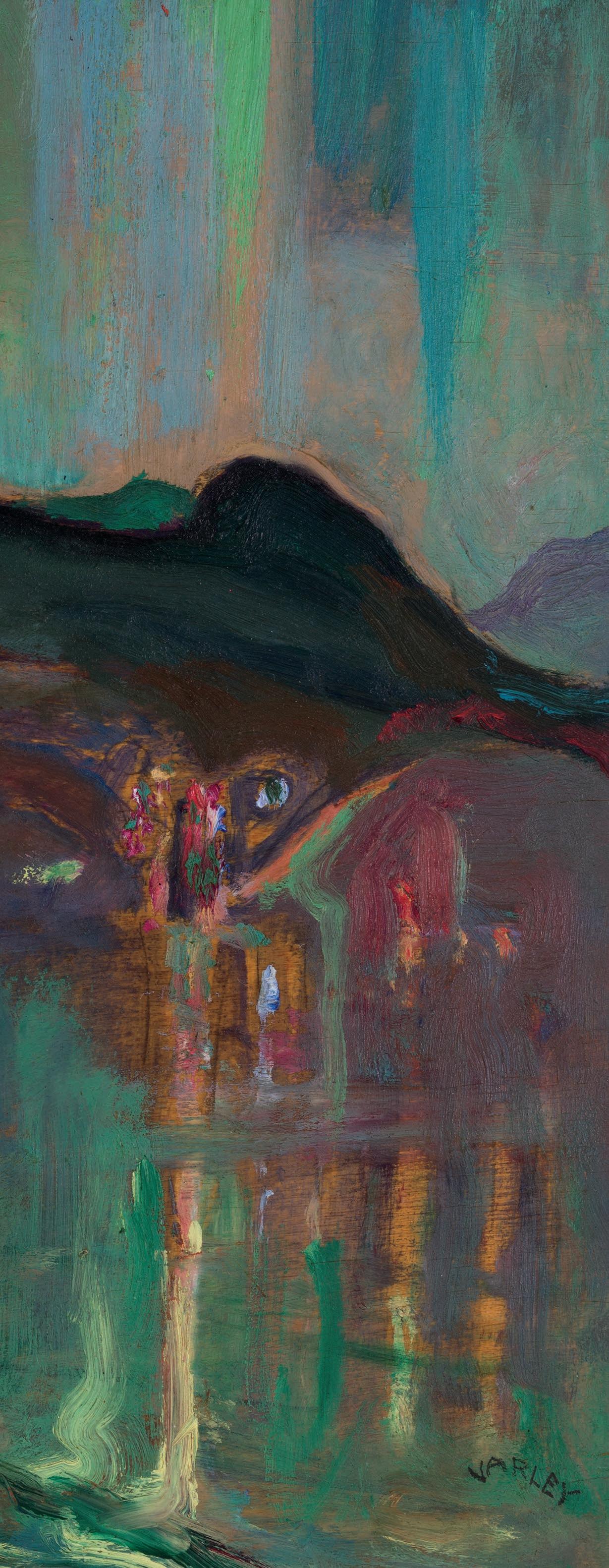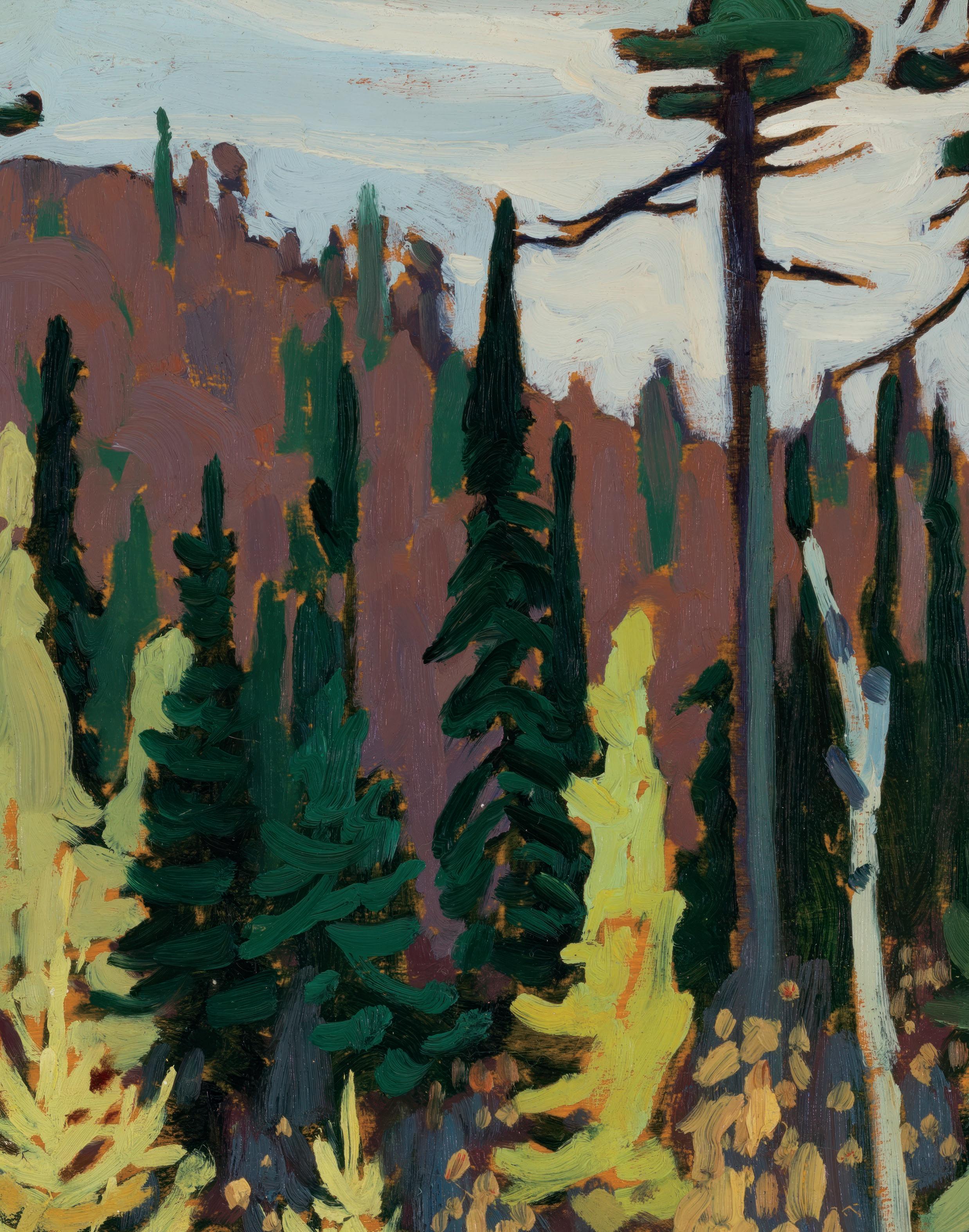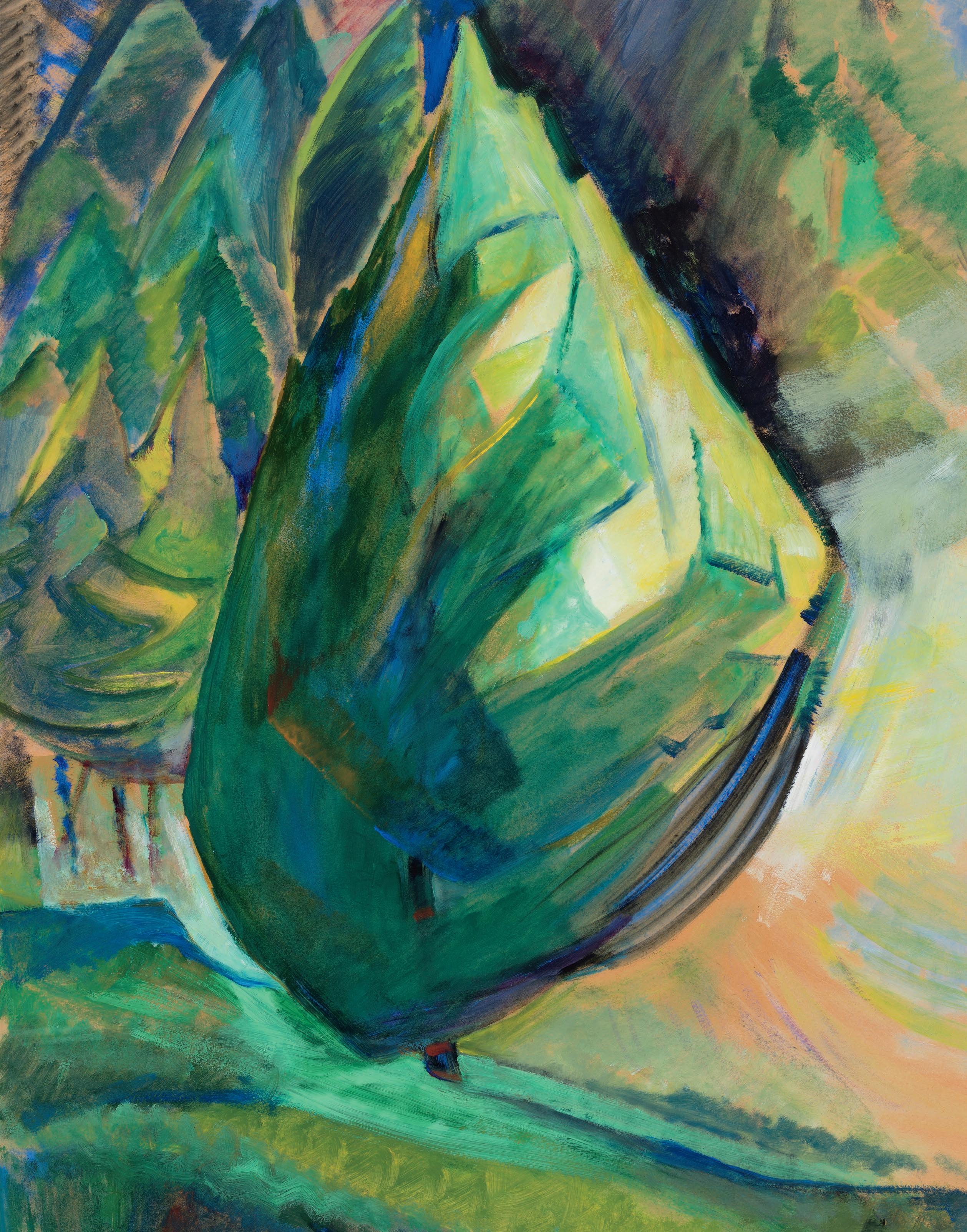au C tion details
Selling at Auction
Heffel offers individuals, collectors, corporations and public entities a full-service firm for the successful de-acquisition of their artworks. Interested parties should contact us to arrange for a private and confidential appointment to discuss their preferred method of disposition and to analyse preliminary auction estimates, pre-sale reserves and consignment procedures. This service is offered free of charge.
If you are from out of town or are unable to visit us at our premises, we would be pleased to assess the saleability of your artworks by mail, courier or e-mail. Please provide us with photographic or digital reproductions of the artworks front and verso and information pertaining to title, artist, medium, size, date, provenance, etc. Representatives of our firm travel regularly to major Canadian cities to meet with Prospective Sellers.
It is recommended that property for inclusion in our sale arrive at Heffel at least 90 days prior to our auction. This allows time to photograph, research, catalogue and promote works and complete any required work such as re-framing, cleaning or conservation. All property is stored free of charge until the auction; however, insurance is the Consignor’s expense.
Consignors will receive, for completion, a Consignment Agreement and Consignment Receipt, which set forth the terms and fees for our services. The Seller’s Commission is the amount paid by the Consignor to the Auction House on the sale of a Lot, which is calculated on the Hammer Price, at the rates specified in writing by the Consignor and the Auction House on the Consignment Agreement, plus applicable Sales Tax. Consignors are entitled to set a mutually agreed Reserve or minimum selling price on their artworks.
Buying at Auction
All items that are offered and sold by Heffel are subject to our published Terms and Conditions of Business, our Catalogue Terms and any oral announcements made during the course of our sale. Heffel charges a Buyer’s Premium calculated on the Hammer Price as follows: a rate of twenty-five percent (25%) of the Hammer Price of the Lot up to and including $ 25,000; plus twenty percent (20%) on the part of the Hammer Price over $ 25,000 and up to and including $ 5,000,000; plus fifteen percent (15%) on the part of the Hammer Price over $ 5,000,000, plus applicable Sales Tax.
If you are unable to attend our auction in person, you can bid by completing the Absentee Bid Form found on page 88 of this catalogue. Please note that all Absentee Bid Forms should be received by Heffel at least two (2) business days prior to the commencement of the sale. Bidding by telephone, although limited, is available. Please make arrangements for this service well in advance of the sale. Telephone lines are assigned in order of the sequence in which requests are received. We also recommend that you leave an Absentee Bid amount that we will execute on your behalf in the event we are unable to reach you by telephone. Digital Saleroom online bidding is available subject to pre-registration approval by the Auction House at least two (2) business days in advance of the auction.
Payment must be made by: a) Bank Wire direct to the Auction House’s account, b) Certified Cheque or Bank Draft, c) a Personal or Corporate Cheque, d) Debit Card and Credit Card only by Visa, Mastercard or Union Pay or e) Interac e-Transfer. Bank
Wire payments should be made to the Royal Bank of Canada as per the account transit details provided on your invoice. All Certified Cheques, Bank Drafts and Personal or Corporate Cheques must be verified and cleared by the Auction House’s bank prior to all purchases being released. Credit Card payments are subject to our acceptance and approval and to a maximum of $ 5,000 if the Buyer is providing their Credit Card details by fax or to a maximum of $ 25,000 per Lot purchased if paying online or if the Credit Card is presented in person with valid identification. The Buyer is limited to two e-Transfers per Lot and up to a maximum of $ 10,000 per e-Transfer as per the instructions provided on your invoice. In all circumstances, the Auction House prefers payment by Bank Wire.
General Bidding Increments
Bidding typically begins below the low estimate and generally advances in the following bid increments:
$ 50 – 300
$ 300 – 500
$ 500 – 2,000
$ 2,000–5,000
$ 25 increments
$ 50
$ 100
$ 250
$ 5,000–10,000 $ 500
$ 10,000–20,000
$ 20,000–50,000
$ 50,000–100,000
$ 100,000–300,000
$ 300,000–1,000,000
$ 1,000,000–2,000,000
$ 1,000
$ 2,500
$ 5,000
$ 10,000
$ 25,000
$ 50,000
$ 2,000,000–3,000,000 $ 100,000
$ 3,000,000–5,000,000 $ 250,000
$ 5,000,000–10,000,000 $ 500,000
$ 10,000,000+
$ 1,000,000
Framing, Conservation and Shipping
As a Consignor, it may be advantageous for you to have your artwork re-framed and/or cleaned and conserved to enhance its saleability. As a Buyer, your recently acquired artwork may demand a frame complementary to your collection. As a full-service organization, we offer guidance and in-house expertise to facilitate these needs. Buyers who acquire items that require local delivery or out-of-town shipping should refer to our Shipping Authorization Form for Property on page 91 and our Terms and Conditions for Shipping on page 92 of this publication. Please feel free to contact us to assist you in all of your requirements or to answer any of your related questions. Full completion of our shipping form is required prior to purchases being released by Heffel.
Written Valuations and Appraisals
Written valuations and appraisals for probate, insurance, family division and other purposes can be carried out in our offices or at your premises. Appraisal fees vary according to circumstances. If, within five years of the appraisal, valued or appraised artwork is consigned and sold through Heffel, the client will be refunded the appraisal fee, less incurred “out of pocket” expenses on a prorated basis.
5
VERSION 2022.09 © H E ff E l G A ll ER y lIMITE d
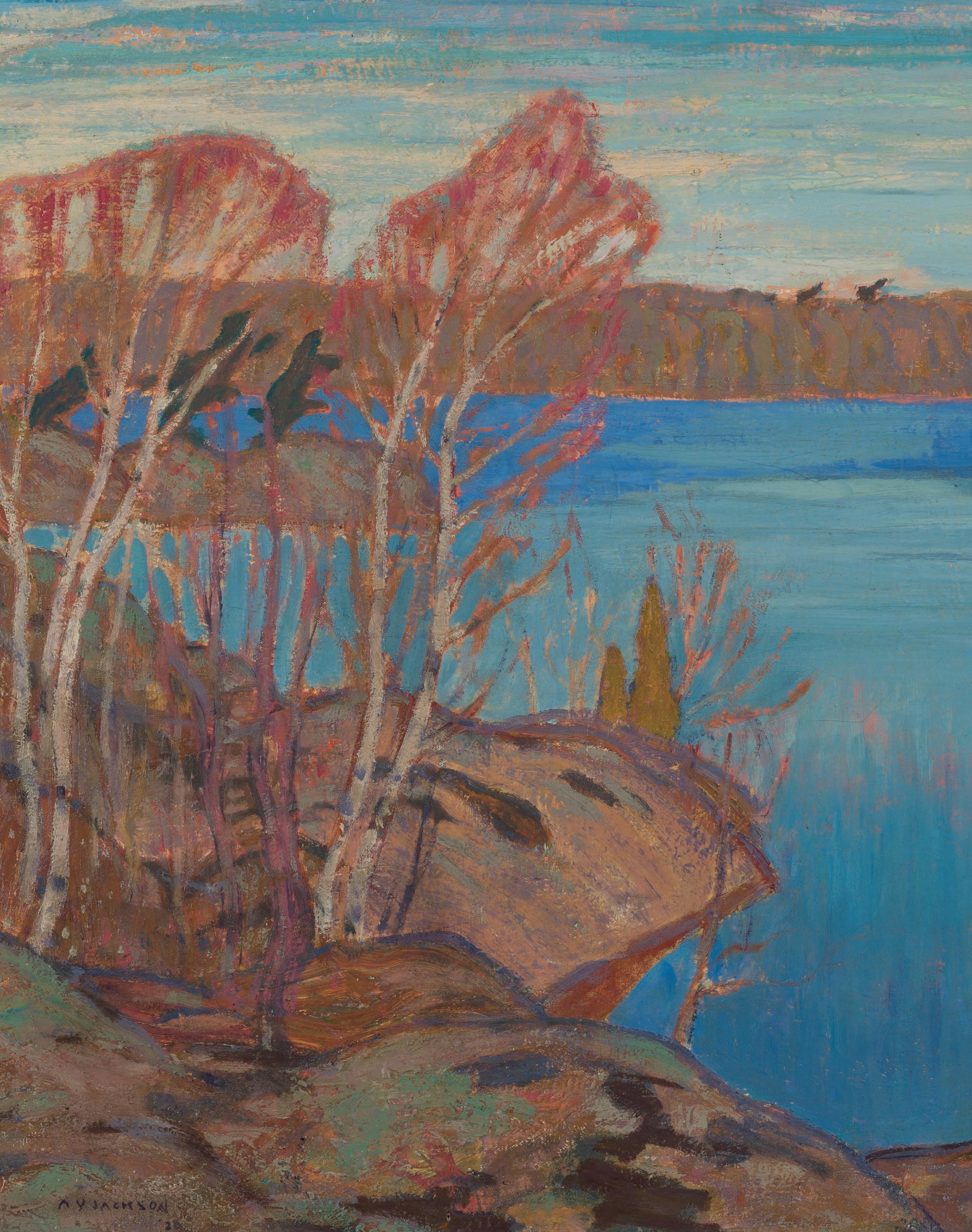

f eaturing w orks fro m The Estate of Jacqueline Desmarais The Family of Frederick Varley A Prominent Montreal Estate & other Important Private and Corporate Collections s ale T hursday, May 25, 2023 · 4 PM PT | 7 P M ET Canadian, i mpressionist & m odern art catalogue
Fox River, Gaspé
p rovenan C e
The Art Emporium, Vancouver, 1976
By descent to the present Private Collection, Vancouver
l iterature
Naomi Jackson Groves, A.Y.’s Canada, 1968, page 32
Pierre B. Landry, editor, Catalogue of the National Gallery of Canada, Canadian Art: Volume Two / G–K, 1994, a related 1936 drawing entitled Fox River, General View, catalogue #17869v, reproduced page 252
I N SPRING O f 1936, A.Y. Jackson headed to Fox River, in the picturesque eastern part of the Gaspé Peninsula, for his annual late winter / early spring sketching trip. Jackson found the weather so stormy, rainy and foggy that he could hardly paint outdoors, and
so he produced mostly drawings, making this a rare oil sketch from that trip. He complained bitterly about the conditions in a letter, stating, “It’s been a lousy spring . still don’t know if I am going to get anything worthwhile.” The first visitor to the area, Jacques Cartier, over 400 years previous, also complained of “a contrary winde, with great fogges and stormes.”
Jackson depicts scenic elements such as a rowboat pulled up beside a house, woodpiles, and the iconic horse and sleigh. The church with its spire piercing the sky is at the heart of the village. Jackson’s brush-strokes are broad and rhythmic; there is a rollicking roll to the piles of snow, the Laurentian hills in the background and the layers of clouds overhead. Jackson shows his affinity for Impressionism in his rich and varied tints in the snow: mauve, blue, green and pink with touches of coral and yellow. Not only did Jackson get something “worthwhile,” he surpassed that— Fox River, Gaspé is exceptional.

This fine oil sketch has been in the collection of the same family for almost 50 years.
e stimate: $ 30,000 – 50,000
8
CGP G7 OSA RCA RSA 1882 – 1974
101 Alexander Young (A.Y.) Jackson
ALC
oil on board, signed and on verso signed, titled and inscribed Studio Bldg Severn St., Toronto and canvas Karen B indistinctly, 1936 8 1/2 × 10 1/2 in, 21.6 × 26.7 cm
102 Sir Frederick Grant Banting
1891 – 1941
The Church at St. Fidèle, Quebec oil on board, signed and on verso titled, dated Approximately 1934–36 (crossed out) and 1930 on the exhibition label and inscribed To Mr. McCaul, Sincerely Banting and 12943 8 × 10 1/2 in, 20.3 × 26.7 cm
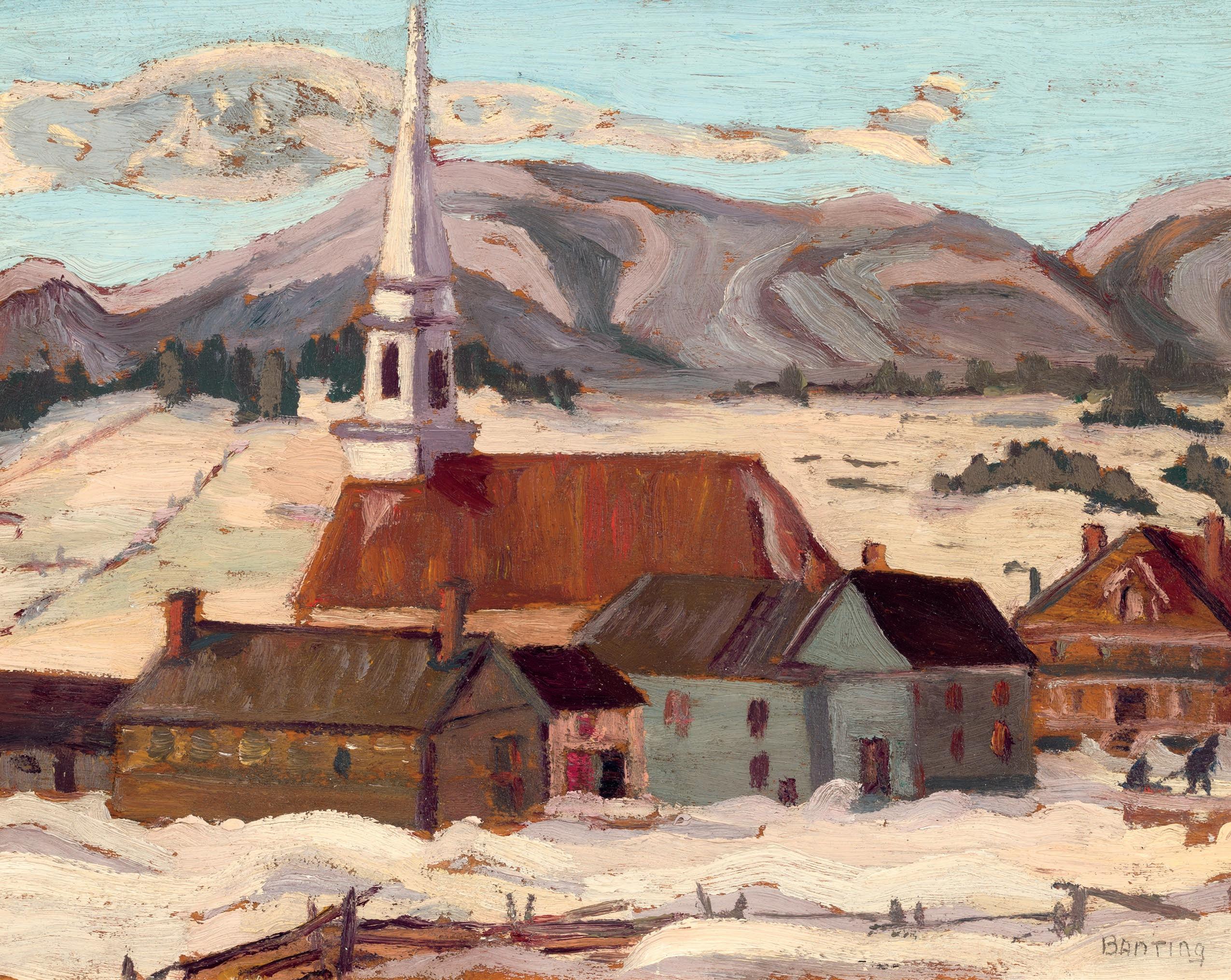
p rovenan C e
A gift from the Artist to R. Melbourne McCaul, Toronto
Private Collection, Ontario
By descent to a Private Collection, Ontario
Contemporaries of the Group of Seven, Heffel Fine Art Auction House, May 1, 2020, lot 403
Private Collection, Toronto
l iterature
A.Y. Jackson, Banting as an Artist, 1943, another view, entitled Church at St. Fidele, reproduced page 19
Stephen Eaton Hume, Frederick Banting: Hero, Healer, Artist, 2001, page 120
e xhibited
Hart House, Toronto, Exhibition of Paintings by the Late Sir Frederick Banting, February 13 – March 1, 1943
I N EAR ly SPRING 1930, Frederick Banting and A.Y. Jackson traveled to Saint-Fidèle, a small village below Murray Bay in the scenic Charlevoix region, where they sketched en plein air Jackson related, “There were long hikes on the roads or across country on snowshoes, lunch with a fire on top of the snow to warm ourselves and toast our sandwiches, and tea made in a lard pail.” Banting enjoyed this rugged painting experience with Jackson, who observed, “Rural Quebec with its farmhouses and churches was a land forgotten by time, and Banting didn’t want to leave.” Compared to Banting’s social existence in Toronto as a famous scientist and co-discoverer of insulin, he found the simple life of the humble villages and countryside more authentic.
This bright, fresh sketch is superb. Banting captured a rolling rhythm in the land, using fluid brush-strokes in the foreground snow and in the mountains. Jackson’s influence is reflected in Banting’s use of strong brushwork and in his palette of delicate tints. Pale pastels glow in the snow, contrasted with stronger colours in the houses and the iconic church, whose spire rises into the glowing blue sky. A charming inclusion in this strong composition is the motif of the villager in the lower right pulling a sled.
The first owner of this work, R. Melbourne McCaul, was president of the Bank of Montreal in Toronto in the 1930s and 1940s.
e stimate: $ 25,000 – 35,000
9
ALC
Canmore
oil on board, signed and on verso signed, titled and titled View of Canmore, Alberta on the Art Gallery of Toronto label and dated Sept. 1947

10 1/2 × 13 1/2 in, 26.7 × 34.3 cm
p rovenan C e
Lady Virginia Kemp, Toronto
Masters Gallery Ltd., Calgary
By descent to the present Private Collection, British Columbia
l iterature
Naomi Jackson Groves, A.Y.’s Canada, 1968, page 170 Dennis Reid, Alberta Rhythm: The Later Work of A.Y. Jackson, Art Gallery of Ontario, 1982, page 24
e xhibited
Art Gallery of Toronto, circa 1950s, catalogue #3
B EGINNING IN 1943 , Group of Seven painter A.Y. Jackson taught summer sessions as an instructor at the Banff School of Fine Arts,
and he returned each year (except 1948) until 1949. After his teaching was over, he would spend a month in the region painting the surrounding landscape, because as he stated, “There is some grand country in the west.”
Canmore, Alberta, in the valley of the Bow River with a backdrop of the Rockies, was certainly “grand country.” Dennis Reid wrote of this striking area: “Over all the blue arch of sky spanned the wide valley and seemed to rest upon the great ranges on either side, like the dome of a vast cathedral.” This bright, colourful oil sketch, with its dreamy cloud islands floating over the town and mountains, is an outstanding work from this part of Jackson’s oeuvre.
The original owner of this painting, Lady Virginia Kemp, had a notable record of philanthropy. Among her charitable contributions, she was a supporter of the Canadian National Institute for the Blind, and was elected its president in 1954. Kemp was also a patron of the arts; from 1932 she became a benefactor member of the Art Gallery of Toronto (now Art Gallery of Ontario), and in 1945, formed its Women’s Committee, which managed many projects for the gallery.
e stimate: $ 20,000 – 30,000
10
103 Alexander Young (A.Y.) Jackson
OSA RCA RSA 1882 – 1974
CGP G7
104 Sir Frederick Grant Banting
1891 – 1941
Lake in the Rockies
oil on board, signed and on verso stamped with the authenticity stamp of Henrietta E. Banting, dated Oct. 3, 1979, and inscribed
D.B. Mansur, Executor, Estate of H.B. Banting, circa 1934
10 3/8 × 13 1/2 in, 26.4 × 34.3 cm
p rovenan C e
Collection of the Artist
Estate of Dr. Henrietta Banting
Canadian Paintings, Drawings, Watercolours, Prints and Books of the 19th and 20th Centuries, Sotheby’s Canada, May 3, 1983, lot 145
Private Collection, Ontario
AlTHOUGH THE l I f E of Dr. Frederick Banting is well documented, it is unknown whether his close friend and frequent
sketching partner A.Y. Jackson was with Banting when he painted this striking en plein air oil sketch. The influence of Jackson can often be sensed in Banting’s paintings, although this example brings to mind another member of the Group of Seven—Lawren Harris. It bears a strong resemblance to Harris’s sketch Maligne Lake, Jasper Park, painted in 1924, which was the basis for the magnificent canvas of the same title in the collection of the National Gallery of Canada. This aesthetic touchstone is interesting, in that Banting was not initially enamoured of Harris’s approach. In fact, the pair first met because of Banting’s negative response to one of Harris’s stylized Lake Superior landscapes. Serendipitously, Banting’s ophthalmologist was none other than Dr. James MacCallum, friend and patron to the Group of Seven and Tom Thomson. He encouraged Banting to seek out Harris and discuss directly with the artist the work he had seen, thereby connecting two of the greatest creative minds of their time.
e stimate: $ 20,000 – 30,000

11
105 James Edward Hervey (J.E.H.) MacDonald
ALC CGP G7 OSA RCA 1873 – 1932
Wiwaxy Peaks, Lake O’Hara Camp oil on board, initialed and dated 1928 and on verso titled on various labels, dated September 18, 1928 on the Galerie Alan Klinkhoff label and inscribed
H.S. Southam CMG and 1378 on various labels
8 1/2 × 10 3/4 in, 21.6 × 27.3 cm
p rovenan C e
Mellors Fine Arts Ltd., Toronto
H.S. Southam, Ottawa
John Armstrong, Calgary
Masters Gallery Ltd., Calgary
Private Collection, Arizona
Galerie Alan Klinkhoff, Montreal
Private Collection, Montreal
W IWA xy P EAKS IS near Lake O’Hara in Yoho National Park, one of J.E.H. MacDonald’s favourite sketching areas in the Rockies. During his painting trips there in the 1920s, MacDonald stayed
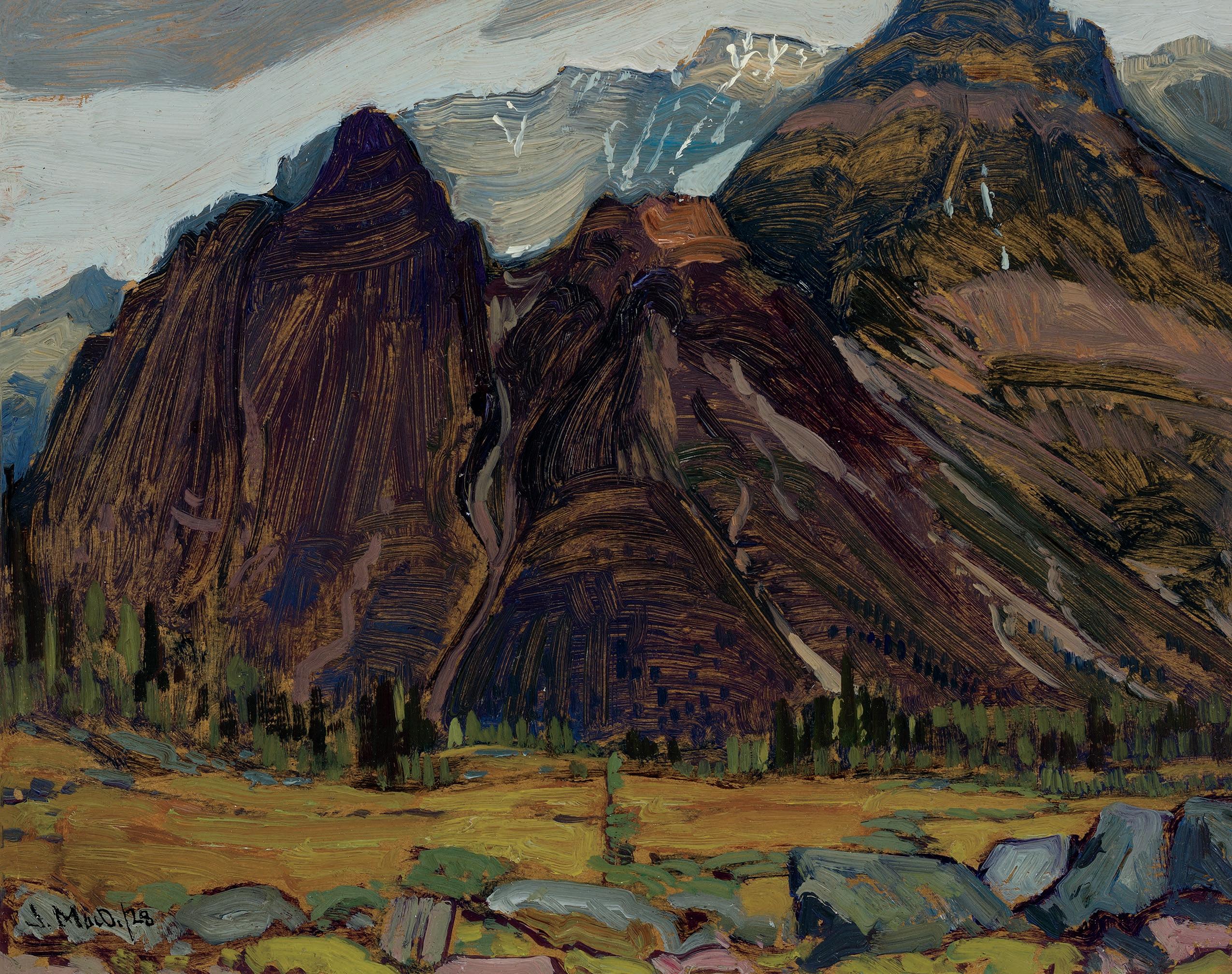
at Lake O’Hara Bungalow Camp in 1924 and 1925. Construction of a new lodge began in 1925, and the original cabins were moved from the alpine meadows to the shores of Lake O’Hara nearby. After 1926, MacDonald continued to use these cabins as his base. The distinctive ridge lines of Wiwaxy Peaks were a regular motif in the artist’s design work and his sketches of the Lake O’Hara area.
On September 1, 1928, MacDonald arrived at the Lake O’Hara camp. Lawren Harris, Fred Housser and Arthur Lismer were already sketching there, and MacDonald found himself in stimulating company. MacDonald’s paintings of the Rockies were sculptural, raw and visceral. The weather in the area was wild, with snow, rain or hail, but MacDonald delighted in the alpine conditions and the varied skies. This superb oil sketch captures the imposing, massive peaks, fully revealed after a summer of melting snow. MacDonald’s rugged brush-strokes express the verticality of the rough-hewn rock ridges falling to the verdant valley, while the paler range behind gives the impression of distance. An opening in the sky casts light over the background range, while above, dark clouds express the changeable and dramatic atmosphere that MacDonald found so interesting.
e stimate: $ 80,000 – 120,000
12
106 Alexander Young (A.Y.) Jackson
ALC CGP G7 OSA RCA RSA 1882 – 1974
Quebec Village
oil on panel on board, signed and on verso titled on the gallery label and inscribed 7934 , circa 1930 8 1/2 × 10 1/2 in, 21.6 × 26.7 cm
p rovenan C e
Continental Galleries Inc., Montreal
By descent to the present Private Collection, British Columbia
literature
Wayne Larsen, A.Y. Jackson: The Life of a Landscape Painter, 2009, page 113
dURING THE 1920 S , A.Y. Jackson rarely missed his annual late winter / early spring trips to the Quebec villages on the north and south shores of the St. Lawrence River. In 1930, Jackson sketched at Saint-Fidèle, Les Éboulements and Saint-Urbain, Quebec. Paintings such as this were at the heart of Jackson’s oeuvre. One

senses in them the affection he felt for these small villages, as yet untouched by modernization. His autobiography A Painter’s Country is full of stories about his stays in various villages—at small hotels or boarding with families, eating their home-cooked meals (very important when he was outside painting in the cold!) and enjoying simple entertainment. Jackson took to snowshoes while searching for subjects, and as a consequence, was nicknamed “Père Raquette.” Marius Barbeau, the French Canadian folklorist, anthropologist and a lifelong friend of Jackson, maintained this was more than a simple nickname. As Wayne Larsen wrote, “It symbolized Jackson’s closeness to his fellow Quebecers and his understanding of the rural culture in that province.” This is a classic Group of Seven period Quebec village painting, replete with charming features such as the small flock of birds flying overhead, the colourful houses, and the bell tower of the church rising into a rich blue sky. Sunshine floods the tranquil scene, creating a mood of timeless reverie.
e stimate: $ 30,000 – 40,000
13
107 Frederick Horsman Varley
ARCA G7 OSA 1881 – 1969
Northern Lights, BC oil on board, signed and on verso titled on the Edmonton Art Gallery exhibition label and partially titled on the Canadian Society of Graphic Arts label, inscribed #14721 / Varnish / 1 (circled) and stamped James Wood & Co., Vancouver, B.C. Plywood, circa 1936 – 1940 12 × 15 in, 30.5 × 38.1 cm
p rovenan C e
A gift from the Artist to his son, Jim, and daughter-in-law, Marjory, on the occasion of their marriage, circa 1940
By descent within the Varley family to the present Private Collection, British Columbia
l iterature
Christopher Varley, F.H. Varley: A Centennial Exhibition, Edmonton Art Gallery, 1981, reproduced page 135
Peter Varley, Frederick H. Varley, 1983, page 114, the circa 1933 canvas The Open Window, Hart House Permanent Collection, University of Toronto, reproduced page 115
e xhibited
Canadian Society of Graphic Arts, circa 1940, partial label on verso
Spring Exhibition, Art Association of Montreal, 1940
Edmonton Art Gallery, F.H. Varley: A Centennial Exhibition, traveling in 1981 – 1982 to the Art Gallery of Greater Victoria; National Gallery of Canada, Ottawa; Montreal Museum of Fine Arts; and Art Gallery of Ontario, Toronto, catalogue #145

14
fRE d ERICK VAR l E y’ S RE l ATIONSHIP with the British Columbia landscape began in 1926, when he traveled to Vancouver from Toronto to take a teaching position at the Vancouver School of Decorative and Applied Arts. The Varley family moved into “The Bungalow” at 3857 Point Grey Road, overlooking Jericho Beach, the Strait of Georgia, Bowen Island and the North Shore mountains. It is hard to imagine an artist being able to live in this splendid neighbourhood now, given the high property value of houses on Point Grey Road. The house had a big deck looking out over the water, and Varley even painted out of his window there, such was the ease with which he could depict the stunning views from the comfort of his studio at all times of the day and night. He took day trips to the North Shore mountains to paint and longer trips during the summer to Garibaldi Park, where he hiked and camped. He found a far different landscape from Ontario— thick forests with cedar, hemlock and Douglas fir, moody skies and coasts—and it changed his work, both in feeling and style. Varley eloquently expressed the impact of the BC landscape on his soul:
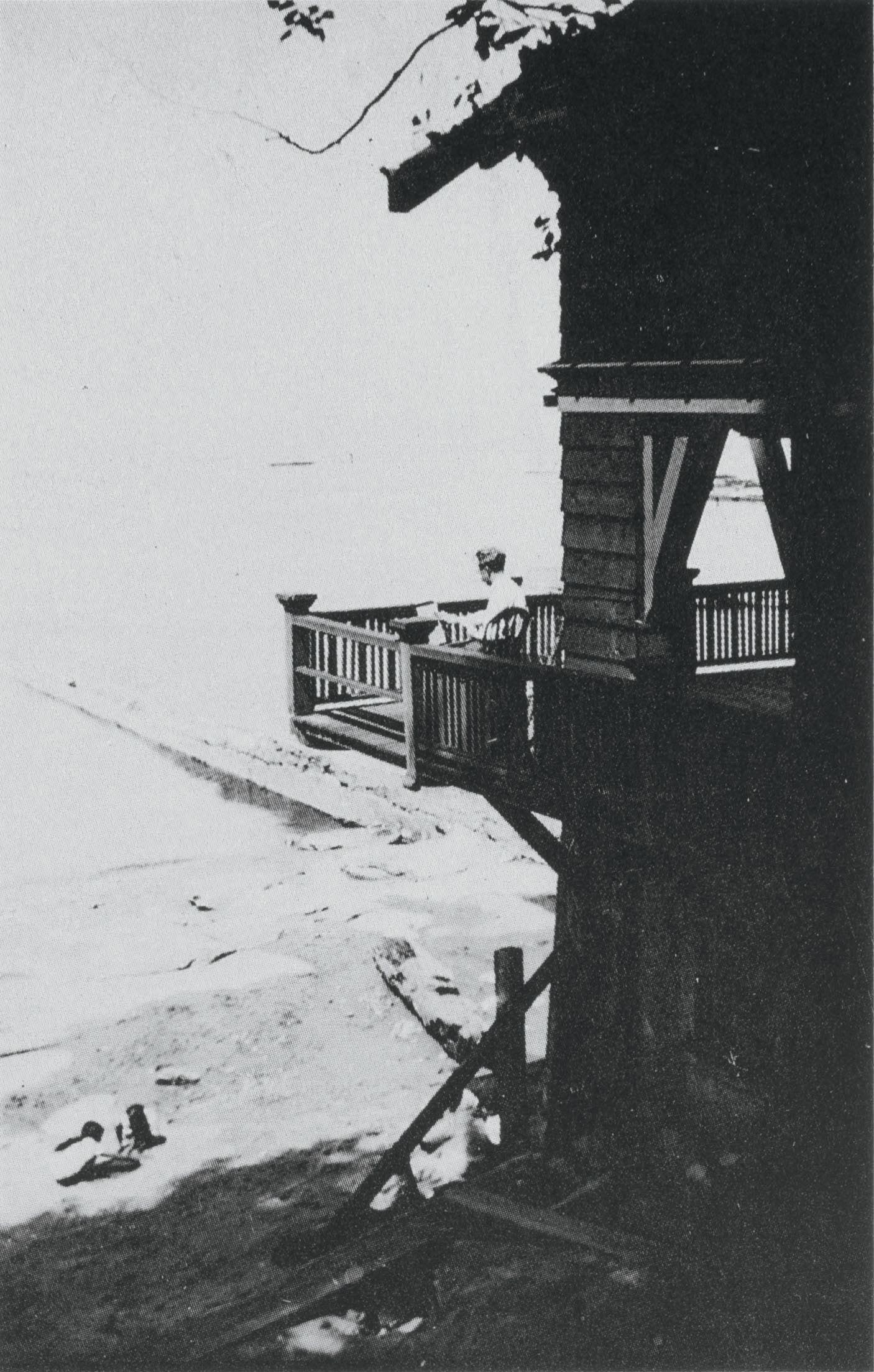
British Columbia is heaven . It trembles within me and pains me with its wonder as when a child I first awakened to the song of the earth . The sea is here, and the sky is vast I often feel that only the Chinese of the eleventh and twelfth century ever interpreted the spirit of such a country. We have not yet awakened to its nature.
Wonder is certainly the feeling experienced on first sight of this awe-inspiring night view of the North Shore mountains backed by radiant northern lights. The aurora borealis occurs as a result of disturbances in the Earth’s magnetosphere caused by the solar wind from coronal mass ejections, and it is rarely seen as far south as Vancouver, unless these disturbances are very strong. And rarer still are these very colourful waves—the northern lights usually manifest as an eerie green hue in southern BC .
Varley’s mastery of colour and atmosphere is magnificent here. The rays of electrically charged light shoot heavenward from behind the mountains, which loom darkly. The sea is a darker version of the action in the sky, marked by colourful reflections from the North Shore and clusters of buildings in the city, their warm hues on the right a fine contrast to the spectral blue, green and mauve pulsing in the sky.
The catalogue for the 1981 centennial exhibition at the Edmonton Art Gallery lists a circa date of 1936 to 1940 for this work. Varley went back to Ottawa in 1936, but he returned to Vancouver for several weeks in late summer of that year, as well as in the summer of 1937. But the painting recalls the style and composition of the circa 1933 canvas The Open Window (Hart House Permanent Collection) with its rippling water in the foreground and view of the mountains, as well as the 1932 oil From Kitsilano (sold by Heffel May 22, 2008, lot 114). This view, which included the aforementioned house Varley lived in until 1934, looked north over Jericho Beach towards Hollyburn Ridge in West Vancouver.
Varley was a superb colourist. He taught colour theory and was aware of Buddhist attributions of psychological meanings to colour. In his paintings he generally used a palette of closely related hues, while making small changes in value or chroma. He used prismatic colours—including iridescent blue-greens and violets—and believed that objects emanated colour vibrations. Varley associated green with the spiritual and pale violet with aesthetics, entirely appropriate for this painting with its pulsating cosmic rays.
This extraordinarily beautiful painting has been in the collection of the Varley family until its consignment to Heffel this spring.
e stimate: $ 60,000 – 80,000
15
Frederick Varley, painting from his Jericho Beach veranda, 3857 Point Grey Road, circa 1927 Photographer unknown
108 Emily Carr
BCSFA CGP 1871 – 1945
Sitka Totem Pole oil on canvas, signed M. Emily Carr and on verso inscribed $ 400 / XV and variously and stamped twice with the Dominion Gallery stamp, 1912 34 1/2 × 11 1/2 in, 87.6 × 29.2 cm
p rovenan C e:
Dominion Gallery, Montreal Acquired from the above by a Private Collection, Montreal By descent to the present Private Collection, Ontario
l iterature:
Charles C. Hill et al., Emily Carr: New Perspectives on a Canadian Icon, National Gallery of Canada, 2006, reproduced page 72 and listed page 306
e xhibited:
Dominion Hall, Vancouver, Paintings of Indian Totem Poles and Indian Life by Emily Carr, April 1913
National Gallery of Canada, Ottawa, Emily Carr: New Perspectives on a Canadian Icon, June 2 – September 4, 2006, traveling in 2006 – 2008 to the Vancouver Art Gallery; Art Gallery of Ontario, Toronto; Montreal Museum of Fine Arts; and Glenbow Museum, Calgary, catalogue #141
T HE CANVAS Sitka Totem Pole marks an important moment in Emily Carr’s career. She painted it for a landmark exhibition that she held in April 1913, Paintings of Indian Totem Poles and Indian Life by Emily Carr. 1 She rented a grand public assembly hall, the Dominion Hall on Pender Street, where the Vancouver Canadian Club had held its inaugural luncheon in the presence of the governor general in 1906. That same year, Carr had established herself in Vancouver after returning from art studies in England. The hall was also where the British Columbia Society of Fine Arts, of which she was a founding member in 1909, had mounted its first annual show.
This 1913 exhibition was the public launch of her project to make a record of all remaining First Nations totem poles in their village settings. Vancouver as yet did not have an art gallery, but Carr’s local landscape watercolours had already garnered considerable success when shown at the city’s two fledgling art organizations. In 1910 and 1911 she spent a further period of study, this time in France, where she became a convert to the bold colours and arabesque lines of her Post-Impressionist and Fauve teachers. Returning to Vancouver with her ambition redoubled, she first put on a display of 70 of her French works in her newly rented West Broadway studio. Her subsequent 1913 show, entirely of Indigenous subjects, was a huge and educational venture. A lengthy review in the Vancouver Province announced:

Miss Carr has for a number of years made a special study of this class of work and has made many expeditions into remote parts of the country in order to secure material for her sketches. The collection which she is now showing and
which is said to be the largest ever secured on this subject by any one artist, comprises nearly two hundred canvases and if the pictures are kept together will doubtless form, in years to come, a very valuable record of a passing race.
The reviewer added that on two nights, Miss Carr would give a lecture on the poles and their significance.
Carr had prepared this explanatory lecture by reading the books on anthropology available to her in Vancouver at the time and, whenever she could, by asking people in the First Nations villages about the meaning of their carvings. She knew she was no expert, but she wished to advocate for the value of Indigenous traditions in her province. 2
Her boldly and lusciously painted canvas Sitka Totem Pole, from 1912, would have been an anchor point in this show. Carr explained in her “Lecture on Totems” that the carved cedar poles were “peculiar to the North West Coast,” from Alaska down to the Vancouver area, mentioning that she had learned from a Squamish elder that his village had formerly held many carved lodge poles. The 1912 painting also had a personal significance for Carr. It was inspired by a visit she made to Alaska in 1907, a holiday cruise with her sister Alice, when for the first time she saw displays of monumental poles and where her project to record them was conceived. There she had met an American artist, Theodore J. Richardson, who visited Alaska during the summers, traveling with local Tlingit and Kaigani Haida people to make paintings of their villages, which he successfully sold in New York. 3
16
Fi Gu R e 1: Totem poles installed at the Lewis and Clark Centennial Exposition in Portland in 1905. The pole at the left is in Carr’s painting Sitka Totem Pole
Photo: National Park Service
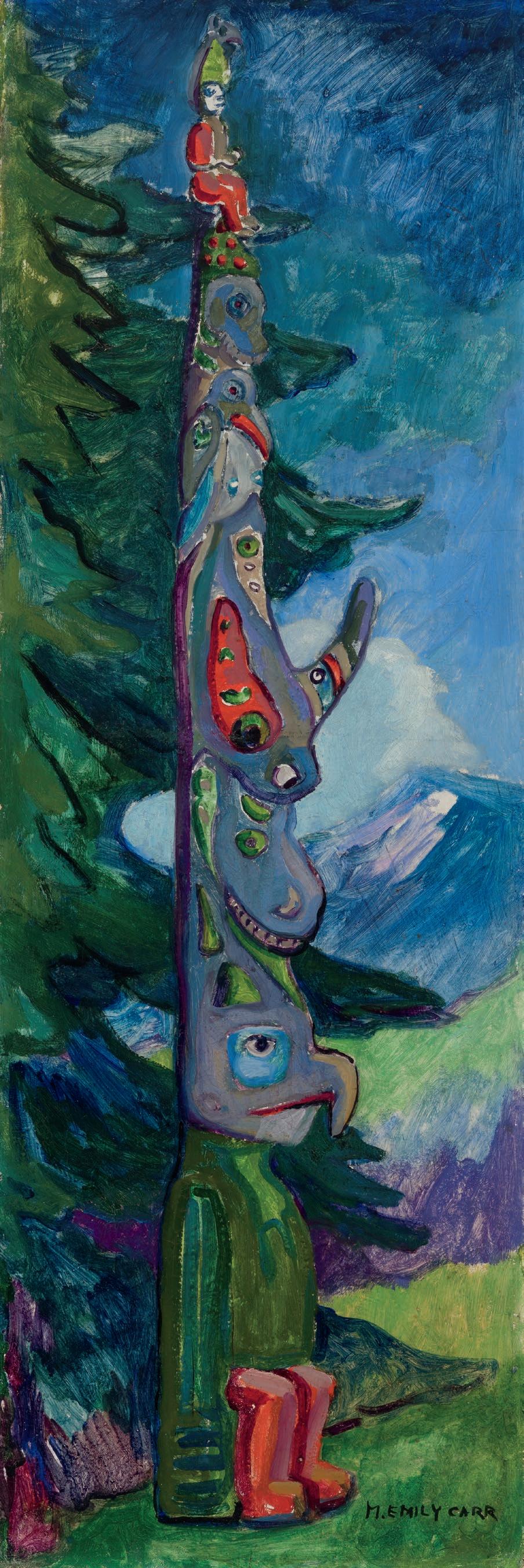
17
Not
While in Sitka, the Carr sisters had visited Totem Walk, a striking display of Tlingit and Haida poles set up in a park as an attraction for tourists. The poles had been secured in 1904 by Governor John Green Brady to represent Alaska’s heritage at the Louisiana Purchase Exposition in St. Louis. They were then sent on to the Lewis and Clark Centennial Exposition in Portland in 1905 (figure 1) and after being repaired and retouched with fresh paint were installed at Sitka (figure 3). 4 It is one of these poles, taken from the Tlingit village of Tuxekan on Prince of Wales Island, that Carr sketched in 1907, and depicted in the oil painting Sitka Totem Pole in 1912.
We have a fascinating document of the Carr sisters’ experiences on their Alaska trip in the form of a book Emily made to illustrate their journey. In her memoirs she described it thus: “We kept a diary called the ‘funny book’ every evening I drew a skit of something that had happened that day & we wrote it up.” 5 Carr repeatedly declared in her writings that this journey was the site of her epiphany about First Nations’ artistic heritage, so it is curious that only one page in the travel diary shows a totem pole. This one page, however, represents the very pole featured in Carr’s 1907 watercolour (figure 2) and the 1912 oil.
In her image Carr has positioned caricatures of herself and the red-haired Alice, both on tiptoe, gawping in amazement up at the
animal carvings and the height of the pole. Carr refers to the welldressed gentleman shown beside them as “La Totem,” and he is clearly lecturing to them about the carvings on the pole. As we can see from the photograph of the pole and from Carr’s various renderings, these are, from top to bottom, a raven, a seated man, a downward facing frog, a bird (cormorant or raven), a whale, and an eagle. And who was La Totem?
Carr’s text opposite the watercolour (figure 2) tells us (with her spellings): “We were immediately adopted, and straightway taken for our initaition trip to the totem poles, and thereafter bourn thither twice daily, for the rest of our sojourn in Sitka ” She amplified in a later memoir, “In Skagway we were introduced to a ‘Pole’ Domiarmus Mutchulous he was customs or emigration or something. He was in Sitka during our visit and took us about.” 6 In the “funny book” Carr made drawings of a perilous and exhausting excursion on Mount Verstovia on which they were led by La Totem. When they got lost, Carr has him exclaiming “Mein Gott!” Their guide, then, was probably a German or Polish immigrant, now working as a government official and apparently an enthusiast for anthropology.
Another puzzle is that only two pole sketches have apparently survived from Carr’s Alaska trip. It seems that at this initial stage she had difficulty in recognizing and rendering the abstracted

18
figur E 2: e mily Carr
Collection
Sister and I in Alaska watercolour and ink on paper, 1907
Private
for sale with this lot
forms of the carved crest animals and figures on the poles. In her 1907 watercolour Totem Walk at Sitka, now in the Art Gallery of Greater Victoria, the forms on the pole near the foreground are vague and illegible. In the “funny book” sketch, the animals on the pole being explained to her by La Totem become clearer though not yet stylized in accord with Indigenous formline design.
The oil painting Sitka Totem Pole shows just how far Carr had grown in understanding in the five years from her 1907 visit to Alaska. On subsequent sketching trips, she had made careful studies of hundreds of poles. Her teacher in France had told her in 1911, “Your silent Indian will teach you more than all the art jargon,” 7 and the emphasis on curves and outlines in Fauvism gave her a means to clearly echo the stylized designs. PostImpressionist teachings on light and colour enabled her to render the scale and presence of the coastal terrain in which the First Nations villages were set. Sitka Totem Pole shows the Tlingit pole in a dramatic coastal landscape, but Carr lamented the removal of poles from their villages and from the lives of the Indigenous population in the face of settler domination and demands. She would rejoice to see First Nations peoples reclaiming them today.

We thank Gerta Moray, Professor Emerita, University of Guelph, and author of Unsettling Encounters: First Nations Imagery in the Art of Emily Carr, for contributing the above essay.
1. See Emily Carr, Unvarnished: Autobiographical Sketches by Emily Carr, ed. Kathryn Bridge, (Victoria: Royal BC Museum, 2021), 97 and 199n141.
2. For a discussion of Carr’s attitude to the First Nations people she sought out in British Columbia, and her relations with the anthropologists, missionaries, and politicians who shaped settler views in her day, see Gerta Moray, Unsettling Encounters: First Nations Imagery in the Art of Emily Carr (Vancouver: UBC Press, 2006)
3. Moray, Unsettling Encounters, 81–82 and Carr, Unvarnished, 74 and 194n112.
4. For a detailed history, see National Park Service, “The Poles of Historic ‘Totem Park,’” https://www.nps.gov/sitk/learn/ historyculture/totem-park.htm

5. This book, assumed lost for many years, recently resurfaced and has been published in facsimile as Emily Carr, Sister and I in Alaska, introduction by David Silcox (Vancouver: Figure 1 Publishing, 2013), 51.
6. Quoted in Moray, Unsettling Encounters, 94.
7. Carr, Unvarnished, 73.
e stimate: $ 1,000,000 – 1,500,000
19
F i G u R e 3: Two totem poles in front of a clan house in Tuxekan. The pole on the left is depicted by Carr in Sitka Totem Pole
detail lot 108
Photo: Elbridge W. Merrill / Sitka National Historic Park

20
109 David Brown Milne
CGP CSGA CSPWC 1882 – 1953
Rowboats on Shore i (Severn River, Muskoka, Ontario)
oil on canvas on board, on verso titled Boats on the Shore and inscribed Estate of Mrs. H.O. McCurry on a label, DG 5412 and variously, 1933
12 1/8 × 14 1/2 in, 30.8 × 36.8 cm
p rovenan C e
Collection of the Artist Vincent Massey, 1934
A gift to H.O. McCurry, Ottawa, circa 1935
Canadian Paintings, Drawings, Watercolours, Prints and Books of the 19th and 20th Centuries, Sotheby’s Canada, November 11, 1980, lot 69
Downstairs Gallery, Edmonton
Important Canadian Art, Sotheby’s Canada, May 14, 1984, lot 154
Acquired from the above by the present Private Collection, Ontario
l iterature
David P. Silcox, Painting Place: The Life and Work of David B. Milne, 1996, reproduced page 268
David Milne Jr. and David P. Silcox, David B. Milne: Catalogue Raisonné of the Paintings, Volume 2: 1929 – 1953 , 1998, reproduced page 571, catalogue #303.2
I N 1933 , dAVI d MI l NE separated from his wife and left the village of Palgrave, Ontario, where he had lived for three years, and set out to explore the Trent Canal–Severn River system by canoe, taking along his painting supplies. He first camped over the summer on the Severn River near Big Chute, while looking for a site to build a cabin. Six Mile Lake, an isolated location a mile and a half from Big Chute, was his choice. There Milne was submerged in the natural world, and it provided inspiration unbroken by the distractions of people. The landscape there was one he was familiar with from his time in the western Adirondacks and Temagami—bush, trees, rivers, lakes and rocky outcroppings. These outcroppings are featured here, their strong forms highlighted in white and defined by roughly brushed areas of black. Milne used bright colour on the boats, and patches of orange and mauve add further vivacity to the scene. Black lines define forms and enclose colour areas, while water and sky are a featureless grey, pushing the eye to the foreground and the boats that seem casually yet artfully arrayed on the rocks. Rowboats on Shore i is a bold painting, full of aesthetic pleasures.
e stimate: $ 50,000 – 70,000
21
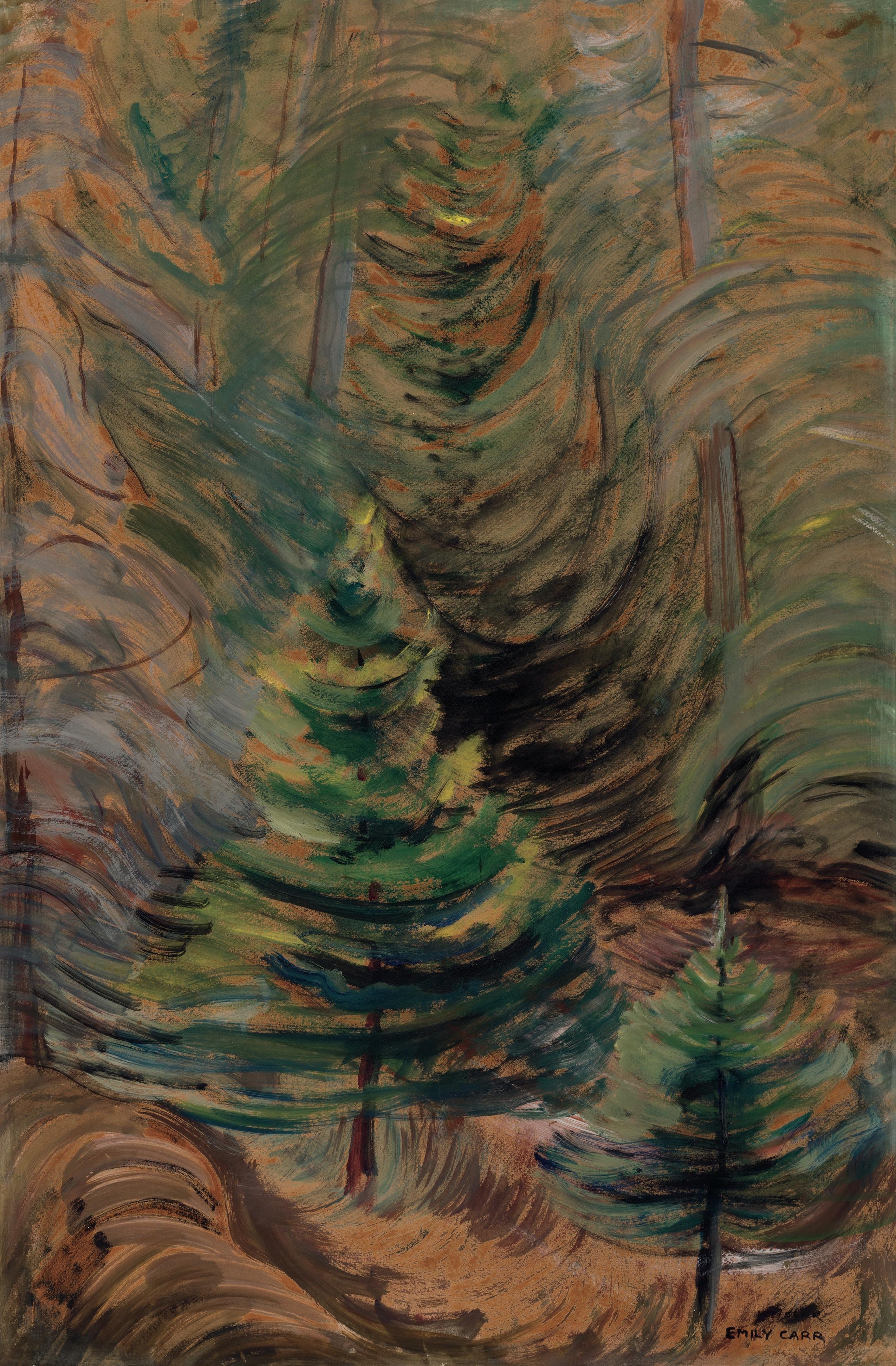
22
110 Emily Carr
BCSFA CGP 1871 – 1945
Pine Tree in Forest
oil on paper on board, signed and on verso titled, inscribed with the Dominion Gallery Inventory #D 128 on the gallery label and variously and stamped twice with the Dominion Gallery stamp, circa 1935 36 × 24 in, 91.4 × 61 cm
p rovenan C e
Dominion Gallery, Montreal
Acquired from the above by a Private Collection, Montreal, 1952
By descent to the present Private Collection, Ontario
l iterature
Doris Shadbolt, The Art of Emily Carr, 1979, the 1931 canvas featuring pines entitled The Little Pine, collection of the Vancouver Art Gallery, reproduced page 102 Emily Carr, Hundreds and Thousands: The Journals of Emily Carr, 2006, page 350
I N THE EAR ly 1930s, Emily Carr moved away from her formal period of stylized volumetric depictions of forests. In 1927, during her trip back east to attend the National Gallery’s Exhibition of Canadian West Coast Art: Native and Modern, in which her work was included, she had seen the work of Lawren Harris, and his open, infinite, spirtualized spaces had a strong effect on her. The concept of a fusion of art and religious experience greatly appealed to her. She began to depict more open woods, treetops and beaches with open skies, and her deep woods subjects transformed. As Doris Shadbolt wrote, “Having explored the dark, forbidding side of nature, Carr began to express its animating life and joy.”
Changes in her style ensued—and her central idea became the movement of energy through nature. She began to work in oil on paper, and this new medium facilitated her expression of this movement. The oil was diluted with turpentine and even gasoline, making it fluid like watercolour, while still retaining the colour intensity, and she painted on sheets of manila paper, which were so lightweight that she could take them to her painting sites. Her brushwork became very free, and with sweeping gestures, she would depict her subject as she perceived it with her inner eye, roiling with energy.
Carr often featured pines in her forest paintings, such as in the 1931 canvas The Little Pines (collection of the Vancouver Art Gallery), and she expressed her appreciation of them in her journal, published as Hundreds and Thousands:

The pines are wonderful, a regular straight-from-the-shoulder tree. From root to sky no twist, no deviation. They know no crookedness, from trunk to branch-top hurled straight out, with needles straight as sewing needles . In spring she dances a bit more. How her lines do twirl and whirl in tender green tips! She loves you to touch her, answering in intoxicating perfume stronger than any words. I’d rather live in a pine land than anywhere else. There is a delicious, honourable straightness to them.
Pine Tree in Forest is a superb inner forest work featuring two young pine trees. It is the precursor for the canvas Singing Trees sold by Heffel in June 2022, lot 120. In both works, Carr emphasizes the central pine with golden lines along its branches and at the very top, making it particularly vibrant. It is accompanied by a young pine in the lower right, green and luminous. Their bright spirits dominate the painting, as they stand out in the foreground against an enclosed forest backdrop. Carr’s use of lines to delineate tree trunks and branches in the wall of growth is very modern. Bright dabs of white and yellow indicate glimmers of light breaking through the inner forest. Her brushwork is energized, expressing the continuous wave of energy that she perceived rolling through the landscape in a mostly horizontal movement.
Carr loved being in the woods to paint. It was her place of worship—here she could be completely free from societal expectations and open herself up and be at one with nature. Here she could look for “something indescribable, so light it can be crushed by a heavy thought, so tender even our enthusiasm can wilt it, as mysterious as tears.” In Pine Tree in Forest, she found it.
e stimate: $ 175,000 – 225,000
23
e mily Carr Singing Trees oil on canvas, circa 1935 21 × 17 in, 53.3 × 43.2 cm Private Collection
Not for sale with this lot
111 Sophie Theresa (DeaneDrummond) Pemberton
ARCA BCSFA 1869 – 1959
Young Woman
oil on canvas, initialed and dated Dec. 1901 and on verso titled on the gallery label 30 × 17 in, 76.2 × 43.2 cm
p rovenan C e
Continental Galleries, Montreal Peter Ohler Fine Arts Ltd., Vancouver Private Collection, Vancouver
l iterature
A.K. Prakash, Independent Spirit: Early Canadian Women Artists, 2008, titled as Woman by the Fire, reproduced page 131
I N 1890 , S OPHIE PEMBERTON traveled from her birthplace in Victoria, British Columbia, to London, England, where she studied at the Slade School of Fine Art. A stint at the Académie Julian in Paris followed. Around 1899, she was living in London, sharing a studio with the Swedish artist Anna Nordgren. Thereafter, she alternated living in England and Victoria until returning to Victoria permanently in 1947.
Pemberton was known for her portraiture, and both English and European influences can be seen in her work. Young Woman is an outstanding example of her painterly abilities. Pemberton’s handling of light is exceptional; the warmth of the firelight floods the room, illuminating the side of the woman’s dress. Her handling of drapery, painted with soft brushstrokes, is also very fine. Pemberton’s brushwork becomes almost abstract in the background, focusing all the attention on the young woman and creating a soft, glowing atmosphere. The subject’s costume, with the soft folds of her dress, oversize hat and beribboned staff, make her an idealized figure of femininity, and the lush bouquet she holds symbolizes the purity and freshness of youth.
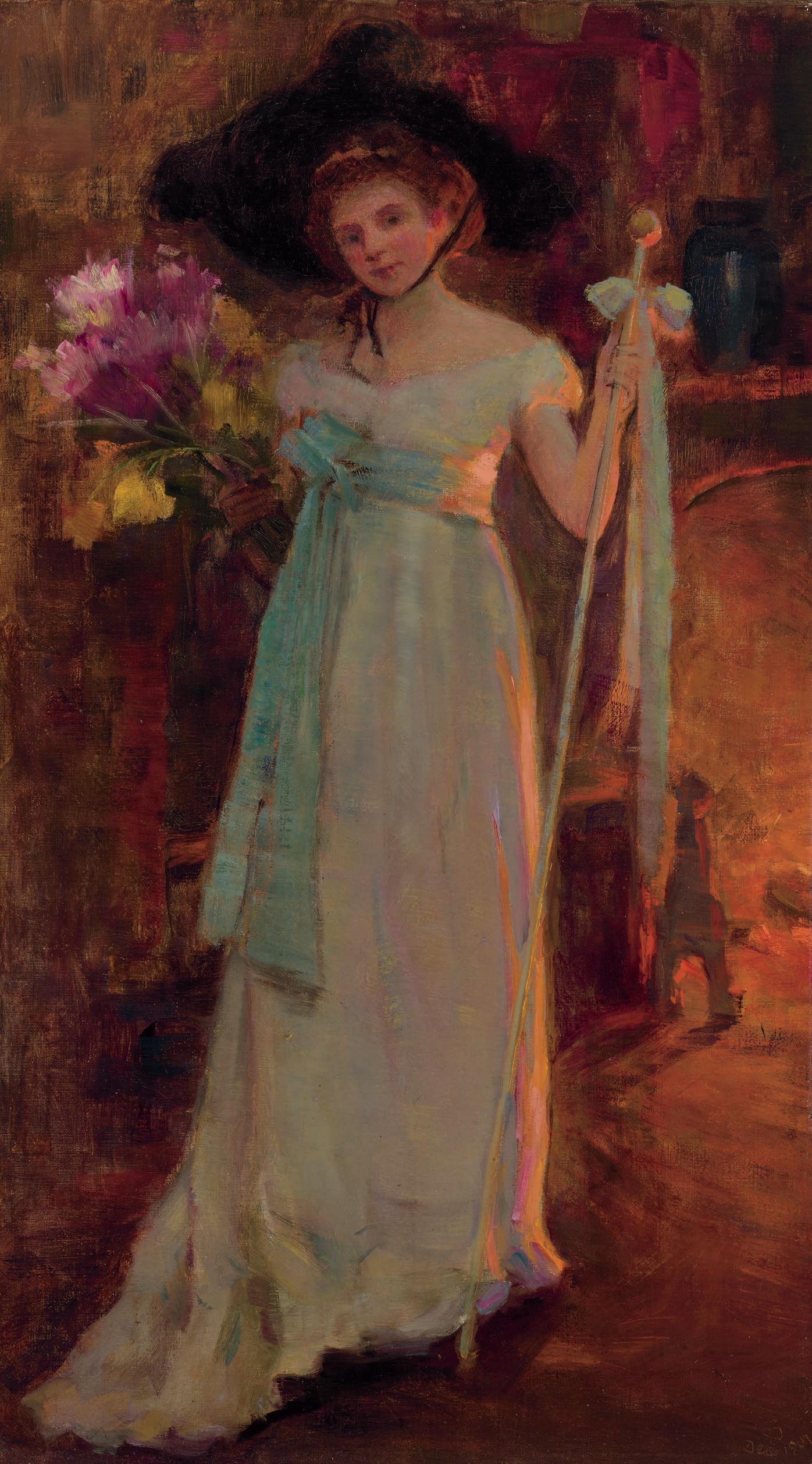
An exhibition of Sophie Pemberton’s work entitled Unexpected: The Life and Art of Sophie Pemberton, Canadian Artist, guest curated by Kathryn Bridge, will take place at the Art Gallery of Greater Victoria from September 2023 to January 2024.
e stimate: $ 15,000 – 25,000
24
Bridge oil on canvas, signed and on verso signed 16 1/4 × 22 in, 41.3 × 55.9 cm
p rovenan C e
Collection of the Artist
By descent to the present Private Collection, Winnipeg
R EGINA S EI d EN STU d IE d under William Brymner and Maurice Cullen at the Art Association of Montreal, and she continued her studies in Paris at the Académie Julian, from 1921 to 1922. During this time, she traveled through Europe to locations such as Venice to visit museums and paint. This delicately atmospheric painting of a picturesque bridge across a river is an accomplished work. Its close tonal values of the sky and the water’s surface, along with the promenade on the right, painted with soft, scumbled brushstrokes, bring a sensitivity to this city scene.
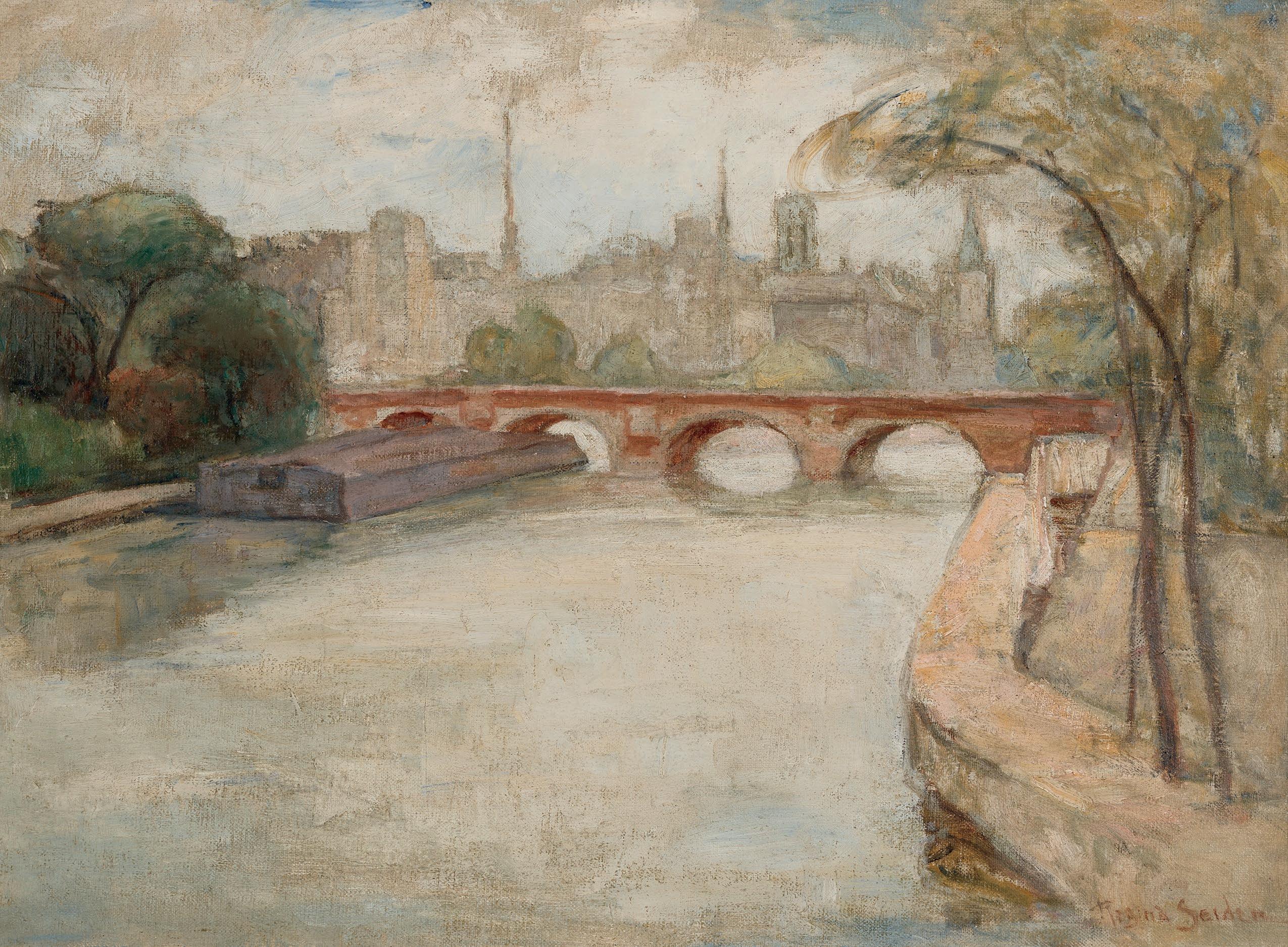
Seiden was affiliated with Montreal’s Beaver Hall Group, exhibiting with them in their 1921 and 1922 exhibitions. In 1924, she showed at the influential British Empire Exhibition in Wembley, England. She was also a member of Montreal’s Contemporary Arts Society. The National Gallery of Canada was an early supporter, acquiring three of her paintings. In 1928, she married well-known artist Eric Goldberg and, as she became involved with supporting his career, stopped painting. But she taught art at the couple’s Westmount synagogue for 20 years. Seiden’s contributions to early modernism have been recognized in recent years in the 2016 exhibition 1920s Modernism in Montreal: The Beaver Hall Group, at the Montreal Museum of Fine Arts, which traveled across the country, causing the work of this accomplished artist to be re-examined with renewed appreciation.
e stimate: $ 15,000 – 20,000
25
112 Regina Seiden
CAS 1897 – 1991

26
113 James Wilson Morrice
CAC RCA 1865 – 1924
Young Girl in Capri
oil on canvas on board, on verso titled Young Girl in Venice on the Continental Galleries label, inscribed M 121 faintly and stamped F.R. Heaton Estate
13 1/8 x 8 in, 33.3 x 20.3 cm
p rovenan C e
W.M. Scott & Sons, Montreal
Estate of F.R. Heaton
Continental Galleries of Fine Art, Montreal
Important Canadian Art and Fine Jewellery, Sotheby’s Canada, May 27, 1985, lot 767
Acquired from the above by a Private Collection, USA
l iterature
G. Blair Laing, Memoirs of an Art Dealer 2 , 1982, a circa 1902 drawing entitled A Brittany Girl reproduced plate 25, page 68
P ORTRAIT OR MO d E l studies by James Wilson Morrice, better known for his atmospheric landscapes, count for less than seven per cent of his total ouput, and their appearance on the market is rare. The artist produced them in bursts of creativity rather than consistently. And it is almost by chance, during his first trip to Italy, that he started to paint people from a close-up point of view, an interest perhaps ignited by a young woman who, we guess, traveled with him. She appears in both Venice and Capri, as well as in France, with her hair worn in a tight bun attached high at the back. Unfortunately, we do not know her name or nationality, not even exactly what she looked like—we see her only from the back, in profile, or in three-quarter views.
Morrice’s other models were mostly children, quickly drawn in the two sketchbooks he brought with him (one dispersed, one still intact); they wear the local costume—a blouse and skirt, plus an apron and a scarf crossed over the bust. One girl in particular, aged about ten, got the artist’s attention, and he painted her first standing at a belvedere (in a private collection) and twice sitting in a matching reddish-brown blouse and skirt, framed by the local vegetation (a flowering shrub at left, an intertwined vine at right). One of these works, Seated Girl in a Brown Blouse (private collection, Joyner, May 15, 1990) shows her in profile, in a three-quarter view, while our portrait focuses on her face, rendered very softly and tenderly. She is also the subject of a delicate close-up, drawn on a detached sheet from the dispersed sketchbook, titled A Brittany Girl, reproduced in the G. Blair Laing book Memoirs of an Art Dealer 2
In Young Girl in Capri, the girl sits in the shade; in the profile version, Seated Girl in a Brown Blouse, there is more space between her and the pale yellow background. Thanks to an 1890 painting by Marie Egner, A Cloister in Capri, with a similar but complete decor, we can imagine her on the steps leading up to the walkway of a pergola, a very common feature on the Isle of Capri. Many visiting artists enjoyed painting people sitting under their flowering canopies among thick columns, but not Morrice, who was more interested in focusing on the girl who had captured his attention. A Venetian address in the intact sketchbook
(Montreal Museum of Fine Arts, Dr.1973.35, end page) dates the drawings from before or early in 1895; because of this, and on stylistic grounds, we currently date the Italian trip to 1894. A careful study of the Italian drawings and paintings suggests that, very early in that spring, Morrice left his home in Paris for Venice. The weather was still cold under grey skies, so he crossed over via Naples to Capri, where he stayed long enough to witness the greening of the trees. Perhaps too long, since he never went back, while he did return at least six more times to Venice, but always in summer
We thank Lucie Dorais for contributing the above essay. This work will be included in Dorais’s forthcoming catalogue raisonné of the artist’s work.
e stimate: $ 40,000 – 60,000
27
ALC CGP G7 OSA RCA RSA 1882 – 1974
Gaspé / Georgian Bay (verso)
double-sided oil on board, signed, circa 1936
10 1/2 × 13 1/2 in, 26.7 × 34.3 cm
p rovenan C e
Private Collection, Winnipeg
T HIS d OUB l E - SI d E d A .y. JACKSON painting depicts two geographically separate areas—Gaspé in Quebec and Georgian Bay in Ontario. When on sketching trips, Jackson would sometimes run out of panels and, wanting to continue, would paint the verso. In March of 1936, Jackson was sketching in Fox River, Gaspé, and in October of that same year, at Go Home Bay, on Georgian Bay. Only a few shreds of snow remain in Gaspé, as the town is released from the grip of winter. Jackson’s painting is all about rhythm—rolling ground, buildings that follow the lay of the land, a curving bay and undulating hills. The panoramic view over the bay to the mountain wrapped in cloud is splendid.
Jackson had a long history with Georgian Bay; he first went there in 1910 and often returned throughout his life during the

28
114 Alexander Young (A.Y.) Jackson
summer to this unique landscape, canoeing, camping and painting its rock outcroppings, hills and islands. This view depicts sculpted hills, bare tree trunks and a gnarled, fallen tree under a moody sky. Low-growing vegetation, turned red by autumn, points upward like flames, while in the centre small evergreens and gold touches add further notes of vivacity to the landscape. Both paintings are fine examples of two painting places that were important to Jackson. He explored Canada from coast to coast, and wherever he went, he distilled the essence of every landscape he painted.
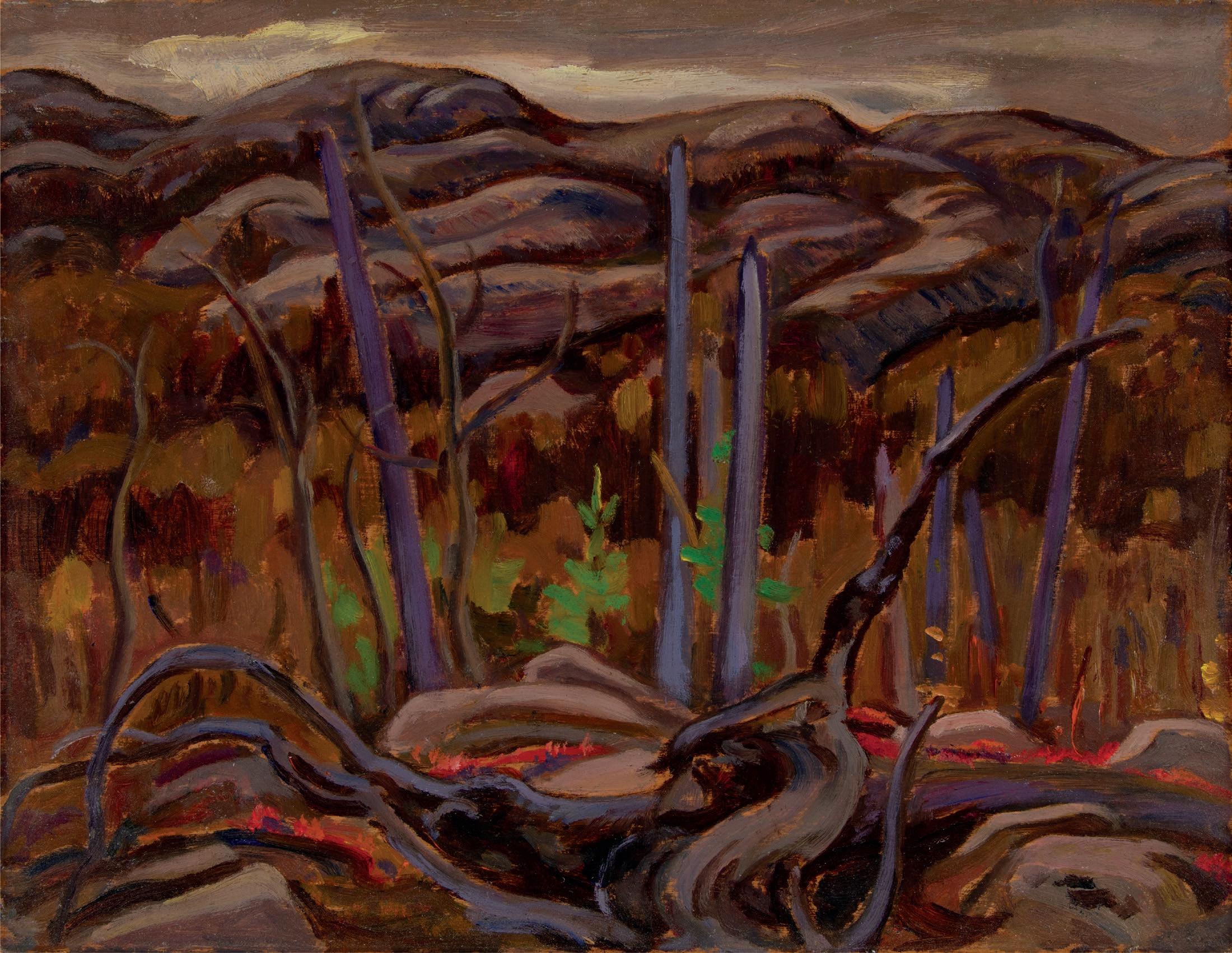
Please note: this work is framed so both sides can be displayed.
e stimate: $ 25,000 – 35,000
29
verso lot 114
115 James Edward Hervey (J.E.H.) MacDonald
Summer Morning, Lake Simcoe
oil on board, initialed and dated 1919 and on verso signed, titled and inscribed $ 30.00 and Studio Bldg. on the artist’s label
8 1/2 × 10 1/2 in, 21.6 × 26.7 cm
p rovenan C e
Private Collection, Vancouver
By descent to the present Private Collection, Vancouver
J.E.H. M ACdONA ld IS known to have made several trips to Lake Simcoe, north of Toronto, in the period just after the First World War. While living in Thornhill, he would have traveled by the electric tram that ran from Toronto to the east shore of the lake. While there, he visited Roches Point, an exclusive neighbourhood
with large estates, painting gardens and sky-filled views across the lake, such as Lake Simcoe, 1920, in the collection of the National Gallery of Canada.
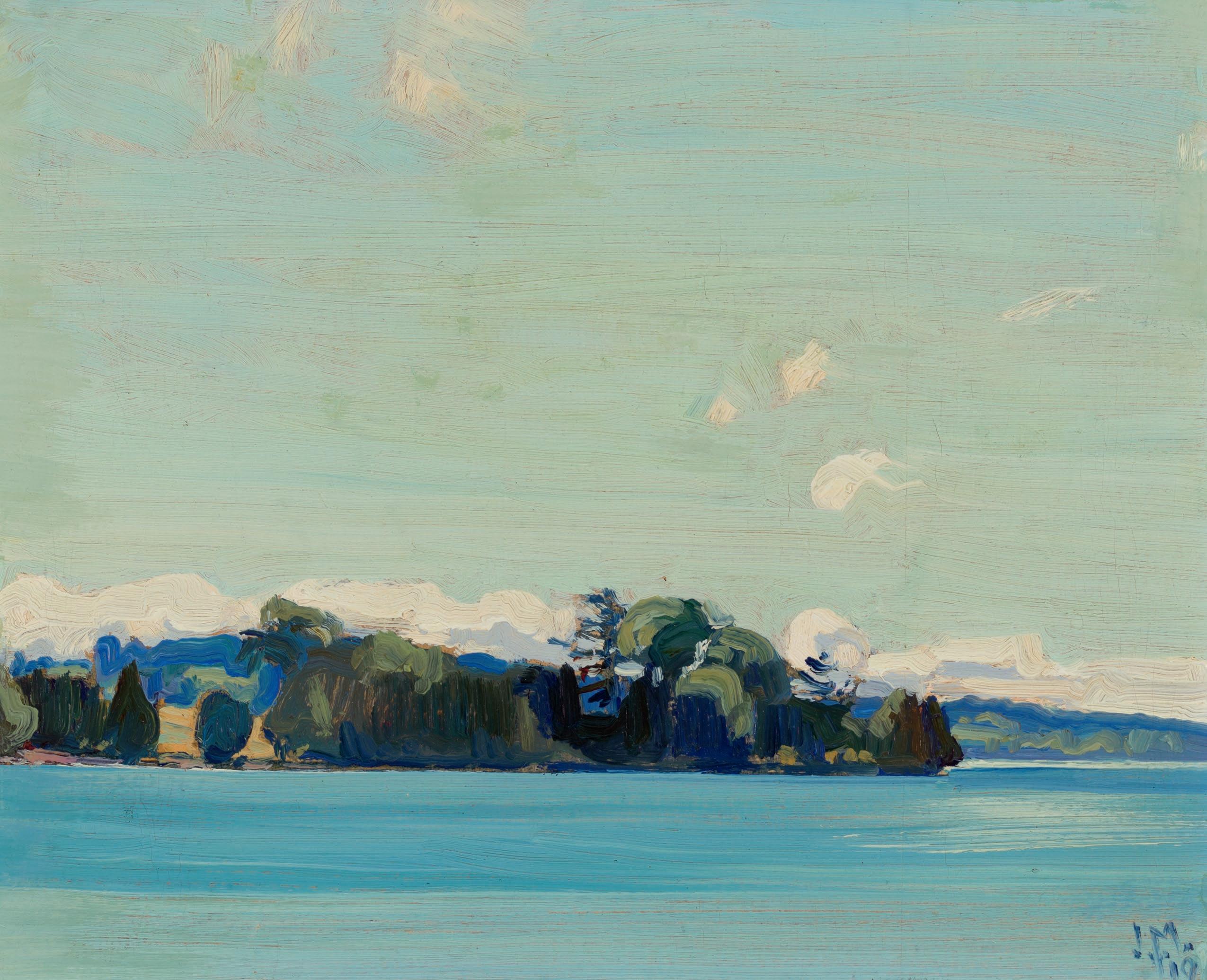
This work was painted in the summer of 1919, before MacDonald’s participation in the fall Group of Seven boxcar trip to Algoma. In this fresh and alluring oil sketch, MacDonald expertly captures the dreamy feeling of a sunny day radiant with light. The artist’s brushwork is masterful—sky and water are laid down with long horizontal strokes, while landforms are depicted fluidly and simply. With its open expanses of water and sky, this painting, considered without reference to its size, appears larger in scale than it actually is. The white cumulus clouds rising up over the hills, the illuminated golden meadow seen through the trees, and the small puffy clouds floating in the sky all contribute to the soothing atmosphere of reverie in Summer Morning, Lake Simcoe
e stimate: $ 30,000 – 50,000
30
G7 OSA RCA
ALC CGP
1873 – 1932
116 Frank Hans (Franz) Johnston
ARCA CSPWC G7 OSA 1888 – 1949
Summer Clouds—Lake of the Woods oil on board, signed and dated 1922 and on verso titled Summer Clouds, Lake of the Woos [sic] and inscribed

Six miles from Ont. Painted on warm July afternoon
by Franz Johnston ARCA / Castles / $ 80.00 / 458 A
10 3/8 × 13 in, 26.4 × 33 cm
p rovenan C e
Private Collection, Ontario
I N 1921 , fRANK JOHNSTON left Toronto to take a position as principal of the Winnipeg School of Art and director of its art gallery. At that time he was still a member of the Group of Seven— he did not formally leave them until 1924. During this pivotal period, Johnston began to evolve away from the Group influence,
to a more natural, realistic style. These changes would inform his painting for the rest of his life. While in Winnipeg, the Johnston family rented a cottage every summer on the shores of Lake of the Woods, on the Ontario-Manitoba border. Artist Lemoine FitzGerald was just across the bay, and the two artists showed each other their art and exchanged ideas. It was a beautiful area, and this oil captures Johnston’s sensitive response to it in his exquisite treatment of the billowing cumulus clouds with delicate hues of mauve and cream, and the tranquil lake lapping at the wooded shore. The contrast between the dark-green reflections of the trees appearing to sink into the depths of the lake and the light-filled blues of water and sky is superbly handled. The painting is a shining summer moment suspended in time, emanating peace.
e stimate: $ 20,000 – 30,000
31
117 Alexander Young (A Y.) Jackson
ALC CGP G7 OSA RCA RSA 1882 – 1974
Georgian Bay
oil on canvas, signed and dated 1920 and on verso titled and dated on the gallery label 25 × 32 in, 63.5 × 81.3 cm
p rovenan C e
Acquired directly from the Artist
Mr. P.R. Hilborn, Ottawa
By descent within the family
Canadian Art, Joyner Fine Art, December 4, 2001, lot 50, titled as April, Georgian Bay
Galerie Walter Klinkhoff Inc., Montreal Private Collection, California
l iterature
Charles C. Hill, The Group of Seven: Art for a Nation, National Gallery of Canada, 1995, page 117 for photographs of the 1920 exhibition at the Worcester Art Museum, Massachusetts
e xhibited
Worcester Art Museum, Massachusetts, Paintings by the Group of Seven Canadian Artists, November 7 – 28, 1920, traveling in
1920 – 1922 to Boston, Rochester, Toledo, Indianapolis, Detroit, Cleveland, Buffalo, Columbus, Minneapolis and Muskegon, Michigan
Art Gallery of Toronto, A.Y. Jackson: Paintings, 1902 – 1953 , October – November 1953, and the National Gallery of Canada, Ottawa, December – January 1954, catalogue #30(a)
A.y. J ACKSON ’ S PAINTING of an early spring day on Georgian Bay is a vision of renewal. It belongs to a pivotal series of canvases that Jackson worked up from sketches painted in Muskoka between February and April 1920. This period marked the artist’s re-engagement with wilderness as a subject following a four-anda-half-year hiatus of military service during World War I—first as a private in the Canadian infantry, and subsequently as a war artist for the War Records unit under Lord Beaverbrook. Georgian Bay was among the first works the artist painted following the formation of the Group of Seven in March 1920. It would be included in the Group’s inaugural international exhibition, held at the Worcester Art Museum in Massachusetts in November 1920, which followed close on the heels of the Group’s premiere presentation at the Art Gallery of Toronto in May of the same year. Hanging alongside Tom Thomson’s painting The West Wind (1916 – 1917), Georgian Bay would help to define the Group for American viewers as the Worcester show went on tour to cities including Boston, Detroit and Minneapolis through 1922.

32
In his autobiography, Jackson wrote that he had spent the winter of 1920 attempting “to regain the excitement which had sustained me in the months before the war.” 1 Following harrowing years as a witness to conflict overseas, Jackson hoped to regain his bearings as a painter of northern landscapes in the island-studded Cognashene archipelago, where he had sketched some of his pre-war works. Staying in Franceville on Georgian Bay, Jackson revisited the Precambrian landscape that had inspired Terre Sauvage (1913), a work he later dubbed “the first large canvas of the new movement.” 2
Though not yet formalized as the Group of Seven, a nascent national landscape movement was beginning to coalesce around J.E.H. MacDonald and Lawren Harris by 1913. In that year, MacDonald had written to Jackson, then based in Quebec, on behalf of Harris, who was interested in acquiring Jackson’s early masterpiece The Edge of the Maple Wood (1910). After meeting with Harris and MacDonald as well as Arthur Lismer and Frederick Varley, Jackson was convinced to stay on in Toronto, where he was offered space in the Studio Building that Harris was in the process of constructing in the Rosedale Valley in partnership with Dr. James MacCallum, an ophthalmologist and visionary patron of the arts. As he had previously done for MacDonald, MacCallum agreed to subsidize Jackson’s expenses for a year, freeing him to paint full time. While staying at MacCallum’s cottage on West Wind Island that summer, Jackson completed sketches for Terre Sauvage. Back in Toronto, Terre Sauvage was worked up on canvas in Harris’s studio at Yonge and Bloor just prior to the completion of the Studio Building. An enthusiastic witness to its execution was Tom Thomson, a protégé of MacDonald’s at Grip Ltd., and a soon-to-be fellow beneficiary of MacCallum’s patronage.

Georgian Bay recaptures the optimism of the rainbowed landscape of Terre Sauvage, whereas other works produced by a war-traumatized Jackson in the same period amounted to a continuation of his war paintings. “Nature had become a field of battle, glimpsed as though after some terrible shelling, with more yet in store,” Douglas Hunter observes.3 The blackened tree stumps of October Morning, Algoma (1920), based on sketches produced during a railway trip to the scenic region north of Sault Ste. Marie organized by Harris in the fall of 1919, are notably absent from Georgian Bay. After struggling for months to rekindle his desire to paint following his discharge from the army in April 1919, on the Algoma expedition Jackson “got enthused again and worked quite hard,” as he wrote to critic and photographer Harold Mortimer-Lamb.4 Georgian Bay is evidence of continued progress in the artist’s post-war recovery: the oppressive atmosphere of works such as March Storm, Georgian Bay (1920) has cleared, revealing patches of blue sky and placid waters that glow like a polished gemstone.
We thank Adam Lauder for contributing the above essay. Lauder is an art historian based in Toronto and an instructor at the University of Toronto and Ontario College of Art and Design.
1. A.Y. Jackson, A Painter’s Country: An Autobiography of A.Y. Jackson (1976; repr., Toronto; Vancouver: Clarke, Irwin, 1958), 51.
2. Ibid., 31.
3. Douglas Hunter, Jackson’s Wars: A.Y. Jackson, the Birth of the Group of Seven, and the Great War (Montreal: McGill-Queen’s University Press, 2022), 356.
4. Quoted in Hunter, Jackson’s Wars, 348.
e stimate: $ 250,000 – 350,000
33
Installation views of Paintings by the Group of Seven Canadian Artists, Worcester Art Museum, November 1920, with Georgian Bay indicated
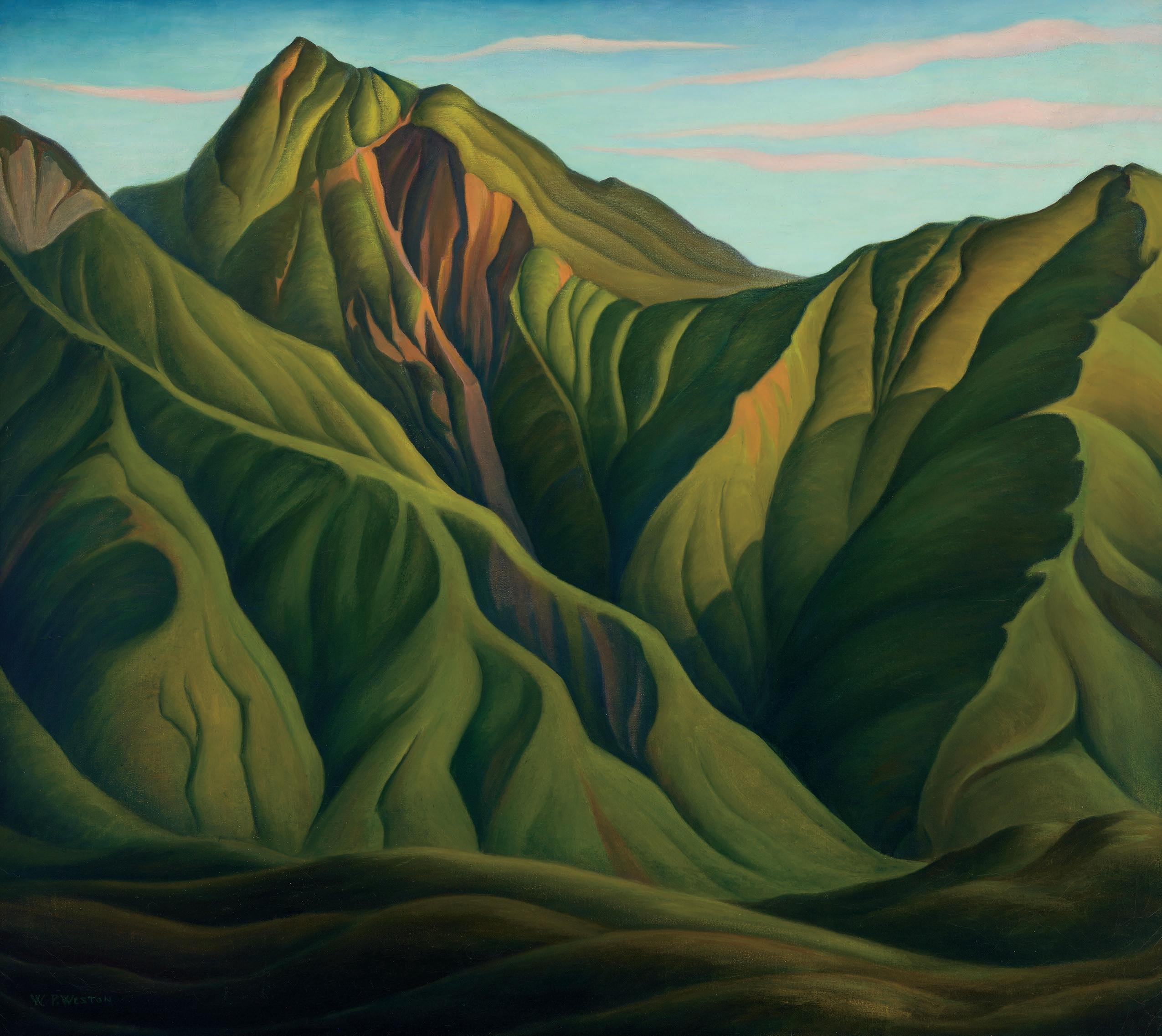
34
118 William Percival (W.P.) Weston
ARCA BCSFA CGP RBA 1879 – 1967
Red Mountain New Denver
oil on canvas, signed and on verso signed, titled and inscribed 1419 Dogwood Ave, Vancouver, B.C., 1947
33 3/8 × 37 1/8 in, 84.8 × 94.3 cm
p rovenan C e
Collection of the Artist
By descent to the present Private Collection, British Columbia
l iterature
Letia Richardson, Silence and Solitude: The Art of W.P. Weston, Richmond Art Gallery, 1993, pages 13 and 14
e xhibited
Art Association of Montreal, Canadian Group of Painters, 1948
Western Canada Art Circuit Travelling Exhibition, 1948
Montreal Art Gallery, Canadian Group of Painters, 1949 Vancouver Art Gallery, Second Quarterly Group Exhibition, October 31 – November 19, 1950, catalogue #16
W I ll IAM W ESTON ARRIVE d in Vancouver from London in 1909 and soon became an important figure on the early Vancouver art scene—as an artist and art educator. The year before this work was painted, 1946, Weston retired from teaching at the Provincial Normal School in Vancouver, giving him more freedom to paint. That same year, he was given a one-person retrospective at the Vancouver Art Gallery; at that time, he was only the third artist to be so honoured, after Fred Varley and Emily Carr.
One of Weston’s important themes was the mountains of British Columbia, whether in summer, as in Red Mountain—New Denver, or in winter, covered with glaciers and snow. Weston was aware of Lawren Harris and his abstractions of mountains, but he differed from Harris in that he depicted specific locations and wanted “to keep something of the character of the mountain,” as he said. Letia Richardson wrote that “Weston’s strength was his ability to create an attractive beautiful environment and a scene of omnipotence and fear.” This is a stunning summer portrait of this mountain in the West Kootenay region, its verdant slopes cloaked in green. Shadowed fissures crease its sides, increasing the sense of its sculpted mass. Red Mountain towers before us, remote and unknowable, creating a sense of awe with its stark power.
e stimate: $ 30,000 – 40,000
35
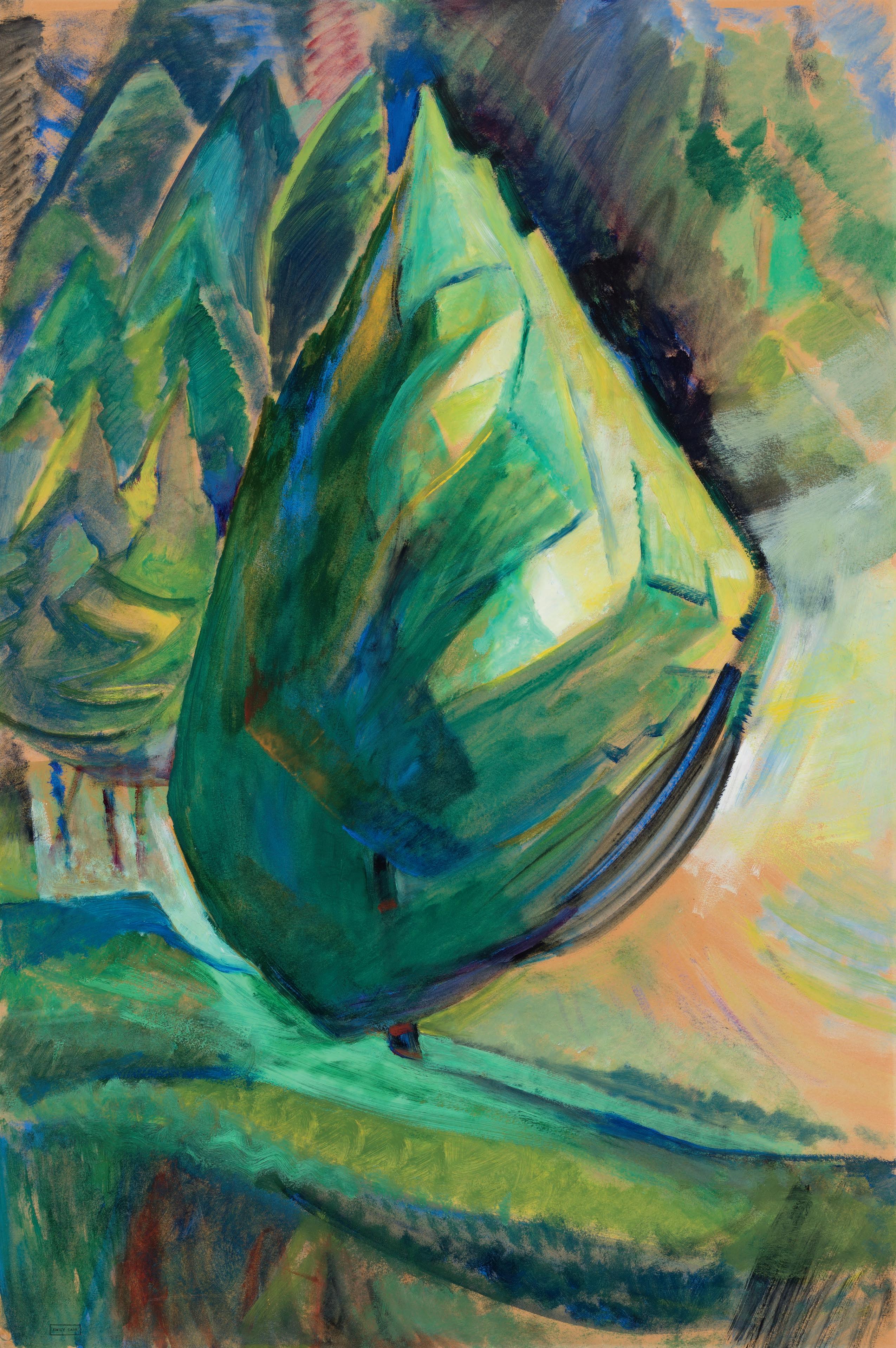
36
119 Emily Carr
BCSFA CGP 1871 – 1945
Glorious Tree oil on paper, signed with the estate stamp and on verso inscribed CH 206 and CH , circa 1932
36 × 24 in, 91.4 × 61 cm
p rovenan C e
Acquired directly from the Estate of the Artist, circa 1950
By descent to the present Private Collection, Victoria
A T f IRST G l ANCE the painting Glorious Tree reveals a young tree bursting with life and colour. The tree stands out against the dark forest behind it, illuminated from the right. The forest and the slope on which the tree grows are quickly and sketchily rendered, while the volume of the tree is emphasized by bold strokes of colour that curve into almost geometric forms. The painting is striking and memorable for its joyous, vibrant colour and the speed and boldness with which Emily Carr has pinned down an inspired thought.
This sketch also tells a deeper story about a little-known aspect of Carr—her intense period of stylistic experiment during the years 1928 to 1933. In 1927, at a time when her career had faltered from a lack of local support, Carr was suddenly hailed as a colleague by the Group of Seven, then Canada’s controversial modernist group, when her work was shown at the National Gallery of Canada in Ottawa.1 Her acceptance into the national art scene came because of her 1912 Post-Impressionist paintings recording Northwest Coast First Nations villages and their carvings, which were now being appropriated as a Canadian national heritage. When she made a new series of paintings after her return journey through Indigenous territories on the North Coast, she harmonized the landscape settings into which she placed the poles with the curving lines and abstracted forms of the Indigenous carving style. We see this in her famous canvases such as Kitwancool Totems, 1928, and Church in Yuquot Village (previously titled Indian Church), 1929, which she later sent for exhibition alongside the Group of Seven in Toronto.2

When Carr’s mentor and friend Lawren Harris urged her to move away from dependence on Indigenous subjects and to find her own vision of the landscape, she faced a huge challenge. A.Y. Jackson, for one, pronounced the coastal rain forest unpaintable.3 Carr embarked on prolonged research through exploratory drawings and studies of tree forms and of landscape configurations in pencil, charcoal, watercolour, and black and white brush painting. She did not exhibit these works, but used them to gain a grasp of the vastness of the coastal landforms and the distinctive growth patterns of its trees, and to give her paintings an ever greater expressive force. Her first pure landscapes done in 1929 to 1930 were of trees grouped within monumental and mysterious forest interiors.4 She drew stylistic inspiration from Harris’s calm vistas filled with a spiritual light and from the cubistic experiments of Mark Tobey, as well as from numerous books on modern painting.5 These monumental forest interiors were impressive and well received at exhibitions in the East, although, with the Crash of 1929 and ensuing Great Depression, she garnered almost no sales. Her continuous thoughtful and searching creative process would find its culmination by 1935 in the
confident, free-flowing, lyrical paintings that make her arguably the most adventurous and convincing modern artist of the 1930s in Canada.6
Where does Glorious Tree fit into this development? By January 1931, Carr was questioning the sombre, sculptural treatment of her forest landscapes. She noted in her journal, “My aims are changing and I feel lost and perplexed. I’ve been to the woods today. It’s there but I can’t catch hold.” Six days later she wrote: “I have done a charcoal sketch today of young pines at the foot of a forest. I may make a canvas out of it. It should lead from joy back to mystery—young pines full of light and joyousness against a background of moving mysterious forest . . . Oh Spring! I want to go out and feel you and get inspiration. My old things feel dead. I want fresh contacts, more vital searching.” 7
During the course of 1931, Carr explored this new motif of young pines at the edge of a forest through drawings like the charcoal Untitled in the collection of the Vancouver Art Gallery (figure 1). She had come to realize that she needed a guiding idea to make a compelling picture. As she wrote: “First there must be
37
f igur E 1: e mily Carr Untitled charcoal on paper, 1930 – 1931 24 ½ x 19 in, 62.6 x 48.2 cm Collection of the Vancouver Art Gallery, Emily Carr Trust, VAG 42.3.121
Not for sale with this lot
an idea, a feeling, or whatever you want to call it, the something that interested or inspired you sufficiently to make you desire to express it. Maybe it was an abstract idea that you’ve got to find a symbol for, or maybe it was a concrete form that you have to simplify or distort to meet your ends, but that starting point must pervade the whole.” 8
As Carr pursued this direction, the single tree emerged as a key symbol in her work. She was familiar with the theme of the heroic tree in the work of the Group of Seven, from Tom Thomson’s celebrated Jack Pine to Frederick Varley’s and Arthur Lismer’s pines struggling against the westerly winds of Georgian Bay.9 During her sketching trip to Goldstream Park in September 1931, Carr often placed one of the mighty cedar trunks as a central feature, where earlier she would have placed a totem pole. And she developed the motif of the young pine tree in works such as The Little Pine, 1931 (figure 2), another canvas that she sent off to exhibit with the Group of Seven in December 1931.10
Carr’s oil on paper sketch Glorious Tree bears a strong resemblance to The Little Pine, but in certain ways it pushes her experiments further. In The Little Pine the young tree is the central protagonist, but within a coordinated landscape scene made up of equally finished contrasting elements, overlapping in an orderly recession. But Glorious Tree has a far more dramatic presence. Carr makes the tree vivid by the daringly simplified rendering of its volume, imparting a sense of life and movement. Her oil on paper sketch revels in the pleasure of colour and creates its unity through the repetition of triangular forms.
Glorious Tree thus seems less a preparation for the 1931 painting than a revision, as Carr seeks a more direct statement of her experience of a young tree. The sketch invites comparison with another painting of a single tree, the 1932 canvas Grey (figure 3). Carr’s sketching companion at the time, Edythe Hembroff-Schleicher, records seeing Grey on Carr’s easel in that year, and says it was based on Forest Interior, one of the oil on paper sketches that Carr made as they worked together at an old hunting lodge up on Braden Mountain in the Sooke Hills in May of 1932.11
The compositions of all three works are very similar but the mood in Grey and in Glorious Tree could not be more different. Grey evokes a contemplative hush. The young tree, illuminated from within, stands contained within the protective shelter of the forest’s depths. Its sculptural forms look back to Carr’s work of 1928 to 1929, when she most closely emulated Harris. Could Grey be a last homage to Harris, whom she considered her most significant mentor? Glorious Tree, in contrast, is an explosion of colour and light. When writing the first draft of her autobiography, Carr looked back at their relationship: “I wanted to get hold of something in his work that mine lacked, a bigness behind it. I did not want to paint like him. I never could because in ourselves our natures were so different. He was calm where I was all turbulence and eruption.” 12
With Glorious Tree that turbulence is unleashed and controlled, as Carr discovers a glimpse of the divine illumination she would seek and find in 1933, when her purchase of a caravan enabled her to immerse herself totally in the skies and woods of the Vancouver Island shoreline. Glorious Tree shows the full power of the new technique of sketching in oil on paper that she perfected in

38
f igur E 2: e mily Carr
The Little Pine oil on canvas, 1931 44 x 27 in, 111.6 x 68.7 cm Collection of the Vancouver Art Gallery, Emily Carr Trust, VAG 42.3.14
Not for sale with this lot
1932, and heralds the outpouring of spontaneous feeling that would characterize her outstanding late works.13
We thank Gerta Moray, Professor Emerita, University of Guelph, and author of Unsettling Encounters: First Nations Imagery in the Art of Emily Carr, for contributing the above essay.
Glorious Tree was acquired directly from the Estate of Emily Carr and has remained within the same family for over 70 years.
1. Carr visited Ottawa and Toronto for the National Gallery Exhibition of Canadian West Coast Art: Native and Modern, which introduced her to the national scene.
2. Kitwancool Totems (Hart House, University of Toronto) was shown at the Ontario Society of Artists’ annual show in March 1928, while Church in Yuquot Village (original title Indian Church, Art Gallery of Ontario) was selected by Lawren Harris and A.Y. Jackson for the exhibition of contemporary Canadian artists mounted by the American Federation of Arts in Washington, d C . See Edythe Hembroff-Schleicher, Emily Carr: The Untold Story (Saanichton, BC : Hancock House, 1978), 349 and 371.
3. In her draft autobiography Carr quotes Jackson as writing: “It is unfortunate you are so far away from everything out there. I have seen that country and realize how unpaintable it is with its density of trees & Undergrowth,” and gives her own response as “Pity me would he! . I’ll show those Easterners.” See Emily Carr, Unvarnished: Autobiographical Sketches by Emily Carr, ed. Kathryn Bridge (Victoria: Royal BC Museum, 2021), 110.
4. Examples include Wood Interior, 1929–33 (collection of Robert McLaughlin Gallery, Oshawa), and Western Forest, circa 1929–30 (collection of Art Gallery of Ontario).
5. Carr’s stylistic borrowings and development have been discussed in detail by Doris Shadbolt in Emily Carr (Vancouver: Douglas & McIntyre, 1990), 45–63.
6. Harris’s move into abstraction was made only after he left Canada for the USA in 1934.
7. Emily Carr, Hundreds and Thousands: The Journals of Emily Carr (Toronto: Clarke, Irwin, 1966), 24–25, entries for January 12 and 18, 1931.
8. Ibid., 25, entry for January 28, 1931.
9. Carr had seen work by members of the Group in person on visits to Toronto in 1927 and 1930, and reproduced in Fred Housser, A Canadian Art Movement: The Story of the Group of Seven (Toronto: Macmillan, 1926).
10. Other examples are A Young Tree and Sea Drift at the Edge of the Forest (collection of the Vancouver Art Gallery). Carr made many images of single cedar trees during her sketching trip to Goldstream Park in September 1931, for example Untitled (cedar tree), 1931, charcoal, VAG collection. See Shadbolt, Emily Carr, 168.
11. The sketch was bought from Carr by a friend and UBC colleague of Hembroff’s husband. See Hembroff-Schleicher, Untold Story, 127.
12. Carr, Unvarnished, 113.
13. Hembroff-Schleicher, Untold Story, 78. It is noteworthy that Carr began to send her oil on paper sketches mounted for public exhibition in the following year. Carr, Hundreds, 61–62, entry for September 26, 1933.

e stimate: $ 200,000 – 300,000
Not for sale with this lot
39
f igur E 3: e mily Carr Grey oil on canvas, 1932 44 x 27 1/2 in, 111.8 x 69.9 cm Private Collection
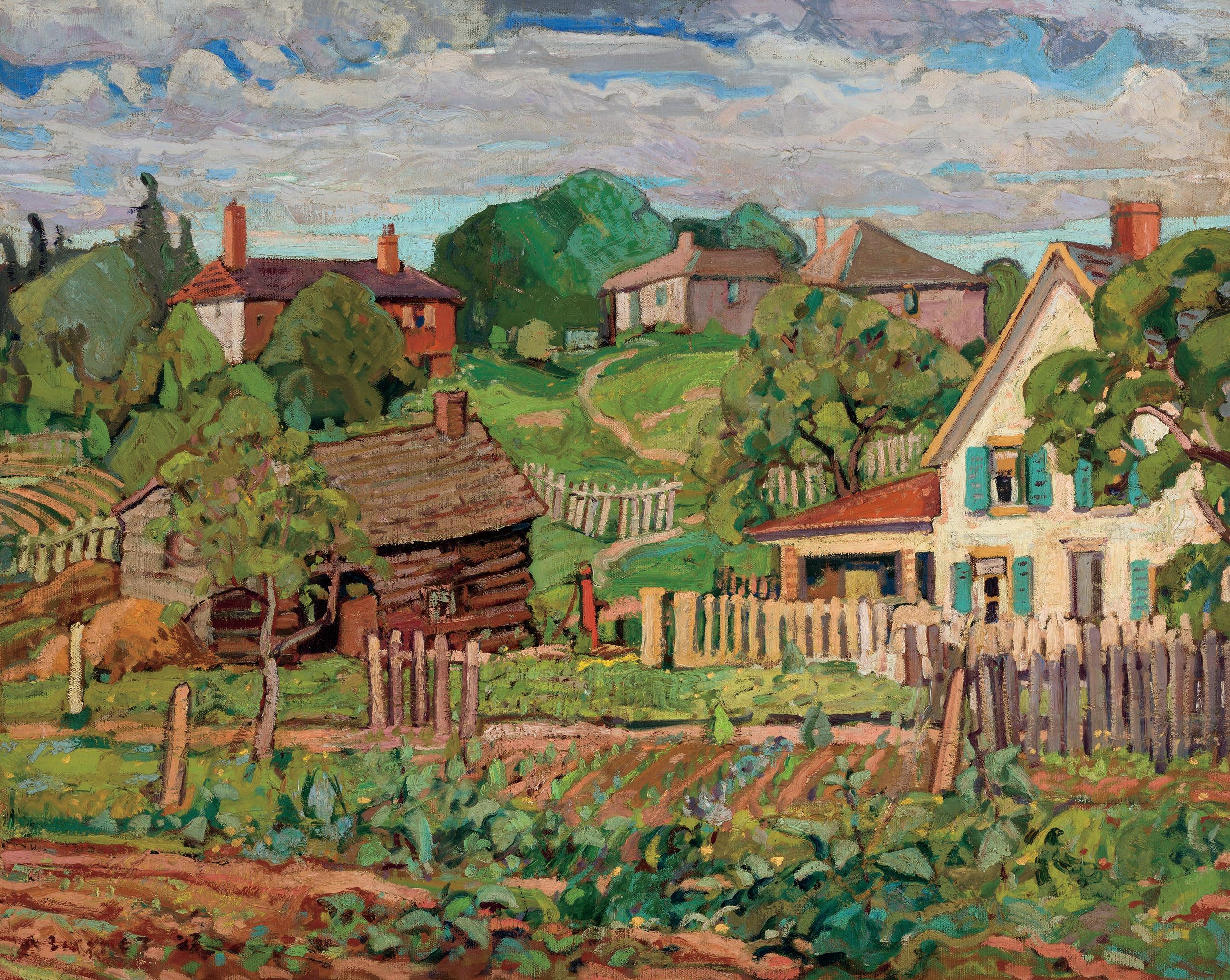
40
120 Arthur Lismer
AAM CGP CSGA CSPWC G7 OSA RCA 1885 – 1969
An Ontario Village (Meadowvale)
oil on canvas, signed and dated 1923 and on verso titled Meadowvale and titled on a label and inscribed $ 1,500
32 × 40 in, 81.3 × 101.6 cm
p rovenan C e
Laing Galleries, Toronto
Acquired from the above by a Private Collection, Toronto, March 21, 1959
By descent to the present Private Collection, Toronto
l iterature
Evelyn de R. McMann, Royal Canadian Academy of Arts / Académie royale des arts du Canada: Exhibitions and Members, 1880 – 1979 , 1981, page 241
e xhibited
Art Gallery of Toronto, Royal Canadian Academy of Arts, November 22, 1923, titled as Ontario Village, catalogue #103
Art Gallery of Toronto, Summer Exhibition, May 24 – August 16, 1924, titled as An Ontario Village, catalogue #100 Montreal Museum of Fine Arts, Arthur Lismer Exhibition, June 14 – July 9, 1950, titled as Ontario Village, catalogue #5 Laing Galleries, Toronto, Retrospective Exhibition: Arthur Lismer, March 14 – 31, 1959
T HE E NG l ISH - BORN ARTIST Arthur Lismer arrived in Toronto in January 1911, following studies in Sheffield and Antwerp. He soon found work with the graphic design firm Grip Ltd., where he met J.E.H. MacDonald, Tom Thomson, Frank Johnston and Franklin Carmichael. He quickly became a noted figure in this community of emerging Toronto artists, showing in the annual exhibitions of the city’s art societies while working as a freelance illustrator for a variety of publications. His work appeared frequently in the pages of the Canadian Courier, edited by Augustus Bridle, a fellow member of the Arts and Letters Club, where Lismer was an active participant in art and theatre projects. He first painted on Georgian Bay in September 1913 and with Thomson in Algonquin Park the following spring, and with A.Y. Jackson, Thomson and Frederick Varley in the fall of 1914. This last, joint sketching expedition played out against the backdrop of the outbreak of a war that would be devastating for Toronto’s graphic artists. Without work, Lismer and his wife and daughter moved north of Toronto to Thornhill, where they briefly lived with MacDonald and his family during the summer of 1915. Lismer painted two canvases of the garden behind his John Street house in Thornhill in different seasons: Winter Sunshine, 1916 (now titled Afternoon Sunlight, Thornhill) and Springtime on the Farm of 1917 (both in the collection of the Montreal Museum of Fine Arts). These intimate renderings of rural subjects sparkle with a brilliantly fresh, clear blue light.
A job opportunity directing the Victoria School of Art and Design brought the Lismers to Halifax in the fall of 1916. This was a productive period for the artist, in spite of the destruction wrought by the explosion of December 6, 1917. Hired in June 1918 by the committee of the Canadian War Memorials Fund to document wartime Halifax, Lismer produced some of the finest paintings and prints in the collection. However, a visit from Jackson, newly returned from military service in England, aggravated Lismer’s frustration with the lack of response to his efforts in Halifax. In April 1919, he received an offer to take on the job of vice-principal of the Ontario College of Art and returned to Toronto in August.
The post-war years saw a renewed flowering of the Canadian art movement in joint sketching trips to Algoma and the formation of the Group of Seven in the spring of 1920. Lismer was, of course, a charter member, and he returned to Georgian Bay to paint that summer. The rocks, islands, trees and water of the bay would be his favoured subject for almost two decades, as exemplified in his famous painting of 1921, A September Gale—Georgian Bay (collection of the National Gallery of Canada).
Yet in the mid-twenties, Lismer painted four canvases depicting small villages and towns. In the November 1923 exhibition of the Royal Canadian Academy of Arts, he showed An Ontario Village (Meadowvale) (the canvas being offered here) and A Northern Town, Mattawa, Ontario 1 The following March he exhibited Copper Mining Town with the Ontario Society of Artists,2 and with the Group of Seven in January 1925, A Factory Town—North of England, a painting of the town of Mossley, Lancashire, where he visited his family in late summer of 1924.3 In each of these canvases, the towns rise up from the foreground. In A Northern Town, Mattawa, the railway leads from the lower left corner to the mine shafts and industrial buildings, crowned by a clear blue sky. The railway platform defines the foreground of Copper Mining Town, and an earthen road leads the eye past the wooden houses at the left to the mine shaft on the top of the hill. Stone steps and a church frame the foreground in A Factory Town and the road descends to the industrial buildings in the valley, then up to the distant farms on the far hill under a blue sky. In An Ontario Village (Meadowvale), the kitchen gardens and pathway define the foreground, and a water pump, picket fences and meandering footpaths link the variously coloured houses on the hillside. Swiftly moving clouds glide over this bucolic scene, recalling the earlier paintings of his Thornhill garden.
The Ontario village in the painting Lismer showed in the 1923 RCA exhibition was Meadowvale, a small rural village on the Credit River, west of Toronto, now part of Mississauga. Two of its most prominent resident artists in the years prior to the First World War were Frank Carmichael’s cousin Fred Haines and George Chavignaud, who preceded Lismer as principal of the art school in Halifax. Muriel Fairbairn enthused in the pages of Toronto’s Mail and Empire on July 23, 1904, “There is a quaint little village to the north and west of us which promises to be to
41
Toronto what Barbizon is to Paris . Meadowvale is full of the most picturesque bits, and is as varied as it is charming in its scenery. Here Mr. and Mrs. Chavignaud have settled in a fine old mansion . Mr. Spiers, Mr. E. Thurston and Mr. Fred Haynes [sic] are also finding inspiration there, and the artist’s easel and umbrella are not an uncommon sight.” Edwin Thurston and Fred Haines soon set up the Meadowvale Studio to exhibit their paintings.
Meadowvale continued to attract artists into the 1920s, and the Ontario College of Art conducted its summer landscape painting classes there in 1921 and 1922 under the direction of J.W. Beatty. Lismer was a visiting instructor, and it was undoubtedly then that he painted the studies leading to this canvas.4 The college’s summer school was moved to Port Hope in 1923. The white house lower right is probably the Apple Tree Inn where the OCA students stayed in 1921 and 1922.5 The college’s summer school was moved to Port Hope in 1923.
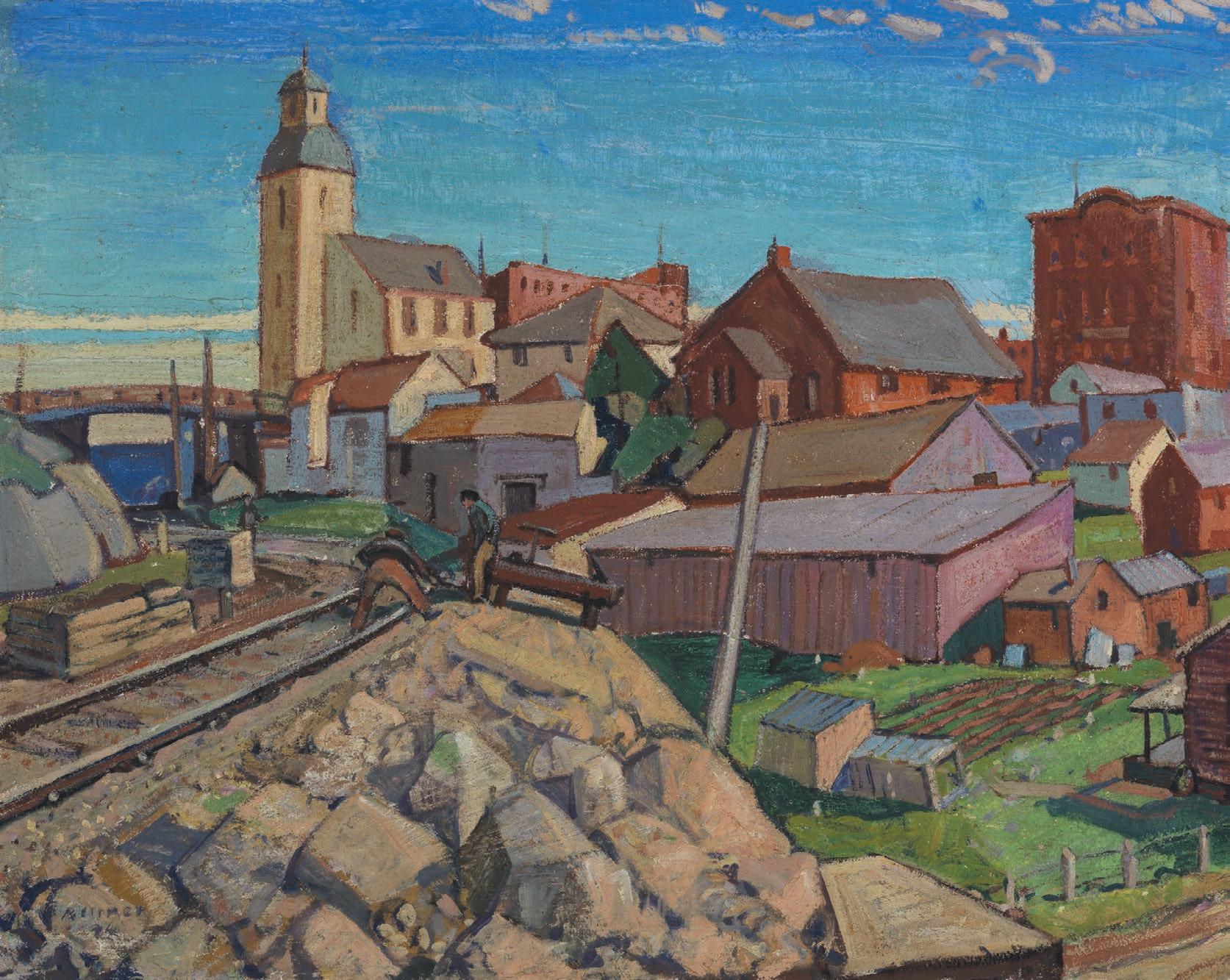
We thank Charles C. Hill, curator of Canadian art from 1980 to 2014 at the National Gallery of Canada and author of The
Group of Seven: Art for a Nation, for contributing the above essay. This painting has been in the collection of the same family since it was acquired from Laing Galleries in 1959.
1. Sale of Fine Canadian Art, Heffel Fine Art Auction House, November 27, 2014, lot 133.
2. Reproduced in Rosemary Donegan, Industrial Images (Hamilton, ON : Art Gallery of Hamilton, 1987), exhibition catalogue, 71.
3. Reproduced in Charles C. Hill, The Group of Seven: Art for a Nation (Toronto: Art Gallery of Ontario, in assoc. with Douglas & McIntyre, 1995), exhibition catalogue, 161.
4. A Lismer oil sketch, dated 1922 and descriptively titled Landscape with a Barn, A House on the High Ground, most likely a Meadowvale subject, sold at Sotheby & Co. (Canada) Ltd., Toronto, October 26, 1970, illustrated in the catalogue.
5. Kathleen A. Hicks, Meadowvale: Mills to Millennium (Mississauga Library System, 2004), 121–23.
e stimate: $ 250,000 – 350,000
42
a rthur l ismer A Northern Town, Mattawa, Ontario oil on canvas, 1922 32 × 40 in, 81.3 × 101.6 cm Private Collection Not for sale with this lot


44
121 David Brown Milne
CGP CSGA CSPWC 1882 – 1953
Hepaticas in a Cup oil on canvas, signed and dated 1935 and on verso titled and inscribed 1 / 14 / 161 22 1/8 × 24 1/8 in, 56.2 × 61.3 cm
p rovenan C e
Sale of the Artist to Vincent Massey, Toronto, 1935
Laing Galleries, Toronto
Acquired from the above by a Private Collection, Toronto, April 9, 1958
By descent to the present Private Collection, Toronto
l iterature
David Milne Jr. and David P. Silcox, David B. Milne: Catalogue Raisonné of the Paintings, Volume 2: 1929 – 1953 , 1998, reproduced page 602, catalogue #304.22
e xhibited
Hart House, University of Toronto, David Milne, January 7 – 22, 1962
dAVI d M I l NE f REQUENT ly corresponded with Alice Massey in mid-1930. Thanks to his frankness about his work, we know how he composed—and what he thought of—Hepaticas in a Cup. To Mrs. Massey in May 1935, Milne describes the “players” in the still-life drama we witness in this painting as well as its background. He details “spring flowers and leaves sprawled over most of the bottom part of the canvas, near at hand, out of focus and away in one corner . the Christmas pudding bowl and another bowl with hepaticas and dogs toothed violets.” 1 In a draft for an article titled “Spring Fever,” penned ten years later, Milne reflected on his habit of painting spring still lifes and why he received a special “kick” from this 1935 painting: “The picture was simple, very,” he explained, “and depended largely on composition.” 2 What he does not spell out, but we manifestly experience, is that his simplicity of subject matter and form yields in the onlooker an inversely expansive aesthetic intrigue and thus pleasure.
In another letter to Massey in May 1935, Milne mentions several of the elements we might puzzle over in this painting. “More than half of [it] is blank—dirty black. Most of the rest contains out of focus shapes of Hepatica flowers and leaves in a cup done in dirty black and dirty white, no hues.” 3 He also describes how he rubbed out forms and then returned to them, a comment that helps us to understand the looming and also “dirty” elements in Window at Night (lot 122 in this sale). Milne made a habit of setting himself formal challenges, working closely and repeatedly with motifs that tested his ability and developed his aesthetic. His work equally tests and educates the viewer’s eye.
We thank Mark A. Cheetham, Professor of Art History at the University of Toronto, for contributing the above essay. Cheetham has written extensively on Canadian art and artists—including Jack Chambers, Alex Colville, Robert Houle and Camille Turner—and was most recently a contributor to the 2022 book Unsettling Canadian Art History
Hepaticas in a Cup has been in the same family since it was acquired from Laing Galleries in 1958.
1. Quoted in David Milne Jr. and David P. Silcox, David B. Milne: Catalogue Raisonné of the Paintings, vol. 2 , 1929–1953 (Toronto: University of Toronto Press, 1998), 602.
2. Ibid.
3. Ibid.
e stimate: $ 40,000 – 60,000
45
122 David Brown Milne
CGP CSGA CSPWC 1882 – 1953
Window at Night
oil on canvas, signed and dated 1934 and on verso titled and inscribed 32 B / 32 / 128 16 1/8 × 20 1/8 in, 41 × 51.1 cm
p rovenan C e
Sale of the Artist to Vincent Massey, Toronto, 1935
Laing Galleries, Toronto
Acquired from the above by a Private Collection, Toronto, April 9, 1958
By descent to the present Private Collection, Toronto
l iterature
David Milne Jr. and David P. Silcox, David B. Milne: Catalogue Raisonné of the Paintings, Volume 2: 1929 – 1953 , 1998, reproduced page 589, catalogue #303.49
dAVI d M I l NE RESPON d E d passionately to the place in which he was painting, particularly to what motifs it offered, and often registered his aesthetic satisfaction (or otherwise) with a specific locale. Born in Bruce County, Ontario, he enrolled at the Art Students League of New York (1903 – 1905) and stayed in New York until 1916, when he moved to Boston Corners in New York State. Milne joined the Canadian Army in 1917 and returned to the USA afterwards. Though he established a strong early reputation in the USA , he and his wife Patsy returned to Canada in 1929 and settled in the town of Palgrave, in southern Ontario. Milne loved the quiet, domestic, agrarian landscapes of the area and the quaintness of the town. However, his relationship with Patsy ended while they were living in Palgrave.
Characteristic of his peripatetic life, by 1933 Milne was again reluctantly uprooted. He searched for another sympathetic locale where he could afford to live and settled on Six Mile Lake, near Georgian Bay in the Muskoka area of Ontario. He then built a cabin and started painting. Milne lived at Six Mile Lake from 1933 to 1937, longer than anywhere else in his career.
Window at Night is a distinctive work by Milne, and fascinating in its own right. With Hepaticas in a Cup and Pool in Snow (lots 121 and 123, respectively), it is also notable as one of approximately 300 works that Milne sold to Vincent and Alice Massey in one of the oddest and most memorable episodes of patronage in the history of art in Canada.1 Always skirting poverty and yet dedicated to making art, Milne conceived a plan in about 1933 to sell large numbers of his works in one lot. In the Depression, his motive was in part financial, but equally to keep his work together in one accessible collection. Writing to Alice and Vincent Massey—the eventual purchasers—he reasoned that the total price he had set for this collection of recent work (about $ 5 per painting) was not “large enough to have made their painting a profitable, or even
possible, enterprise; yet it is enough to ensure years of undisturbed painting for the artist with simple tastes.” The aim, he continued, was “to trade twenty-five years of painting that is past for five or ten years in the future.”2 Selling these and other works to the Masseys, who were among Canada’s leading collectors at the time, was prestigious for Milne and financially essential, even though the subsequent exhibition and sale of some of this work was not what he had envisioned, and was the cause of regret for Milne.
At first, it is difficult to make sense of Window at Night. Guided by the title, we can imagine that we are seeing reflections in the windows of Milne’s small cabin in artificial light. The space is tight. Colour is dramatic but restricted, and the aggressive orange and black forms that extrude from the centre of the image are not descriptive, but instead suggest the experimentalism of this work and much of Milne’s painting at Six Mile Lake. He often painted over or partially erased his own efforts, which could be one way to interpret these forms, and he tried out textures that could become new background configurations.
The result is a compellingly unfamiliar painting. Milne embraced the isolation he found in this new spot, perhaps in part because it forced him to find new subjects close to hand. “So far as I know I am the only permanent resident,” he wrote. “From here you can hear the train whistles at Bala and the steamboat whistles on Georgian Bay. No railways touch Six Mile and no highways. There is one rough wagon road from Honey Harbour and Port Severn, branching off to touch Six Mile at White’s. You can’t get to it by canoe without a portage. Barring that it is accessible.” 3
We thank Mark A. Cheetham, Professor of Art History at the University of Toronto, for contributing the above essay. Cheetham has written extensively on Canadian art and artists—including Jack Chambers, Alex Colville, Robert Houle and Camille Turner—and was most recently a contributor to the 2022 book Unsettling Canadian Art History.
Window at Night has been in the same family since it was acquired from Laing Galleries in 1958. The coat pictured in this painting belonged to David Milne, as confirmed by David Milne Jr. He recalls that his father used the coat a number of times in Six Mile Lake interiors, sometimes against shelves. In this painting, it is equally effective against the cabin window at night.
1. Described in detail in David P. Silcox, Painting Place: The Life and Work of David B. Milne (Toronto: University of Toronto Press, 1996), chap. 12.
2. Ibid., 250.
3. Ibid., 246.
e stimate: $ 30,000 – 50,000
46

47

48
123 David Brown Milne
CGP CSGA CSPWC 1882 – 1953
Pool in Snow
oil on canvas, signed and dated March 1935 and on verso titled and inscribed 35 B and 91 12 × 16 in, 30.5 × 40.6 cm
p rovenan C e
Sale of the Artist to Vincent Massey, Toronto, 1935
Laing Galleries, Toronto
Acquired from the above by a Private Collection, Toronto, April 9, 1958
By descent to the present Private Collection, Toronto
l iterature
David Milne Jr. and David P. Silcox, David B. Milne: Catalogue
Raisonné of the Paintings, Volume 2: 1929 – 1953 , 1998, titled as Pool in the Snow, reproduced page 597, catalogue #304.9
dAVI d M I l NE ’ S KEEN eye was always finding aesthetically significant forms, whether inside his cabin or, as he preferred, in nearby environs. Outside more often in March of 1935, he composed the challenging Pool in Snow from just a few elements: lingering snow, a reflective surface, a few bare trees, and what looks like a sled of some sort (likely used by Milne to transport supplies to and from this remote cabin). There is much more colour in this canvas than we might at first notice. The middle tree shows hints of spring green. The one on the left catches a bright blue reflection from the pool. The wooden sled almost glows orange, illuminating and animating the snow in which it stands.
At first glance, the scene depicted in this oil painting may appear to be ordinary or mundane, but upon closer examination, the relationship between the various forms in the frame becomes dynamic and rewarding to unravel. In a letter to his patrons Vincent and Alice Massey, Milne explained his aesthetic approach, stating: “The painter gets an impression from some phase of nature. He doesn’t try to reproduce the thing before him:
he simplifies and eliminates until he knows exactly what stirred him, sets this down in colour and line as simply, and so as powerfully as possible, and so translates his impression into an aesthetic emotion.” 1 Here Milne employs the art theory of the British writer Clive Bell, who in his book Art (1914) explained the importance of “aesthetic emotion”:
The recognition of a correspondence between the forms of a work of art and the familiar forms of life cannot possibly provoke aesthetic emotion. Only significant form can do that. Of course realistic forms may be aesthetically significant, and out of them an artist may create a superb work of art, but it is with their aesthetic and not with their cognitive value that we shall then be concerned. We shall treat them as though they were not representative of anything.2
Keeping this theory in mind can help to deepen the appreciation of works such as Pool in Snow, and especially Window at Night (lot 122 in this sale).
We thank Mark A. Cheetham, Professor of Art History at the University of Toronto, for contributing the above essay. Cheetham has written extensively on Canadian art and artists—including Jack Chambers, Alex Colville, Robert Houle and Camille Turner—and was most recently a contributor to the 2022 book Unsettling Canadian Art History
Pool in Snow has been in the same family since it was acquired from Laing Galleries in 1958.
1. Milne to the Masseys, August 1934, cited in Katharine Lochnan, “Reflections on Turner, Whistler, Monet, and Milne,” David Milne Watercolours: “Painting Toward the Light,” ed. Katharine Lochnan (Toronto: Art Gallery of Ontario, in assoc. with Douglas & McIntyre, 2005), exhibition catalogue, 119.
2. Clive Bell, Art (New York: Frederick A. Stokes, 1914), 43.
e stimate: $ 30,000 – 50,000
49
124 Alexander Young (A.Y.) Jackson
ALC CGP G7 OSA RCA RSA 1882 – 1974
Émileville, Que.
oil on canvas, signed and on verso signed, titled, dated 1912 incorrectly and inscribed Studio Bldg Severn St., Toronto, 1913
31 1/8 × 32 in, 79.1 × 81.3 cm
p rovenan C e
Collection of the Artist
Sir Frederick Grant Banting, Toronto
Estate of Dr. Henrietta Banting, Toronto Private Collection, Toronto
By descent to the present Private Collection, Ontario
A.y. J ACKSON PAINTE d this remarkable work in Quebec’s Eastern Townships in the spring of 1913, at an absolutely crucial juncture in his life. He was 31 years old and had recently returned to Montreal after more than a year in Europe, during which he had painted landscapes in both France and Italy. He found himself with “a lot of canvases which no one wanted,” because in Montreal his Impressionist-inspired works were regarded, he later wrote, as examples of an “extreme modernism.” 1
Yet Jackson, typically, was undaunted. Determined to forge a career as a painter, he did not, as in the past, take a job with a commercial design firm. Instead, in February 1913, he joined forces with Randolph Hewton, another young Quebec painter whom he had met in Paris, and the pair staged a small exhibition at the newly opened Montreal Museum of Fine Arts on Sherbrooke Street. Their works attracted favourable reviews, with the Montreal Daily Star assuring its readers that the pair deserved praise and encouragement, “so great is the promise that they exhibit.” 2 But the venture was far from a financial success: Hewton sold only a single painting (to an obliging aunt) while Jackson failed to sell anything at all. He complained to his cousin Florence Clement that since wealthy Montreal collectors “buy only the works of dead artists, it’s kind of hard on the ones still living.” 3
Jackson contemplated moving to the United States—the choice of many young Canadian artists frustrated by their lack of local support. However, in the middle of March, before making any firm decisions about his future, he retreated with Hewton to the tiny village of Émileville, 40 miles east of Montreal. They boarded with a local family, the Guertins, and tried to find inspiration, as he wrote to Charles Clement, “for some more stuff to inflict on the long-suffering public.” 4 He modestly described his efforts as “messing away with lots of paint, trying to make it interpret Nature without imitating too carefully.” 5 In fact, he proved creative and prolific, producing works such as Early Spring, Émileville, Quebec (in the McMichael Canadian Art Collection), in which the purplish-blue shadow of a tree forks across the snow; Morning after Sleet (collection of the National Gallery of Canada), a beautiful study in mauves, pinks and pale blues; and Cedar Swamp, Émileville (collection of the Art Gallery of Ontario), a richly toned panorama showing Mont Yamaska rising in the distance.
Émileville, Que. is an even more emphatic demonstration of striking patterns and vivid tones. Painted once the snow had retreated, the canvas shows a jumbled foreground of rocks, bare earth and a reflective pond of meltwater, all brushed confidently and vigorously in dabs of orange, crimson and flickers of lime
green. In the clearing stands a shed, almost in camouflage, its statuesque chimney and patchwork roof both crossed with multihued shadows. A woodshed adjoins the shack, its stacked logs another motley display, and behind we see a wagon with wheels painted a fierce orange. The screen of slender trees in the background forms a dense tapestry of rusts and umbers streaked with vermilion and olive green.
The painting is an assured demonstration both of lessons learned from seeing avant-garde painting first-hand in Paris and—even more—of a new appreciation for the rustic charms of the Canadian backwoods. Jackson had spent the previous year painting the beaches of Normandy and the hills of Italy. Now, in Émileville, he was more than ever determined to paint the Canadian hinterlands. “The country is glorious,” he wrote to his cousin before his departure, “but its beauties are unknown and but waiting for a real live artist to splash them onto a canvas.” 6 This visit to Émileville helped him find the way to capture Canada’s robust northern beauties, and in doing so to establish crucial elements of what became the Group of Seven style. Émileville, Que. showcases the kind of landscape close-up that over the next decade became a hallmark of paintings by Jackson and friends such as Tom Thomson: the close-quarters glimpse across rocky terrain into the dazzling patterns of the rugged northern bush.
While Jackson forged this powerful new style, he also began forming the relationships that would change Canadian art. Still in Émileville, he received a letter from J.E.H. MacDonald in Toronto. The pair had never met, though Jackson remembered admiring one of MacDonald’s winter landscapes two years earlier in Montreal. MacDonald was acting as intermediary for Lawren Harris, who wished to purchase one of Jackson’s works, The Edge of the Maple Wood, painted three years earlier in nearby Sweetsburg. The rest, of course, is history. In the summer of 1913, Jackson used the proceeds of this sale to fund a trip to Toronto and then Georgian Bay. Over the course of the summer he met MacDonald and Harris for the first time, as well as Arthur Lismer and F.H. Varley, and then, in the autumn, Tom Thomson. He quickly decided that his future lay not in New York City but, rather, in splashing Canada’s beauty onto canvas in the way that had served him so well in Émileville.
Émileville, Que. was owned after World War I by Jackson’s friend Dr. Frederick Banting, co-recipient of a Nobel Prize in 1923. The distinguished doctor was a fitting owner for the work— he was a talented amateur painter, who during the 1920s was Jackson’s frequent traveling and sketching companion in rural Quebec.
We thank Ross King, author of Defiant Spirits: The Modernist Revolution of the Group of Seven, for contributing the above essay.
1. A.Y. Jackson, A Painter’s Country: The Autobiography of A.Y. Jackson (Toronto: Clarke, Irwin, 1958), 23 and 24.
2. Montreal Daily Star, February 20, 1913.
3. A.Y. Jackson to Florence Clement, March 5 and 7, 1913, box 95, Naomi Jackson Groves fonds, Library and Archives Canada, Ottawa.
4. A.Y. Jackson to Charles Clement, April 19, 1913, box 75, file 11, ibid.
5. Quoted in F.B. Housser, A Canadian Art Movement: The Story of the Group of Seven (Toronto: Macmillan, 1926), 81.
6. A.Y. Jackson to Florence Clement, March 5 and 7, 1913.
e stimate: $ 125,000 – 175,000
50

51

52
125 Lawren Stewart Harris
Tamarac, Spruce and Pine, Algoma oil on board, on verso signed, titled twice and inscribed with the artist’s symbol and 25 Severn St. / Not For Sale
(crossed out) / Toronto, circa 1918 – 1919
10 3/8 × 13 1/8 in, 26.4 × 33.3 cm
p rovenan C e
Private Collection, British Columbia Fine Canadian Art, Heffel Fine Art Auction House, November 28, 2003, lot 65

The Art Emporium, Vancouver Private Collection, California
Al ONG WITH HIS companions in the Group of Seven, Lawren Harris was driven to create a Canadian art that responded to, and drew inspiration from, the unique and diverse northern landscape of the nation. After his return to Canada in 1908 from studying art in Europe, Harris was able to connect with likeminded artists, including J.E.H. MacDonald and Tom Thomson, and embark on sketching trips in an attempt to create an “art expression which should embody the moods and character and spirit of the country.” 1 Algonquin Park, Georgian Bay and the Laurentians were the first sketching grounds, and Harris fondly recollected those early days: “We commenced our great adventure. We lived in a continuous blaze of enthusiasm . Above all we loved this country and loved exploring and painting it.” 2
After the disruption of the First World War, this enthusiasm and exploration began again with renewed vigour in the form of trips to Algoma, along the east side of Lake Superior, which is where the striking and confident Tamarac, Spruce and Pine, Algoma was painted. In both 1918 and 1919, Harris arranged for transportation and accommodation along the Algoma Central Railway line, departing from Sault Ste. Marie. Harris’s excitement about this venture is evidenced by his letters to MacDonald in the summer of 1918. Writing from his summer cottage on Lake Simcoe, he describes their plan: “We enter a Caboose which will be our home while in the North. Said caboose is hitched onto some train or other hauled to a siding in the Agawa Canyon 120 miles north of the Soo and left there for two or three days while we proceed to get a strangle hold on the surroundings.” 3 These trips, which also included Frank Johnston, A.Y. Jackson and art patron Dr. James MacCallum, enabled the artists to create a great variety and abundance of novel and dynamic sketches, and resulted ultimately in the 1920 creation, and inaugural exhibition, of the Group of Seven.
While in Algoma, the artists explored the forests, rivers and lakes by hiking, canoeing or traveling up and down the tracks in a small handcar. Ahead of the trip, Harris explained to MacDonald how they would proceed, moving south from their starting point:
“From mile 120 we are picked up by a down-going train and left on another siding for a few days and again picked up and left on still another siding and so on until we land [in] the Soo with a mass of sketches and C.P.R. ourselves home again.” 4 It is somewhere along this route, likely sketched from the side of the railway line as they got closer to Sault Ste. Marie, that this work was painted, and it joined the growing “mass” of monumental works that would travel back to Toronto and change the course of landscape painting in Canadian art.
There is a pensive air to this fine sketch, a sense of quiet that permeates the scene. The long cloud forms suggest a cool autumn breeze blowing over the far hill and through the tall white pines that anchor the composition. The dying light of day creates a solemnity resonant with works Harris would produce a few years later from the north shore of Lake Superior, and a sense of reflection. One can immediately appreciate the influence of Thomson, who surely would have been included on these trips to Algoma if not for his unexpected and tragic death in 1917, which impacted Harris greatly. The foreground tamaracks, brilliant in their yellow fall foliage, make a striking contrast against the deep greens of the spruces behind, a compositional device used to great effect by Thomson in his Algonquin sketches. Given this context, the work moves beyond a raw and vital depiction of northern Ontario. It typifies the type of emotional resonance that the Group of Seven was able to so successfully foster in their paintings, using the subject of Canadian landscape to elicit strong and persistent human connections to the environment. The fact that sketches such as this one still resonate so clearly over a century later is a testament to their importance and unparalleled legacy.
We thank Alec Blair, Director/Lead Researcher, Lawren S. Harris Inventory Project, for contributing the above essay.
1. Lawren Harris, “The Group of Seven in Canadian History,” Report of the Annual Meeting of the Canadian Historical Association 27, no. 1 (1948): 31.
2. Ibid., 32.
3. Undated 1918 letter from Lawren Harris to J.E.H. MacDonald, l SH Estate Archives.
4. Ibid.
e stimate: $ 100,000 – 150,000
53
ALC BCSFA CGP FCA G7 OSA TPG 1885 – 1970
t om t homson Tamarack Swamp (Sketch #5) oil on panel, 1915 8 1/2 × 10 1/2 in, 21.6 × 26.7 cm Private Collection
Not for sale with this lot

54
MacDonald
ALC CGP G7 OSA RCA 1873 – 1932
Giants Tomb, Georgian Bay oil on canvas, on verso initialed and inscribed about 1912 Georgian Bay / Thoreau MacDonald / Sept. 58 / are in his hand and indistinctly by Thoreau MacDonald 28 1/4 × 38 1/4 in, 71.8 × 97.2 cm
p rovenan C e
Thoreau MacDonald, Toronto, 1958
Paul Guy Desmarais Sr., Montreal, 1967
By descent to Jacqueline Desmarais, Montreal Estate of Jacqueline Desmarais
l iterature
C.W. Jefferys, “MacDonald’s Sketches” and “Generalia,” The Lamps, vol. 1, no. 2, December 1911, pages 12 and 16
James MacCallum, “The Outer (Northern) Bay,” The Madawaska Club, Go-Home Bay, 1898 – 1923 (reprinted 1972), pages 49 –50, and pages 10, 19, 24 and 51 – 52
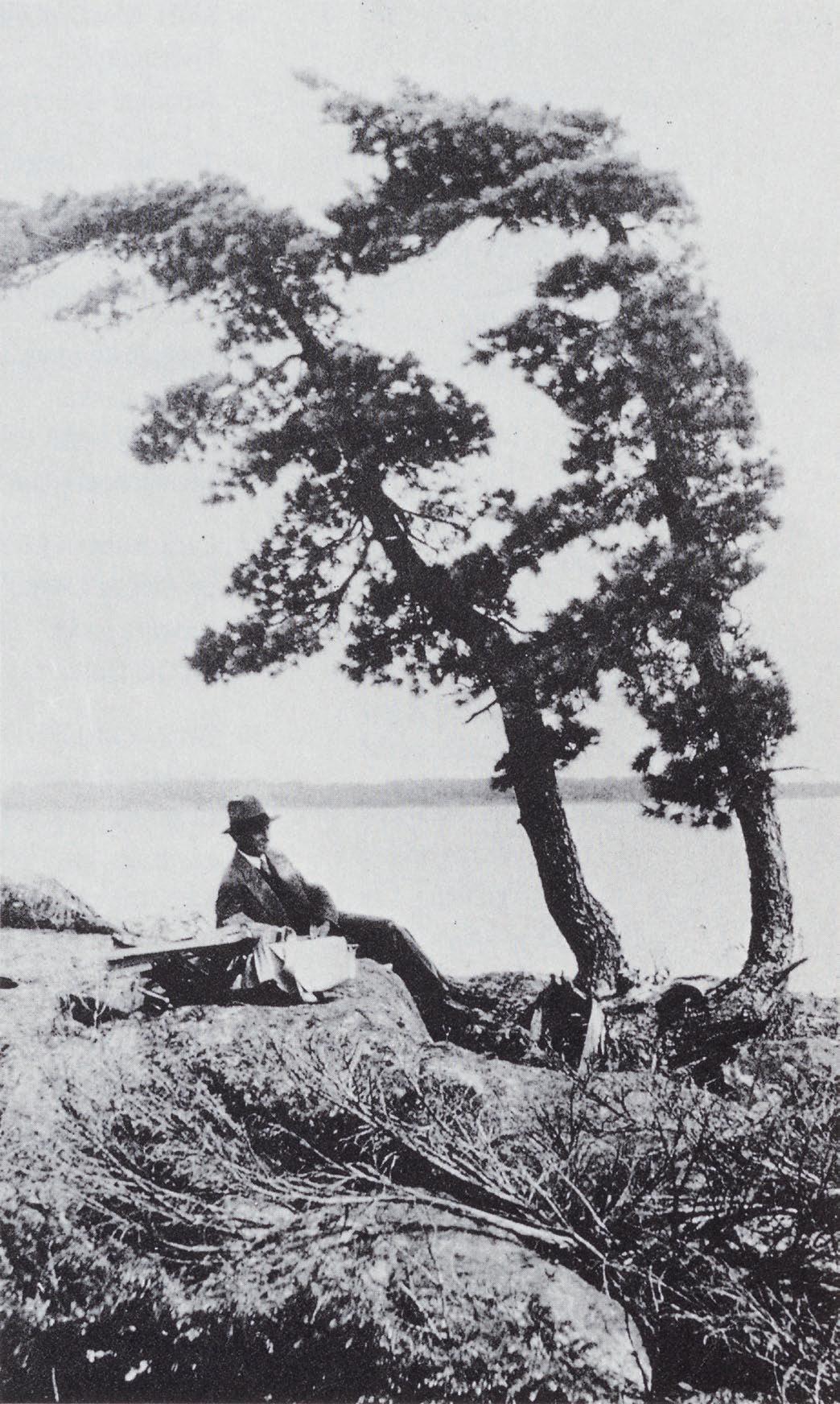
E.R. Hunter, J.E.H. MacDonald: A Biography and Catalogue of His Work, 1940, pages 7 – 10 and 48
Nancy Robertson, J.E.H. MacDonald, RCA , 1873 – 1932 , Art Gallery of Toronto, 1965, pages 7 – 10, 13, 21 and 47 – 49
Dennis Reid, The Group of Seven, National Gallery of Canada, 1970, pages 60 – 62
Paul Duval, Tangled Garden: The Art of J.E.H. MacDonald, 1978, pages 24, 35 – 37 and 45 – 46
John Flood, Thoreau MacDonald’s Notebooks, 1980, pages 15 – 38
Pierre B. Landry, The MacCallum – Jackman Cottage Mural Paintings, 1990, pages 10 – 17
J.E.H. M ACdONA ld BEGAN his career as a graphic designer, working for Grip Ltd. in Toronto until 1903, then in London, England, where he worked for Carlton Studios, a design firm established by former members of the Toronto Art League. In 1907 he returned to Grip, where he met fellow artists Albert Robson, Tom Thomson, Frank Johnston and Arthur Lismer, who arrived from Sheffield, England, in 1911. The artists were encouraged to sketch on weekends in the country surrounding Toronto, and MacDonald was soon exhibiting landscapes in the annual exhibitions of the various societies. His first subjects were sketched around his home near High Park and the Humber Valley, in what was then Toronto Junction, and in 1909 he painted at Burks Falls and on the Magnetawan River. The canvases MacDonald exhibited at this time measured about 20 × 28 inches, the larger canvases of 1912 about 28 × 36 to 40 inches, similar to the dimensions of this canvas, which is mounted on a stretcher made by the artist.
MacDonald had associated with the newly formed Arts and Letters Club from its inception in March 1908. That month he designed the club’s first recruitment publication, A Gathering of the Arts, as well as the club’s crest for the first issue of its magazine, The Lamps (for Literature, Architecture, Music, Painting, Sculpture), published in January 1910. However, MacDonald, possibly for financial reasons, only became a member of the club in February 1911.
55
126 James Edward Hervey (J.E.H.)
J.E.H. MacDonald sketching, Sturgeon Bay, leading into Georgian Bay
Not for sale with this lot
The Arts and Letters Club provided MacDonald with new associates and it was there that he met Lawren Harris, chairman of the club’s picture committee during the winter of 1911 to 1912. In November Harris arranged for an exhibition of MacDonald’s paintings, an exhibition that was enthusiastically reviewed by C.W. Jefferys in the December 1911 issue of The Lamps:
For some years Mr. J.E.H. MacDonald has been known as an exceedingly able designer, but the recent exhibition of his sketches . . . gave the first opportunity we have had of estimating his powers in landscape painting . To those of us who are interested in the development of a native spirit in art in Canada, the quality of this collection and the appreciation of its significance, . . . were equally matters for encouragement. For Mr. MacDonald’s art is native—as native as the rocks, or the snow, or pine trees, or the lumber drives that are so largely his themes . . . In these sketches there is a refreshing absence of Europe, or anything else, save Canada and J.E.H. MacDonald and what they have to say; and so deep and compelling has been the native inspiration, that it has, to a very great extent, found through him, a method of expression in paint as native and original as itself.
Writers have differed in their accounts of when MacDonald first painted at Georgian Bay; however, no Georgian Bay painting by MacDonald dated prior to 1912 has been located, and his

Georgian Bay subjects were exhibited at the Canadian National Exhibition in late August 1912. It was at the Arts and Letters Club that MacDonald met Dr. James MacCallum, who had been invited by his friend Harris to see MacDonald’s November exhibition. The doctor was impressed, and it was he who invited the artist to spend time at Georgian Bay. MacCallum became a member of the club in February 1912, after MacDonald’s exhibition.
MacCallum had spent part of his youth at Collingwood on Georgian Bay, where he became entranced by the northern Ontario landscape. He studied ophthalmology in London and from 1890 taught at the University of Toronto. In 1898, a group of university professors established the Madawaska Club at Go Home Bay on Georgian Bay, membership being restricted to people associated with the university. While MacCallum had been a member of the club since 1898, it was only in 1905 that he purchased an island north of the club property. He built his cottage there in 1911, the summer before MacDonald’s exhibition.
MacDonald spent about three weeks on the bay in July 1912 with his wife and eleven-year-old son, Thoreau. Thoreau kept a diary from July 12 to August 5, from which we know they did not stay at the MacCallum cottage but on a houseboat moored at Split Rock Island in Monument Channel, across from MacCallum’s island. An oil sketch by MacDonald of the boathouse, originally used by MacCallum to house his family before he built his own cottage, sold at auction in 2014. Thoreau’s diary notes regular visits to Go Home Bay, the arrival of the Madawaska Club’s
56
James e dward h ervey (J. e h .) m a Cd onald Hazy Sunshine, near Split Rock oil on cardboard, 1912 6 x 9 1/2 in, 15.2 x 23.4 cm Collection of National Gallery of Canada, Bequest of Dr. J.M. MacCallum, Toronto, 1944
Photo: NGC
supply boat, the Waubic, and above all, the animal and marine life around the rocky shoals.
MacDonald’s 1912 sketches of Georgian Bay are characterized by low horizons, rocky islands that are mere silhouettes and vast expanses of sky. He worked up his canvases that winter and exhibited Fine Weather, Georgian Bay (the Thomson Collection at the Art Gallery of Ontario) with the Ontario Society of Artists in April 1913. Dr. MacCallum acquired another canvas dated 1912, August Haze, Georgian Bay (sold at auction in 1998). Two other canvases dated 1913, Log Pickers (collection of Museums London) and The Lonely North (collection of Empire Company Ltd., Stellarton, NS ), have been identified as depicting Go Home Bay. These four canvases were included in E.R. Hunter’s catalogue of 1940 but the painting being offered here, identified by Thoreau MacDonald as depicting Giants Tomb Island, southwest of Go Home Bay, was not listed.
Giants Tomb, Georgian Bay is closest to August Haze, Georgian Bay. Painted in a similar palette of creamy yellows and soft pinks, both canvases depict an open foreground of water (more developed in the latter) with low, silhouetted islands, a low horizon and vast skies. In contrast, in Fine Weather, Georgian Bay figures stand by a gnarled root on rocks in the foreground. The principal subject of The Lonely North and Log Pickers, however, is not calm waters and vast sky but turbulent clouds, rising majestically in the former and hanging threateningly in the latter. The dramatic effects of cloud formations had long been a preoccupation of
MacDonald’s, as seen in A March Evening of 1911 (sold at Heffel, November 25, 2004, lot 22) and Snow Cloud of 1912 (collection of Tom Thomson Art Gallery, Owen Sound), and were translated into billowing smoke in Tracks and Traffic of 1912 (collection of the Art Gallery of Ontario). In contrast to the serenity of August Haze, Georgian Bay, light-crested, thickly painted clouds overhang the calm water in Giants Tomb, Georgian Bay Hazy Sunshine, near Split Rock, the 1912 sketch for August Haze, bequeathed to the National Gallery of Canada by Dr. MacCallum, includes a sailboat on the horizon as does Giants Tomb, Georgian Bay. This canvas appears to stand midway between August Haze and The Lonely North, an important moment in MacDonald’s rapid experimentation during the winter of 1912 to 1913.
We thank Charles C. Hill, former curator of Canadian art from 1980 to 2014 at the National Gallery of Canada and author of The Group of Seven: Art for a Nation, for contributing the above essay. This work is accompanied by the original photo-certificate handwritten by Thoreau MacDonald stating: “This painting is the work of my father J.E.H. MacDonald, painted about 1912 – 1913. His initials J. MacD. in his own hand are on the stretcher. The distant island is probably Giants Tomb, Georgian Bay. Thoreau MacDonald, Sept. 8, 1958”
e stimate: $ 125,000 – 175,000

57
Lot 126 showing in its frame

58
127 Cornelius David Krieghoff
1815 – 1872
Carting Snow, Montreal
oil on panel, signed and on verso titled and dated 1850 on the G. Blair Laing label
6 × 8 1/2 in, 15.2 × 21.6 cm
p rovenan C e
Estate of Col. Grant-Smith, Quebec
G. Blair Laing Ltd., Toronto
Kenneth R. Thomson, Toronto
A.K. Prakash & Associates Inc., Toronto, 2004 Private Collection, Toronto, 2005
C ORNE l IUS K RIEGHO ff f IRST moved to Montreal in 1840, and that is where he began his career as an artist in earnest. He traveled to Paris in 1844, spending two years training under the direction of Michel-Martin Drölling, before returning to Montreal, where he would remain as a practising artist until settling in Quebec City in 1853. His production at this time was prodigious, and he was well received and well represented in the growing collections of the newly rising middle class and military men that made up his clientele. His paintings depict the moments of narrative drama or humour that characterized rural life, as well as portraits of the Indigenous merchants and trappers he encountered, set in the surrounding landscape. While the subjects of his works are often romanticized or typified, the details of his subjects were undeniably taken from authentic observation. In particular, Krieghoff excelled in portraying winter scenes. He paid close attention to the landscape transformed by cold and ice, as well as the clothing, labours and play of his subjects, to depict the sense of sublime hardship and wonder that resonated with his buyers.
This exceptional work is taken from this early period in Krieghoff’s professional development. The subject of the painting is a horse hauling a caged sleigh piled high with snow cleared after a storm, with a shovel protruding from the overflowing mound. The sturdy draft horse strains against the weight of its
cargo, while a blue-coated habitant, armed with a switch and his mouth open calling a command, encourages it along. The frozen St. Lawrence has itself become a field of ice; a few scanty trees show that the scene is set on the southern shore of the river, across from Montreal. In the background, the skyline of the city and the distant ridge of Mont Royal form a thin horizon under a towering, darkened northern cloudscape—the passing recent storm, perhaps, or the threat of further snowfall.
European settlers in Canada soon realized that winters in Quebec were much harsher than the ones they were used to; the season was long and cold, punctuated by deep-freezes and frequent heavy snowfalls. The inhabitants of Montreal and Quebec City would find that the extreme weather winter brought posed a problem. With snowbanks that could reach the height of several metres, snow would need to be moved from the streets and walks of the rapidly developing cities in order for them to continue functioning. At this point in Montreal’s history, the only means of doing this was by hand and by horse. Snow removal was not done by a specialized public works department but by the city’s residents themselves, with civilians pitching in after a snowfall to clear the thoroughfares and sidewalks of snow and ice with whatever carts, shovels and pickaxes they had on hand.
In the background, Montreal itself is depicted as it would have looked in 1850. On the right is the dome and neoclassical pediment of the Bonsecours Market, the large public market that was completed and opened in 1847, only a few years before this work was produced; in 1849, it was briefly the site of the Legislative Assembly of the Province of Canada. Hidden behind the horse we see a few spires of the city’s churches—in particular, the two squared towers of the Notre-Dame Basilica, finished only a few years earlier. In depicting the city with the same observational detail as he did its inhabitants, Krieghoff represents a unified view of life in Quebec that is increasingly cosmopolitan and modern, while remaining grounded in a particularly regional sense of the early Canadian experience.
e stimate: $ 30,000 – 50,000
59

60
128 Bertram Richard Brooker
CGP CSGA CSPWC OSA RCA 1888 – 1955
Hot Weather
oil on canvas, signed and on verso titled, inscribed Hart House Nov/37 / Vic / OC 51 , numbered 71137 on the Art Gallery of Ontario inventory label and stamped with the Bertram Brooker estate stamp, circa 1937
36 1/4 × 30 1/4 in, 92.1 × 76.8 cm
p rovenan C e
Estate of the Artist Private Collection, Toronto
e xhibited
Hart House, University of Toronto, Bertram Brooker, November 1937
A MONG THE MOST adventurous Canadian painters of his generation, Bertram Brooker was also thoroughly steeped in the world of print. His Dostoyevskian novel Think of the Earth (1936) was the inaugural recipient of the Governor General’s Award for Literary Merit in 1937—the same year Hot Weather premiered in an exhibition at Hart House.
As editor and publisher of Marketing magazine from 1924 to 1927, the multidisciplinary artist had proposed synesthetic approaches to advertising copy and layout that mirrored his contemporaneous production of musically inspired abstract canvases. The latter were exhibited in Canada’s first one-person show of non-objective art, at Toronto’s Arts and Letters Club in 1927. The disappointing reception of that groundbreaking event, coupled with the uncertainties of the Great Depression, encouraged Brooker’s turn to representation in 1929.
Brooker’s dreamlike canvas portrays a young man, stripped to the waist, absorbed in the act of reading. Hot Weather epitomizes the synthesis of abstract and naturalistic modes that Brooker had honed by the mid-1930s in such works as Blue Nude (1937). In common with Blue Nude, the central figure in Hot Weather is dissected by a geometric lattice that nods to the Synthetic Cubism of Georges Braque. In a 1949 address to Hart House, Brooker observed approvingly, “Braque takes the commonest things and transfigures them by the grandeur of his imagination.” 1 In Hot Weather, Brooker draws the viewer into the imaginative world of his sitter by means of auratic emanations that seem to manifest his overheated thoughts. Echoing the contours of his head, these wavelike forms conjure the dynamic rhythms that were said to animate the cosmos according to vitalist philosophers such as Henri Bergson, an important inspiration to Brooker from at least the early 1920s.
In The Brave Voices, a book-length manuscript left unpublished at the time of his death, Brooker interprets Bergson’s élan vital, or vital impetus, as a form of sexual energy. The fluid emanations of Hot Weather communicate the same insight, as the contour of the sitter’s right ear progressively morphs into the seductive profile of a woman’s silhouette. This device is equally revelatory of the erotically charged content of the figure’s reading material, whose shocking red cover may reference Bernarr Macfadden’s eye-catching Redbook magazine. The indications of a portrait on
its back cover notably recall the black-chapeaued cover girls that graced numerous issues of Redbook in the early to mid-1930s. The fleshy indications of bodies that break up the page open to the viewer’s gaze are likewise suggestive of the two-tone illustrations that frequently accompanied the romantic fiction published by Redbook and related magazines in this period. This detail simultaneously alludes to the high-profile censorship of one of Brooker’s own nudes earlier in the 1930s. Significantly, Brooker himself contributed an anti-censorship tract to another Macfadden-published magazine, Photoplay. In Hot Weather, the glossy finish of the magazine held by the sitter teasingly obstructs the beholder’s access to its illustrated content.
Brooker’s careful rendering of text and image in Hot Weather recalls his earlier analyses in the advertising textbook Layout Technique in Advertising (1929) and clears a path for the artist’s subsequent lyrical representations of printed matter in Paper Reflections (1940) and Silver Log (1952). Several commentators have noted that Brooker’s search for cosmic patterns in popular media anticipated the speculations of fellow Canadian Marshall McLuhan, who wrote in The Mechanical Bride (1951) that, “To the alerted eye, the front page of a newspaper . can lead the mind to attend to cosmic harmonies of a very high order.” 2
Hot Weather was painted on the eve of World War II , as publications such as The Canadian Forum—to which Brooker was a regular contributor—adopted red covers in sympathy with Republican Spain. Brooker here responds with an ode to the liberating potential of pulp fiction. His vitalist substitution of a Redbook-like magazine for contemporaneous political pamphlets foreshadows the 1960s’ countercultural slogan “Make love, not war.”
We thank Adam Lauder for contributing the above essay. Lauder is an art historian based in Toronto and an instructor at the University of Toronto and Ontario College of Art and Design.
1. Bertram Brooker, “Painting Verbs,” in Sounds Assembling: The Poetry of Bertram Brooker, ed. Birk Sproxton (Winnipeg: Turnstone Press, 1980), 37.
2. Marshall McLuhan, The Mechanical Bride: Folklore of Industrial Man (New York: Vanguard, 1951), 4.
e stimate: $ 25,000 – 35,000
61

62
129 Thomas John (Tom) Thomson
OSA 1877 – 1917
Lady on the Beach
oil on canvas, signed and on verso titled Woman on Beach, dated Before 1910 and inscribed Tom Thomson and indistinctly on a label, circa 1908 – 1910
12 × 11 in, 30.5 × 27.9 cm
p rovenan C e
Estate of the Artist
Elizabeth Thomson Harkness, Annan and Owen Sound
Jessie M. Fisk, Owen Sound
Important Canadian Art, Sotheby’s Canada, May 14, 1984, lot 97 Private Collection, Ontario
Important Canadian Art, Sotheby’s Canada in association with Ritchie’s, May 28, 2007, lot 139, titled as Woman on Beach
The Art Emporium, Vancouver Private Collection, California
e xhibited
Tom Thomson Memorial Gallery and Museum of Fine Art, Owen Sound, Tom Thomson and the Group of Seven, May 1967, catalogue #10, titled as Portrait of a Lady
Tom Thomson Memorial Gallery and Museum of Fine Art, Owen Sound, The Tom Thomson Memorial Exhibition, May 4 – June 1, 1977, catalogue #21
I N T OM T HOMSON ’ S charming Lady on the Beach, a young woman in white gracefully reads a book as she sits by the shores of a lake. The image may seem surprising for the individual who painted it, the legendary hero of Canadian art who famously painted in Algonquin Park, but it is Thomson before Tom Thomson. The artist was not yet fully formed as the painter known and even loved by many Canadians. Then we notice the lake extending behind the woman, the clouds and the foliage along the bottom and right side of the work, thoughtfully and in places powerfully portrayed, and we realize it is Tom Thomson after all, beginning to find his path as he developed his masterly technique.
The “Lady” is painted partly from imagination, partly from actuality. Thomson used the iconic representation of Charles Dana Gibson’s “Gibson girl” for the face, hair and dress of the woman, as he had many times before in both drawings and paintings from his earliest days as a commercial artist in the United States. But now, Thomson used a different medium—oil paint— and he perhaps found it problematic, demanding of a different approach. In Lady on the Beach, the woman holds a book, a feature of many paintings of the period—when novels had secured a feminine reading public—but more importantly, she is seated out of doors. It is this dichotomy of elements—Thomson’s previous graphic design work combined with a new relationship to nature— that makes Lady on the Beach a fascinating study.
Thomson painted Lady on the Beach sometime after he joined the highly competitive advertising firm of Grip Ltd. in Toronto around 1909. He had worked in firms in Seattle and Toronto before Grip, most notably Legg Brothers in Toronto, where he was a senior artist, but Grip was the leading commercial art house of its day, at least in Toronto. At Grip, he seems to have been regarded as a man at the lowest rank and given boring, menial tasks to do, such as handling the Ben-Day machine and filling in dots on illustrations to be published. It took Thomson a long time to make friends and, recalled the art director Albert Robson, time to build common ground with the other members of the art staff, such as the senior designer—the highly trained and skilful J.E.H. MacDonald, later a member of the Group of Seven.
Thomson wanted to prove himself a worthy member of the team. He had little training as an artist—perhaps night classes at an artist’s studio—but would have followed advice given to the art staff by Robson, who desired fresh Canadian imagery for advertisements. He told them to go into the countryside on weekends and paint what they saw.
Lady on the Beach is the result, part of a process of decisionmaking and renewal on Thomson’s part. The viewer here sees Thomson at a crossroads, inching towards the momentous and as yet, far distant decision to become a “real” artist, but at first making landscape part of his work. Lady on the Beach is therefore a work poised at the beginning of the Thomson that we know of today as an artist transfixed by nature.
“All early work has to be destroyed,” opined abstract artist Ron Bloore, and many artists rid their work of its beginnings. Thomson enthusiasts can only be glad that this early work was saved for the light it casts on the real Thomson, and his progress as an artist. He may have taken it home to show his family in Owen Sound. When he died, it formed a part of his estate, and through an older sister descended to Thomson’s niece, Jessie M. Fisk, from whose estate it reached a private collector in California, who has treasured it until today.
We thank Joan Murray, former curator of Canadian art and chief curator (1972) at the Art Gallery of Ontario, for contributing the above essay. Murray helped to bring the paintings of Tom Thomson to world attention through a series of exhibitions and seven books, including a biography (the most recent is A Treasury of Tom Thomson). Murray is the author of the Tom Thomson Catalogue Raisonné
This work is included in Thomson’s catalogue raisonné as #1908.23 and can be viewed at http://www.tomthomson catalogue.org/catalogue/entry.php?id=67.
e stimate: $ 100,000 – 150,000
63
130 Auguste Rodin
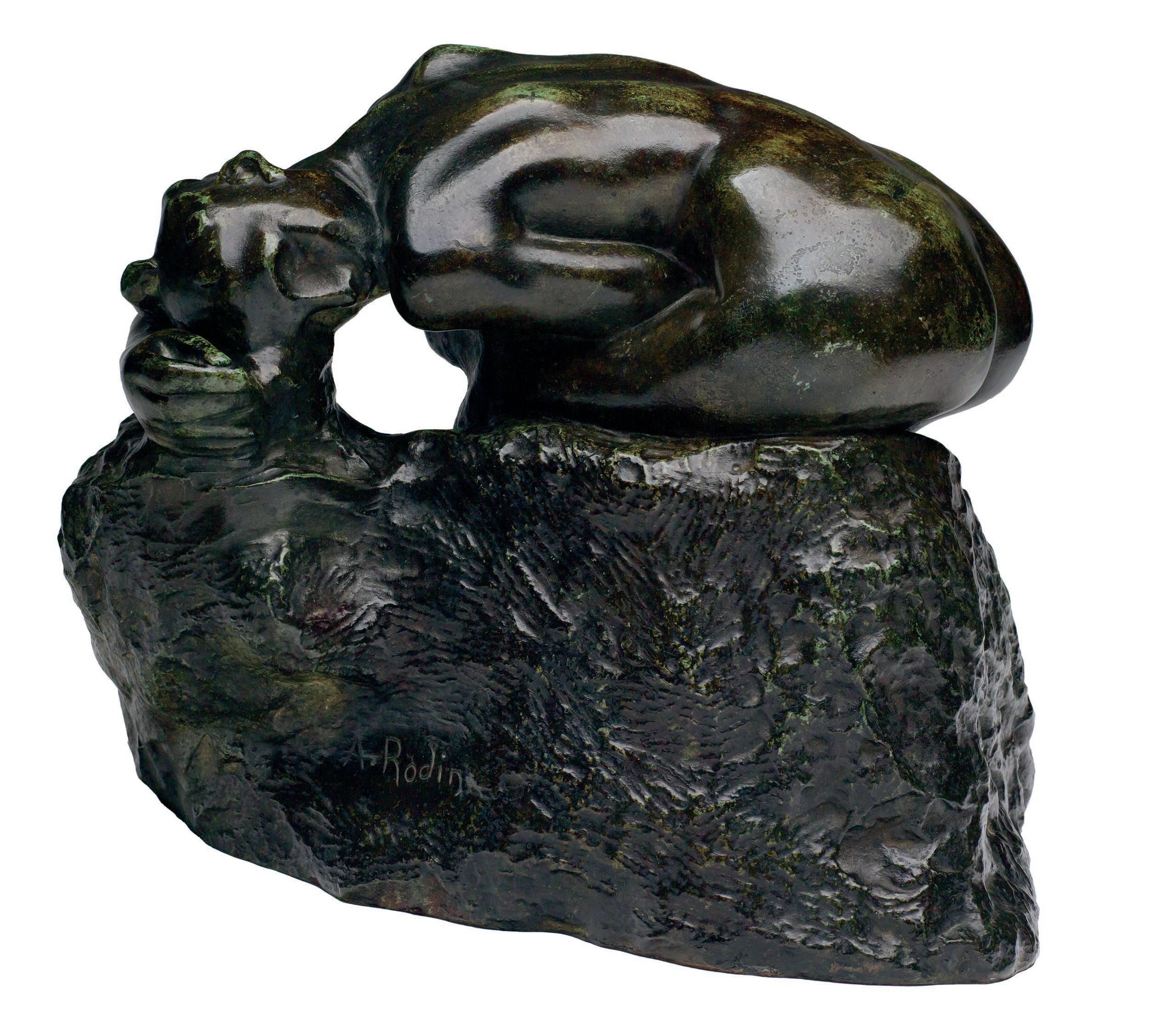
1840 – 1917 FR e NCH
Andromède
bronze sculpture, signed A. Rodin, inscribed with the foundry mark, Alexis Rudier Fondeur Paris and stamped with the artist’s signature, A. Rodin, on the inside of the bronze; this work was conceived in 1887 and cast in 1948
10 3/8 × 13 1/4 × 7 7/8 in, 26.4 × 33.7 × 20 cm
p rovenan C e
Musée Rodin, Paris, 1948
Acquired from the above by Galerie Huguette Berès, Paris, August 1952
Otto Gerson Gallery, New York
Canadian Art Galleries, Calgary, 1961
Hycroft Antiques, Vancouver
Acquired from the above by a Private Collector, Vancouver, 1981
By descent to the present Private Collection, Vancouver
e xhibited
Art Gallery of Greater Victoria, date unknown
A UGUSTE R O d IN IS considered the father of modern sculpture. He began as an Academic Realist, but turned to Symbolist
sculpture in the 1880s. Without wishing to oversimplify the Symbolist idiom, it was a late-nineteenth-century art movement, especially in France, that advocated the expression of ideas in art. Symbolist artists looked inwards—“the analysis of the self to the extreme,” as Gustave Kahn expressed it—with feelings and ideas now the starting point of works of art.1 Rodin was captivated by the human body. His brilliance lay in the ability to communicate inner truths (“the invisible”), as opposed to superficial, worldly appearances. Rodin frequently began a sculpture by drawing life models from various angles, often using a stepladder. He drew speedily, focusing laser-like on the subject—a technique that he referred to as “blind drawing”—to depict exactly what he saw in front of him. His drawings relied upon “sincere observation,” to help him to “pass over useless details and seize only upon the truth of the whole.”2 Andromède (modeled in 1885; carved in 1886, collection of the Rodin Museum, Philadelphia) is indicative of the sculptor’s use of intense scrutiny coupled with a powerful sense of psychological, Symbolist theatre.3
The rescue of Andromeda is recounted in a number of sources, most famously Ovid’s Metamorphoses (written circa 8 CE ). The fable has also been depicted by countless artists over the centuries. In Greek mythology, Andromeda—the beautiful daughter of the King and Queen of Aethiopia—is offered as a sacrifice to
64
the sea monster Cetus. Andromeda is chained to a rock to await her fate, but is rescued by Perseus, son of Zeus. This bowed, twisted figure, exposed and lying dejected on a weathered rock, expresses a key moment of profound emotional suffering in the tale of Andromeda. When first exhibited, however, the marble was left pseudonymous, leading some scholars to suggest that it purely represents the life model at rest in the studio—a pose that inspired its current theme and title: Andromède
Whatever the specific inspiration, Rodin’s work, to quote Leo Steinberg, was always about this kind of “adaptability.”4 In fact, the statue recalls a similar series of figures from the 1880s, including the unique cast of The Wave (circa 1885 – 1900, The Burrell Collection, Glasgow), where “two bodies twist and turn [ . and] the female figure seems to dive into the waves, her head dipping below the surface [ . . . and] giving her the identity of a mythical siren.” 5 Looking at the Andromède piece, her head and hair, right forearm, hand and leg likewise seem to merge with or issue out of the chiseled stone. In this way, Rodin heightens her sense of captivity and the concept of form as idea in sculpture. Or, as Michelangelo would have it, “liberating the figure from the marble that imprisons it.” 6 Notably, in Ovid’s Metamorphoses, Perseus initially mistakes Andromeda for a statue, and no actual chains appear in Rodin’s piece. In this context, it is clear that the artist is “in search of animate form” 7 by giving life—the moment of creation—to sculpture, a founding theory since antiquity.8
Drawing was at the heart of Rodin’s practice, aiding him when addressing form in sculpture. “It’s quite simple,” he once commented, “my drawings are the key to my work.” 9 Though Rodin’s success relied upon bronze, stone or marble versions of his sculpture, he was the greatest of clay modelers.10 Rodin fashioned the material into a mold, from which a plaster cast was rendered. Often, several casts were deemed model “originals,” from which a marble sculpture could be carved, or used to create a bronze cast. When required, many versions could be manufactured in bronze, at various times, keeping up with public demand for Rodin’s sculpture.
Casting involved working with specialist foundries such as the Fonderie Alexis Rudier, which cast our bronze Andromède. 11 The foundry worked to produce either lost-wax or sand casts—ancient processes stretching back millennia. Both techniques had advantages and disadvantages. The former technique catered for subtle changes because the sculptor was able to make eleventh-hour adjustments by carving directly into the wax model. Alternatively, the latter excluded any last-minute alterations, but the process itself is far more faithful to the original design. During the sand casting process, nonetheless, the plaster model is damaged, with sections frequently removed and cast independently. The lostwax process, conversely, did not damage the model, but actually reinforced the clay or plaster original.
The “assemblage” of individual works, both complete and in fragments, was another radical feature of Rodin’s art. He called this technique abatiss, originating from accidental breakages in the studio. The abattis were dismantled and reassembled in different combinations, so they were never part of any one sculpture. Ultimately, Rodin’s fragmented, reassembled bodies—including Polyphemus with the Head of a Slavic Woman (after 1900, Musée Rodin)—were in defiance of idealized notions of beauty and flawlessness. This was undeniably the most revolutionary feature of his practice, particularly the way he transformed his
works through fragmentation, assemblage and multiplication. As Sophie Biass-Fabiani has shown, it was a creative system of “metamorphoses” in order to manufacture “a common language, a generative syntax that allows for an infinite number of sentences to be made from a finite number of elements.” 12
We thank John Finlay, a historian of French history specializing in twentieth-century modern art, for contributing the above essay.
Rodin made at least 13 bronze proofs from the plaster for this sculpture, three casts of which were made by the Alexis Rudier Foundry between 1928 and 1949. Ten casts were made later by the Georges Rudier Foundry, between 1968 and 1980. This rare work cast in 1948 is one of the important three casts that were made by the Alexis Rudier Foundry between 1928 and 1949.
This work will be included in Brame & Lorenceau’s forthcoming Catalogue critique de l’oeuvre sculptée d’Auguste Rodin, under the direction of Jérôme le Blay, as catalogue #2022-6735 B . Included with this lot is a letter signed by François Lorenceau and Jérôme Le Blay from the Comité Auguste Rodin dated December 8, 2022 confirming the work’s inclusion.
1. Gustave Kahn, “Response to the Symbolists,” L’Evénément, September 28, 1886, cited in John Rewald, Post-Impressionism: From Van Gogh to Gauguin, rev. ed. (1956; London: Secker & Warburg, 1978), 12 (206).
2. William Harlan Hale, The World of Rodin (1962; Time-Life Books, 1972), 156.
3. Musée Rodin, Paris, owns the first marble version of this subject, made for the French art critic Roger Marx (1859–1913).
4. “No Rodin sculpture is known until it is known in its adaptability.” Leo Steinberg, “Rodin,” in Other Criteria: Confrontations with Twentieth-Century Art (New York: Oxford University Press, 1972), 377.
5. As Pippa Stevenson-Sit points out in Introducing Auguste Rodin: The Burrell Collection (Glasgow: Glasgow Museums Publishing, 2022), 55, Rodin included (circa 1887) a group of three sirens in the Gates of Hell (commissioned 1880–1917, Musée Rodin, Paris) as well as integrating the group into his Monument to Victor Hugo (Palais-Royal, Paris).
6. Hale, World of Rodin, 12.
7. Anne M. Wagner, “Material Transactions,” in The Making of Rodin, ed. Nabila Abdel Nabi, Chloé Ariot and Achim BorchardtHume (London: Tate Publishing, 2021), exhibition catalogue, 32.
8. “On sculptures that have later been cast in bronze, we often find his fingerprints and other marks that were embedded into the surface of the clay original, reminding us of the pliable, soft material that was worked by the artist.” Stevenson-Sit, Introducing Auguste Rodin, 41.
9. Ibid.
10. In Quand Rodin exposait (Paris: Éditions Musée Rodin, 1988), Alain Beausire demonstrates very clearly how plaster came to dictate the making of his sculpture. “In the years 1899–1900 exhibited plasters outnumbered bronzes by fivefold, and marbles more than twenty times.” Beausire’s research is summarized by Penélope Curtis, “The White Sanctuary,” Making of Rodin, 27.
11. For details regarding this (and other) bronze casts, see the paragraph following the essay.
12. Sophie Biass-Fabiani, “Rodin’s Metamorphoses,” in Metamorphoses: In Rodin’s Studio, ed. Nathalie Bondil and Sophie Biass-Fabiani (Montreal: Museum of Fine Arts; Paris: Musée Rodin, 2015), 26.
e stimate: $ 80,000 – 120,000
65
ARCA 1888 – 1970
Paysage Grande-Vallée

casein on board, signed and on verso signed, titled and inscribed caséine / M-36 / ORNN , 1949
36 x 48 in, 91.4 x 121.9 cm
p rovenan C e
Galerie L’Art français, Montreal
Private Collection
Art canadien et européen, Encans Pinneys, June 14, 2005, lot 179
Galerie Claude Lafitte, Montreal
Private Collection, Montreal
“Liste des prix,” Exposition Marc-Aurèle Fortin, Galerie Jean-Pierre Valentin Archives, 1949, Galerie L’Art français Documentary fund (1948 – 1954), titled as Grande-Vallée, vue d’est Rolland Boulanger, “M.-A. Fortin, décorateur,” Le Canada, Montreal, October 27, 1949, page 9
“L’Art Français Shows Paintings by Fortin,” The Gazette, Montreal, October 29, 1949, page 25
“Marc-Aurèle Fortin,” La Presse, Montreal, November 5, 1949
“Marc-Aurèle Fortin, A.R.C.A., Harry Mayerovitch, Paintings, Exhibition Gallery x II , March 26 – April 11, 1954,” Montreal Museum of Fine Arts, Archives Exhibitions Funds 1910 – 1950, March 26, 1954, MBAM -E 1
Guy Robert, Marc-Aurèle Fortin: l’homme à l’oeuvre, 1976, page 56
Jean-Claude Leblond, “Hommage à Marc-Aurèle Fortin,” Le Devoir, Montreal, December 4, 1976, page 33
66
iterature
l
131 Marc-Aurèle Fortin
Guy Robert, Fortin l’oeuvre et l’homme, 1982, page 90, dated 1952 incorrectly
Galerie Claude Lafitte, The Gazette, Montreal, October 15, 2005, page Life-3
Michèle Grandbois, Marc-Aurèle Fortin: The Experience of Colour, Musée national des beaux-arts du Québec, 2010, pages 183 and 257
Régis Tremblay, “Les couleurs de Marc-Aurèle Fortin au Musée national des beaux-arts,” Le Soleil, Quebec City, February 10, 2011, dated 1952 incorrectly e xhibited
Galerie L’Art français, Montreal, M.-A. Fortin, October 24 –November 5, 1949, titled as Grande-Vallée, vue d’est, catalogue #11
Montreal Museum of Fine Arts, Marc-Aurèle Fortin et Harry Mayerovitch, March 26 – April 11, 1954, catalogue #22
Gallery IV of the Entrance Hall of the Queen Elizabeth Hôtel, Montreal, Exhibition Marc-Aurèle Fortin R.C.A.A., December 12 – 19, 1958, catalogue #17
Musée national des beaux-arts du Québec, Quebec City, Marc-Aurèle Fortin: The Experience of Colour, February 10 –May 8, 2011, traveling to McMichael Canadian Art Collection, Kleinburg, May 28 – September 11, 2011, catalogue #107
M ARC -A UR èl E fORTIN ’ S PRO l I f IC career spanned half a century (1910 to 1960), during which his expressive power scarcely wavered until the very end, when diabetes complications and faltering eyesight made painting practically impossible. He was among the most important landscape artists of his time, and his contribution to Quebec and Canadian art is inestimable. From the beginning, and all through his career, Fortin espoused a specifically French Canadian and nationalistic art, rooted in the land and its people, in which he was part of a trend that dominated Quebec in the first four decades of the twentieth century. But a more progressive movement, open to the avant-garde ideas of the Paris School, was gaining force in Montreal at the same time, culminating in 1948 with the manifestos Prisme d’yeux, associated with Alfred Pellan, and Refus global, centring on Paul-Émile Borduas. Fortin was thus something of a paradox—stubbornly defending tradition even as his works shared the stylistic audacity of the Post-Impressionists, considered by Borduas’s champions of l’art vivant as the height of modernity. Critic Jean Chauvin, a little nonplussed by it all, allowed in 1927 that “what we might take for intentional effrontery, irreverence, or innovation is for him entirely uncalculated. [Fortin] paints from the heart, with no desire to cause scandal or make trouble.” 1 All doubt would at last be dispelled when Fortin was elected an associate of the Royal Canadian Academy of Arts in 1942. True to himself, he proudly accepted the recognition of that venerable academic institution so hated by Montreal’s partisans of modernity.
One way to encapsulate Fortin’s approach might be to examine the landscape themes running through it. First there are his vivid, expressive accounts of Sainte-Rose, the village where he was born, with its great elms. In contrast to that green paradise came Fortin’s views of Montreal—that large, fast-growing metropolitan centre. His engravings, watercolours and oils considered
industrial operations in its port and the construction of the Jacques Cartier Bridge as subjects. Then, after a trip of several months to France from 1933 to 1934, began the period of summer wanderings, that between 1936 and 1940 took him to the coast near Quebec City, Île d’Orléans, and Charlevoix. Next he painted the Gaspé Peninsula, from 1940 to 1945, and Saguenay, from 1945 to 1949. He then abandoned those long summer adventures, from which he would return with sketches and watercolours to transform into large canvas and board paintings back in his workshop. Beginning in 1940, his work began appearing regularly at Galerie L’Art français on Laurier Street West in Montreal.
In 1948, due to the Automatist manifesto Refus global, the demands of artists in Quebec became front-page news. Fortin however, unsurprisingly, remained aloof, continuing to practise what art historian David Karel described as “Modernist Regionalism.” 2 That year, Fortin, 60 years old and struggling with diabetes, contemplated the prospect of abandoning those extended explorations of outlying parts of the province he had made in the last dozen years. He did not, however, abandon the work on new plastic effects that had been central to his vision from the beginning. He first tried casein paint on the recommendation of his art supplies dealer, J.R. Crowley.” 3 “Fortin swears by casein,” reported Joseph Jutras, “he says it’s a wonder—like fresco in the olden days.” 4 Casein, the main protein in cow’s milk, is a powder that can be turned into milk paint, better known as casein tempera. It has been in use since ancient times, although in the sixteenth century it was gradually eclipsed by oils. In the twentieth century, however, it made a comeback. Canadian painters used it, including André Biéler, and in 1954 Alex Colville painted his famous Horse and Train (collection of the Art Gallery of Hamilton) in casein tempera.
“Fortin would buy boxes of powdered milk to mix with water and add to commercial colours in tubes,” reported René Buisson. “The combination got him denser impastos, which proved ideal for clouds.” 5 The period of Fortin’s work in oils on black and grey backgrounds (1936 to 1948) was over, and for him, the age of casein began in 1949. Fortin’s 1949 marriage to Gabrielle Goyette may also have made him more settled. He worked enthusiastically in the new medium, thrilled both by the matte colour surfaces and how quickly it dried. Fortin’s dazzling vision of Grande-Vallée [from the east], 6 painted in 1949, is emblematic of his final creative period from 1949 to 1955. It may be based on a watercolour of the scene from earlier in the decade, perhaps painted during a stopover in Grande-Vallée, a village in Gaspé on the shores of the St. Lawrence Estuary. Or perhaps on a sketch whose composition has been reworked and transformed into this virtuoso showpiece. There is no proof one way or the other. Sarah Mainguy, author of the Marc-Aurèle Fortin catalogue raisonné, records that Fortin first painted Grande-Vallée in oil, around 1945.7
Fortin’s astonishing vision shows us the raw wildness of Gaspé’s northern coastal headlands, with the tiny fishing and farming community settled there over the centuries. Paysage Grande-Vallée is a symphony of colours and motifs, inviting the viewer to examine each piece of this colossal jigsaw—rows of cod boats, rocky points jutting out into the sparkling waters,
67
sailboats on the horizon, roiling skies bubbling with massive cumulus clouds, blocks of mountains with their high summits stretched out of proportion and patchwork bands of farmland. Gable-roofed village houses cluster around the Catholic church of St. François-Xavier, unaltered since its construction in 1910. Unlike Fortin’s landscapes painted in oil, Paysage Grande-Vallée allows the underlying brown board to show through abundantly, replacing the black Fortin had formerly used to delineate forms. Fortin was also an incomparable watercolourist who used the bare paper to enhance forms. In Paysage Grande-Vallée, the support of wood joins with the new velvety, matte texture of the casein.
For Jean-René Ostiguy, curator of Canadian art at the National Gallery of Canada and curator of the 1964 Fortin retrospective there, Paysage Grande-Vallée displays “all the marks of true poetry.” 8 Forty-seven years later, this magistral work was again a centrepiece of the retrospective Marc-Aurèle Fortin: The Experience of Colour, put on by the Musée national des beaux-arts du Québec.
We thank Michèle Grandbois, editor of the book Marc-Aurèle Fortin: The Experience of Colour, for contributing the above essay, translated from the French.
1. Jean Chauvin, “Chez le peintre Marc-Aurèle Fortin,” La Revue populaire (Montreal) 20, no. 9 (September 1927): 11.
2. David Karel, André Biéler: At the Crossroads of Canadian Painting (Quebec City: Les Presses de l’Université Laval, 2004), 109–57.


3. Jean-Pierre Bonneville, “Les quatre-vingts ans de Marc-Aurèle Fortin,” La Frontière (Rouyn), March 13, 1968, 7–9.
4. Joseph Jutras to Ernest Aubin, November 16, 1950, Archives Joseph Jutras.
5. René Buisson, Marc-Aurèle Fortin: un maître inconnu (Montreal: Musée Marc-Aurèle Fortin, 1995), 95, cited in Marie-Claude Corbeil, Elizabeth Moffatt, Claude Belleau, Eric J. Henderson, and Jennifer Poulin, “Une étude des matériaux et techniques de Marc-Aurèle Fortin,” Journal of the Canadian Association for Conservation ( JCAC ) 43 (2018): 6.
6. We specify “from the east,” which is how the full title of the work appears in the prize list of the fall 1949 exhibition at Galerie L’Art français: Grande-Vallée, vue d’est. It is worth pointing out because the same exhibition featured another painting, at #13, Grande-Vallée, vue d’ouest (“from the west”). It’s painted on the same size board as our Paysage Grande-Vallée and figures in the catalogue raisonné along with the watercolour it was painted from.
7. Oil on particle board, 121.9 × 183 cm (presumably from a private collection), showing more or less the same point of view. Special thanks to Sarah Mainguy for her generous assistance in researching works that depict Grande-Vallée.
8. Jean-René Ostiguy, “Marc-Aurèle Fortin,” Vie des Arts (Montreal), no. 23, Summer 1961, 31.
e stimate: $ 400,000 – 600,000
68
detail detail
132 Alfred Joseph (A.J.) Casson
CGP CSPWC G7 OC POSA PRCA 1898 – 1992
Autumn Tapestry oil on canvas, signed and on verso signed, titled, dated 1979 on the artist’s label and inscribed 9249 H 24 × 30 in, 61 × 76.2 cm
p rovenan C e
Peter Ohler Fine Arts Ltd., Vancouver
Private Collection, Vancouver
Fine Canadian Art, Heffel Fine Art Auction House, May 24, 2017, lot 152
Private Collection, Toronto
l iterature
Ted Herriott, Sunday Morning with Cass: Conversations with A.J. Casson, 1993, page 137
By 1974 , A.J. CASSON was the last surviving member of the Group of Seven. He was the recipient of many honours, and his
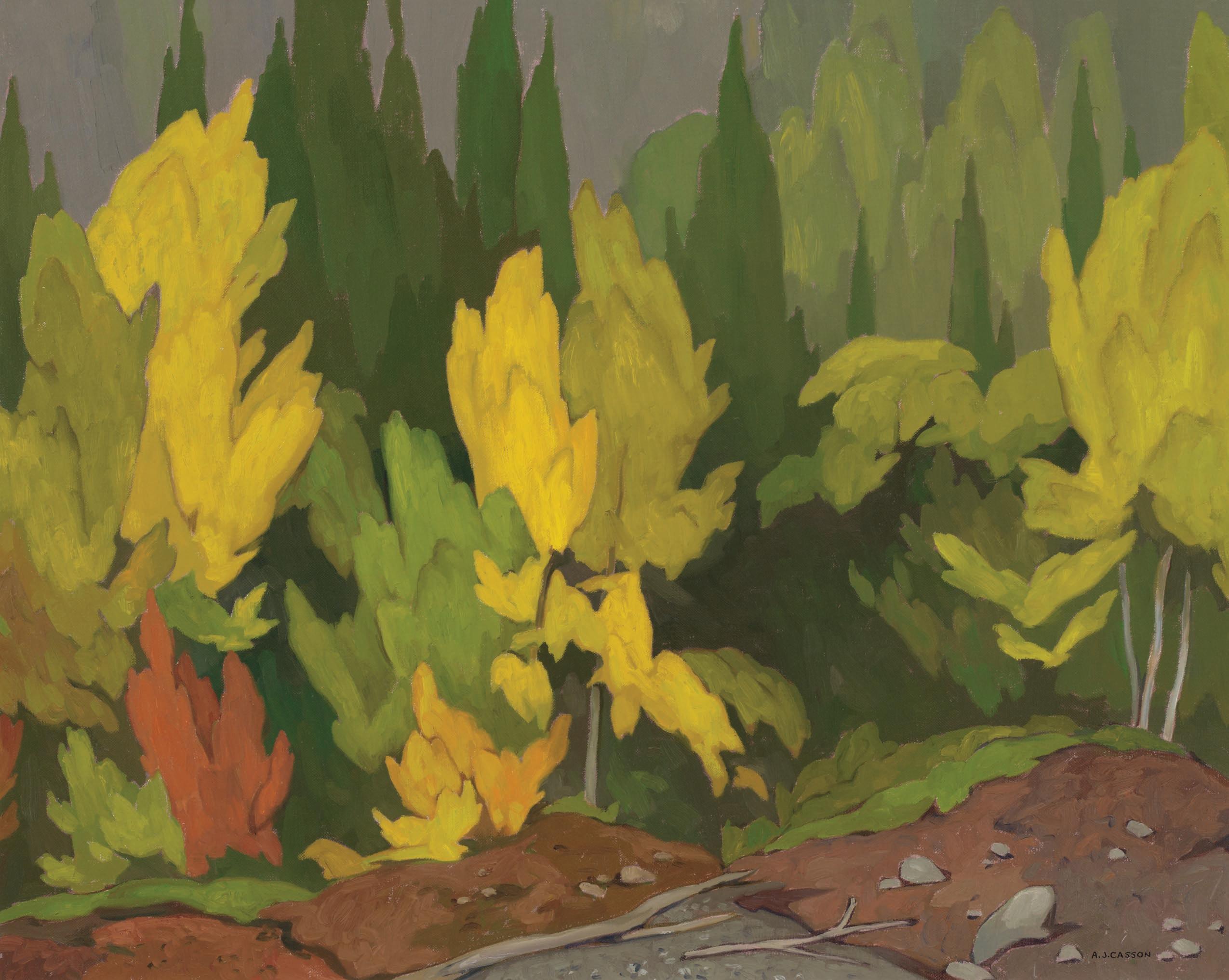
works were avidly pursued by collectors. Casson’s prime focus was Ontario, from its rural villages to its wilderness, and he explored the province extensively. This formed his identity within the Group and was his lifelong commitment. Autumn was Casson’s favourite season, as he stated, “not for the colour alone, but for the weather, the skies . ” In this vibrant, impressive canvas, Casson’s keen eye for composition is evident throughout this close-up forest view. He has contrasted the warm fall colours transforming the woods with dark evergreens and a grey misty background inhabited by shadowy tree forms. Autumn trees are depicted as flame-like shapes, emphasized by upturned branch tips, a stylization that gives the scene the impression of movement and warmth. In the foreground, rock ledges create an open space, from which the viewer can contemplate the dense woods. In Autumn Tapestry, Casson has captured the primordial beauty of this scene, making us feel the cool, fresh air and the deep stillness.
e stimate: $ 40,000 – 60,000
69
133 David Brown Milne
CGP CSGA CSPWC 1882 – 1953
White Ash Tree
oil on canvas, signed, dated October 19, 1922 and inscribed MR and on verso titled Clarke’s House, dated by Douglas Duncan and inscribed 0-37 and 0-79 (crossed out) 12 × 16 in, 30.5 × 40.6 cm

p rovenan C e
Douglas Duncan Picture Loan Society, circa 1965
Private Collection, Toronto
By descent to the present Private Collection, Vancouver
l iterature
David Milne Jr. and David P. Silcox, David B. Milne: Catalogue Raisonné of the Paintings, Volume 1: 1882 – 1928 , 1998, reproduced page 367, catalogue #204.92
I N 1921 , dAVI d MI l NE accepted an offer of a friend from his student days, Howard Sherman, a commercial artist in New York, to stay for the winter at his house in Mount Riga, a tiny hamlet south
of Boston Corners. While doing some carpentry in exchange for living there, Milne set to work painting and produced a steady output. He also began making accomplished colour drypoint prints. In spring of 1922, Milne took a break from painting to scout the Adirondacks for jobs, as he needed income, but in the fall he returned to Mount Riga to this same house, which had been bought in March by Milne’s friend James Clarke. Milne soon found his creative pulse again, painting his evolving renovations of Clarke’s house, as well as the surrounding countryside.
While in Mount Riga, Milne worked on his painting techniques, such as drawing in the paint with his brush handle, working tints into the paint while it was still wet, and layering to develop textures. In White Ash Tree, Milne used hues close in tone—greens and greys—for the major colour areas, softly rubbing them together for a textural effect. He used strong coloured outlines to define his forms, and highlights of blue, red, gold and purple enliven the tonal palette. White Ash Tree is a sophisticated work, painted with sensitivity and confidence.
e stimate: $ 30,000 – 40,000
70
134 David Brown Milne
CGP CSGA CSPWC 1882 – 1953
Landing on the Rock
watercolour on paper, signed and dated 1938 and on verso titled, dated on the gallery labels and inscribed by Douglas Duncan W.56 and #452 by the Duncan estate 14 × 19 3/4 in, 35.6 × 50.2 cm
p rovenan C e
Galerie Agnès Lefort, Montreal
Marlborough-Godard, Montreal
By descent to the present Private Collection, British Columbia
l iterature
David P. Silcox, Painting Place: The Life and Work of David B. Milne, 1996, pages 281 and 284
David Milne Jr. and David P. Silcox, David B. Milne: Catalogue Raisonné of the Paintings, Volume 2: 1929 – 1953 , 1998, reproduced page 665, catalogue #306.30

I N 1938 , dAVI d M I l NE was living in the isolated cabin at Six Mile Lake that he had built in 1933. He did not produce any oils
that year and instead concentrated on watercolour, a medium he had abandoned in 1925. His style had evolved, and David Silcox wrote: “Unlike his last watercolours in 1925, which were rich, reserved, and austere . . . the new ones were fluid, reminiscent of the most vigorous and experimental excursions of Milne’s New York years and recalling his wide, bright palette of that time in their splashy variety of colour.” Milne “now ‘thought’ in watercolour.” His paintings were fresh and immediate, and he reveled in the freedom of a certain roughness facilitated by his speed of execution—which can be seen in Landing on the Rock, with its dark-grey washes in the rock formations. While these grey washes give the impression of mass, Milne lets in space by interspersing some areas of unpainted paper, and in contrast the water is also unpainted. Milne’s canoe is drawn up on the shore, and he has created a charming outdoor still life of his day camp with coffee pot, glasses and painting supplies scattered casually on the rocks. These objects are painted with bright pops of colour amid the grey, giving a vivacity to this picture of Milne’s creative life in the natural setting of Six Mile Lake.
e stimate: $ 30,000 – 40,000
71
135 Cornelius David Krieghoff
1815 – 1872
Crossing the Mail at Quebec oil on canvas, signed and dated 1861 and on verso titled and inscribed C 219 and 64-185 on a label 9 × 14 in, 22.9 × 35.6 cm
p rovenan C e Laing Galleries, Toronto
A Prominent Montreal Estate
C ORNE l IUS K RIEGHO ff WAS living in Quebec City in 1861, and here he depicts the transport of mail by canoe across the frozen St. Lawrence River. The St. Lawrence in winter was treacherous, with open stretches of freezing water and large expanses of uneven ice, heaved up into chunks. The efforts of many men were required to drag a canoe such as this over the ice, and here they are exhorted on by the gesticulating figure on the bow. At the

back of the boat is the Red Ensign—an indication that the postal service provider was the Royal Mail, an assertion of British sovereignty at the time. In 1867, after Confederation, the post office was one of the first federal government departments formed, and it took over the postal service in April of 1868.
Krieghoff’s striking panoramic view is dominated by the sky, painted with softly modulated strips of coral, mauve and gold, created by the sun reflecting on atmospheric haze. The artist also showed his sensitivity to colour in the ice, tinted with cool greens and blues, and warm pink and mauve. Besides being a stunning landscape, Crossing the Mail at Quebec is a fascinating record of the challenges of everyday life during the winter in early Canada.
e stimate: $ 30,000 – 50,000
72
136 Cornelius David Krieghoff
1815 – 1872
Bears in the Woods, Quebec oil on canvas, signed, dated 1859 and inscribed Quebec and on verso titled on a label and inscribed 20511-1 14 1/4 × 18 1/8 in, 36.2 × 46 cm

p rovenan C e
A Prominent Montreal Estate
l iterature
J. Russell Harper, Krieghoff, 1999, page 59
fROM 1853 TO 1863, Cornelius Krieghoff was living in Quebec City, and these were his most productive years. Quebec City was a lively scene for the artist—Krieghoff had many friends and admirers, and his work sold easily. As Russell Harper stated, “His keen wit and buoyantly infectious spirit, his understanding of his
audience’s tastes, and his versatility in themes combined to give his paintings of this period a popular appeal unrivalled by any other Canadian artist of the century.”
The surrounding countryside provided rich subject matter, and Krieghoff often engaged in hunting and fishing trips. Wild animals were sometimes the focal point of his landscapes, such as deer and moose and, in this finely detailed work, bears. The viewer can sense Krieghoff’s wit in this painting, in the bears’ investigation of the base of some trees, likely hoping to discover something to eat, as the fall colours presage the arrival of winter and hibernation. This work includes a spectacular lighting effect— the low sun, shining through the thick vegetation, is reflected back in the surface of a small pond. Bears in the Woods, Quebec has a romantic atmosphere, in which the bears gambol peacefully in a striking landscape glowing with fall hues under a sky delicately tinted with pastels.
e stimate: $ 30,000 – 50,000
73
137 Cornelius David Krieghoff
1815 – 1872
Moccasin Seller with Papoose
Crossing the Ice oil on canvas, signed and on verso titled on the gallery label 11 × 9 in, 27.9 × 22.9 cm
p rovenan C e
Galerie Walter Klinkhoff Inc., Montreal
A Prominent Montreal Estate
l iterature
Dennis Reid, Krieghoff: Images of Canada, Art Gallery of Ontario, 1999, a similar work entitled Indian Woman, Moccasin Seller, circa 1855, in the Thomson Collection, Art Gallery of Ontario, reproduced page 168
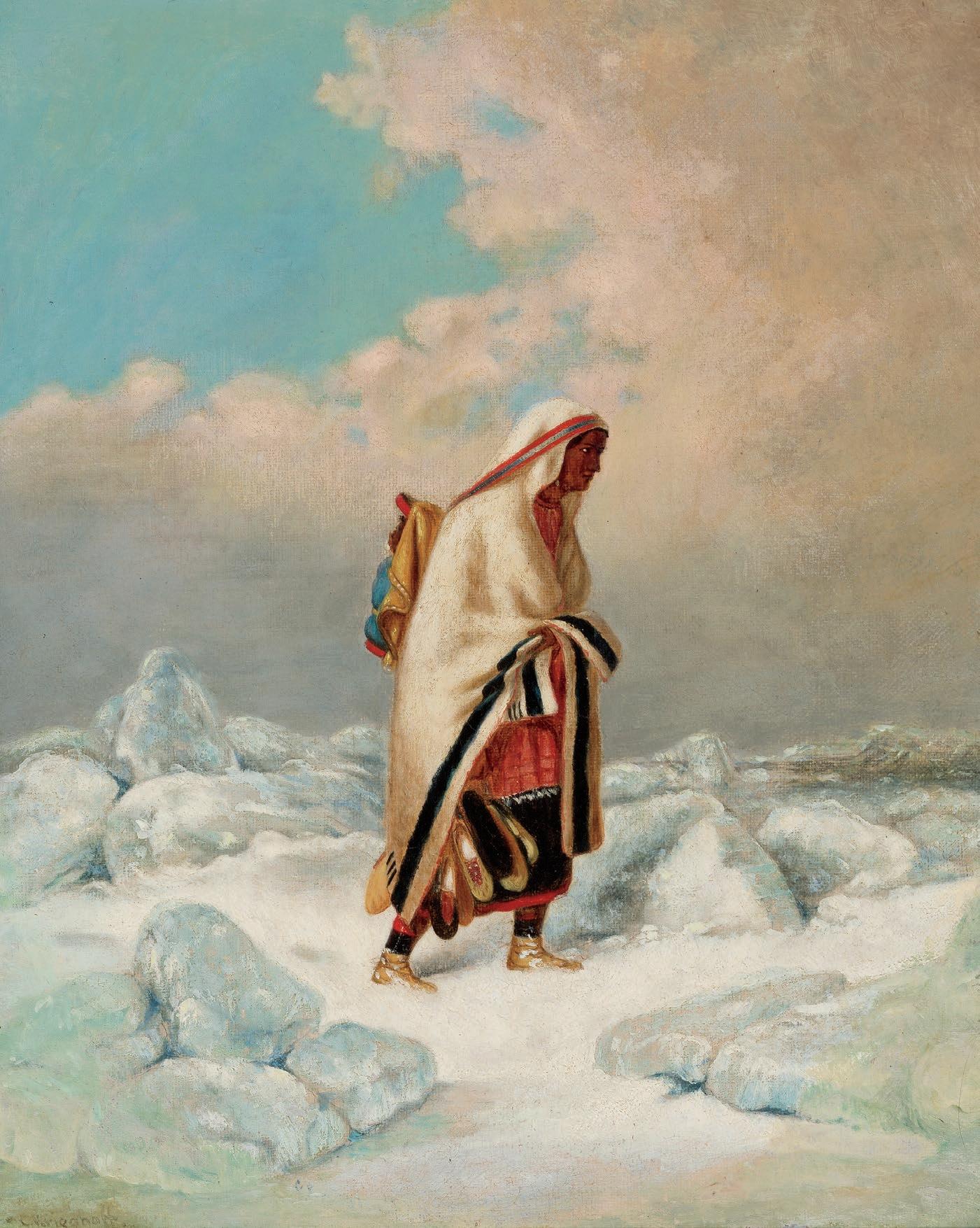
W HI l E C ORNE l IUS K RIEGHO ff lived in Quebec City, he observed Indigenous women traveling to the city on foot in all seasons to sell their handiwork, such as baskets and moccasins. Some distance away was a Huron village at Lorette, where craftspeople in a small factory produced items such as snowshoes, toboggans, paddles, beadwork and basketry for sale.
This is an especially finely worked piece from Krieghoff’s genre of small single-figure portraits of Indigenous women and men. It is painted with superb technique in meticulous detail, such as in the exquisitely rendered ice cakes on the frozen St. Lawrence River, defined with subtle tones of blue, green and grey. Their three-dimensionality is emphasized by deeper blue shadows in crevices and at their bases. The smooth snowy path the woman is traversing provides a bright contrast to the red and orange in her clothing as well as the blue cloth her child is wrapped in on her back. Krieghoff even includes small patches of snow kicked up from the path on her golden footwear. Pairs of moccasins hang from her waist, each different in their colour and beadwork. Finally, Krieghoff’s sky is sublime—cloud formations billow up, greyish and foglike above the ice, then bloom with gold and pink at the top, parting to reveal the glorious blue firmament beyond.
e stimate: $ 15,000 – 25,000
74
138 Cornelius David Krieghoff
1815 – 1872
Indian Hunter on Snowshoes oil on canvas, signed and on verso titled and inscribed with the Dominion Gallery Inventory #F 7626 on the gallery label and stamped Dominion Gallery
11 1/4 × 9 1/8 in, 28.6 × 23.2 cm
p rovenan C e
Dominion Gallery, Montreal
A Prominent Montreal Estate
l iterature
Dennis Reid, Krieghoff: Images of Canada, Art Gallery of Ontario, 1999, a very similar 1858 canvas entitled Indian Trapper on Snowshoes reproduced page 175, and a very similar 1866 canvas entitled The Indian Hunter reproduced page 184, both in the Thomson Collection, Art Gallery of Ontario
i ndi A n Hun T e R on S now SH oe S was painted during the time Cornelius Krieghoff lived in Quebec City, from 1853 to 1863. First Nations peoples were seen in the city and the surrounding countryside, where the men at the Huron Village of Lorette, 13 kilometres away up the St. Charles River, continued to hunt and trap. Krieghoff often observed them, and he and his friends hired them as guides for their hunting and fishing trips. Small portraits such as this one, staged in a landscape setting, were popular with local merchants and British military officers as remembrances of time spent in Canada.
Krieghoff was known for his attention to detail and his authentic portrayals of the clothing of Indigenous people. This hunter is wearing a red tam and a Hudson’s Bay blanket coat tied with a red sash, characteristic of the people of Lorette and Caughnawaga who hunted in the Laurentians. Elements such as the pipe, tasseled moccasins and snowshoes are finely painted. The romanticized landscape, with mountains and an expansive sky with billowing cloud effects rising into a pale blue firmament, exemplifies Krieghoff’s sublime mastery of atmosphere.
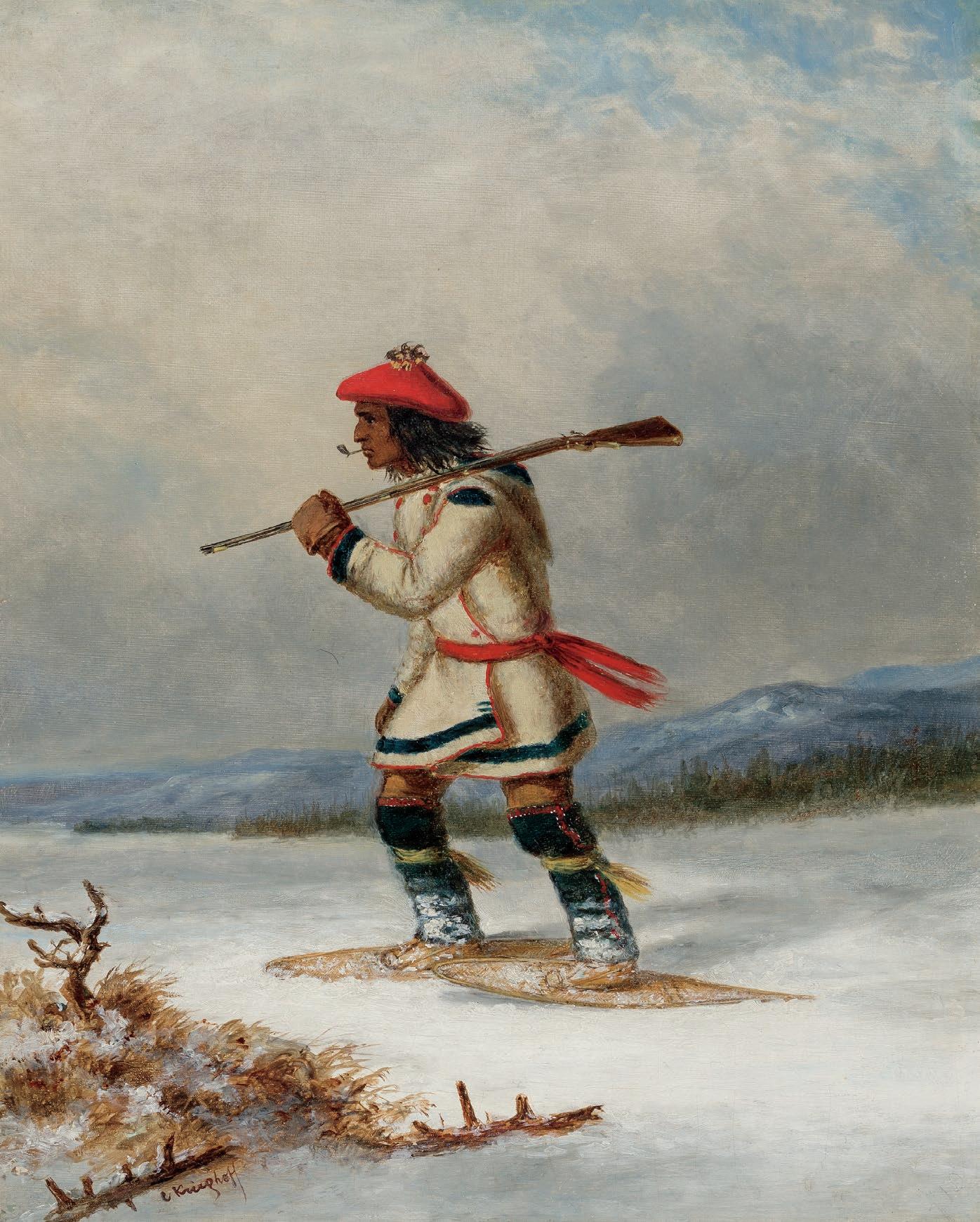
Two similar and iconic paintings of the solitary Indigenous hunter reside in the Thomson Collection at the Art Gallery of Ontario.
e stimate: $ 15,000 – 25,000
75
With the largest and most experienced team of fine art specialists in Canada, it is our mission to provide transparent and superior client service to sellers and buyers of fine art globally.


























76 montreal Tania Poggione Director of Montreal Office and Senior Specialist Jasmin D a igle Manager of Imaging, Montreal m arie-Hélène B usque Co-Director of Online Auctions, Consignment Specialist r ania C H a DD a D Senior Administrator, Consignment Specialist Jo H n m a C lean Manager of Facilities, Montreal, Art Handler r o B er T C. s . Heffel Vice-President Davi D K.J. Heffel President toronto Ju D i TH sC olni K Past Director, Consignment Specialist a n D ers o inonen Art Handler l in D say Ja CK son Director of Appraisals, Eastern Division, Consignment Specialist m ar T ie g iefer T Director of Imaging; Collector Motorcycle Specialist Kris T ian m ar T in Senior Administrator, Consignment Specialist m elina r ym B erg Manager of Toronto Office, Consignment Specialist re B e CC a r y K iss National Director, Brand and Communications Daniel g allay Consignment Specialist wo JC ie CH ole J ni K Art Handler
f ine a
g ra H am H all Art Handler an TH ony wu Asian Art Specialist ro CH elle K onn Consignment Specialist m aTTH ew sC arafile Client Services and Administration ale C K err Client Services and Administration, Consignment Specialist gor D on B u T ler Director of Art Handling and Storage Facilities m aTH ieu l a C roix Art Handler alix D e sain T- Hilaire Client Services and Administration T H omas Tang Art Handler a P ril yin Consignment Specialist, Administrator
rt s pe C ialists



























77 o ttawa an D rew gi BB s Director of Ottawa Office, Consignment Specialist Calgary r osalin Te o mra Director of Art Research PaT sy Kim Heffel Corporate Director l auren KraT zer National Director of Consignments Bo BB y m a Master Framer, Manager of Storage Facility, North Vancouver g oran u rosevi C Director of Information Services Jare D Tiller Manager of Online Auctions, Calgary, Consignment Specialist D eir D re H ofer Consignment and Appraisal Specialist nor B er T m a Controller K ir B i Pi TT Director of Marketing, Consignment Specialist m olly Ton K en Manager of Calgary Office, Consignment Specialist D ouglas waTT Art Handler m ere D i TH longri D ge Senior Finance Manager Clara w ong Director of Information Management, Consignment Specialist n orth van C ouver s H erry wang Client Services and Administration Kevin o e H en Art Handler g regg Casselman Art Handler Jos H Heffel Numismatics Client Services van C ouver Julia Balazs Manager of Vancouver Office, Consignment Specialist w ar D Bas T ian Manager of Imaging and Manager of Facilities, Vancouver m ar T in Burian Chief Financial Officer TH i B aulT B enne TT Co-Director of Online Auctions, Consignment Specialist ainsley H effel Manager of Appraisal Services, Consignment Specialist s e TH m en D oza Art Handler Cyn TH ia Tai Client Services and Administration KaT rina C H eng Manager of Heffel Numismatics ryan H effel Art Handler
T HESE TeRmS And Condi T ion S of Bu S ine SS represent the terms upon which the Auction House contracts with the Consignor and, acting in its capacity as agent on behalf of the Consignor, contracts with the Buyer. These Terms and Conditions of Business shall apply to the sale of the Lot by the Auction House to the Buyer on behalf of the Consignor, and shall supersede and take precedence over any previously agreed Terms and Conditions of Business. These Terms and Conditions of Business are hereby incorporated into and form part of the Consignment Agreement entered into by the Auction House and the Consignor.
a d efined t erms
1. Auction House
The Auction House is Heffel Gallery Limited, or an affiliated entity;
2. Consignor
The Consignor is the person or entity named in the Consignment Agreement as the source from which the Property or Lot has been received for auction;
3. Seller’s Commission
The Seller’s Commission is the amount paid by the Consignor to the Auction House on the sale of a Lot, which is calculated on the Hammer Price, at the rates specified in writing by the Consignor and the Auction House on the Consignment Agreement Form, plus applicable Sales Tax and Expenses;
4. Property
The Property is any Property delivered by the Consignor to the Auction House to be placed in the auction sale held by the Auction House on its premises, online or elsewhere and, specifically, that Property described by Lot number in the Auction House catalogue for the auction sale. The Auction House will have the authority to partition the Property into Lots (the “Lots” or “Lot”);
5. Reserve
The Reserve is a confidential minimum price for the sale of the Lot, agreed to between the Consignor and the Auction House. The Reserve will not exceed the low estimate;
6. Knocked Down
Knocked Down means the conclusion of the sale of the Lot being auctioned by the Auctioneer;
7. Expenses
Expenses shall include all costs incurred, directly or indirectly, in relation to the consignment and sale of the Lot;
8. Hammer Price
The Hammer Price is the price at which the Auctioneer has Knocked Down the Lot to the Buyer;
9. Buyer
The Buyer is the person, corporation or other entity or such entity’s agent who bids successfully on the Lot at the auction sale;
10. Purchase Price
The Purchase Price is the Hammer Price and the Buyer’s Premium, applicable Sales Tax and additional charges and Expenses, including expenses due from a defaulting Buyer;
11. Buyer’s Premium
The Buyer’s Premium is the amount paid by the Buyer to the Auction House on the purchase of a Lot, which is calculated on the Hammer Price as follows: a rate of twenty-five percent (25%) of the Hammer Price of the Lot up to and including $ 25,000; plus twenty percent (20%) on the part of the Hammer Price over $ 25,000 and up to and including $ 5,000,000; plus fifteen percent (15%) on the part of the Hammer Price over $ 5,000,000, plus applicable Sales Tax;
12. Sales Tax
Sales Tax means Federal and Provincial sales, excise and other taxes applicable to the sale of the Lot, applied using place of supply rules required by Canadian taxation authorities. QST will be levied on all purchases collected in Quebec or shipped to Quebec;
13. Registered Bidder
A Registered Bidder is a bidder who has fully completed the registration process, provided the required information to the Auction House and has been assigned a unique paddle number for the purpose of bidding on Lots in the auction;
14. Proceeds of Sale
The Proceeds of Sale are the net amount due to the Consignor from the Auction House, which shall be the Hammer Price less Seller’s Commission at the Published Rates, Expenses, Sales Tax and any other amounts due to the Auction House or associated companies;
15. Live and Online Auctions
These Terms and Conditions of Business apply to all live and online auction sales conducted by the Auction House. For the purposes of online auctions, all references to the Auctioneer shall mean the Auction House and Knocked Down is a literal reference defining the close of the auction sale.
b
t he b uyer
1. The Auction House
The Auction House acts solely as agent for the Consignor, except as otherwise provided herein.
2. The Buyer
a) The Buyer is the highest Registered Bidder acknowledged by the Auctioneer as the highest bidder at the time the Lot is Knocked Down;
78
t erms and Conditions of b usiness
b) The Auctioneer has the right, at their sole discretion, to reopen a Lot if they have inadvertently missed a Bid, or if a Registered Bidder, immediately at the close of a Lot, notifies the Auctioneer of their intent to Bid;
c) The Auctioneer shall have the right to regulate and control the bidding and to advance the bids in whatever intervals they consider appropriate for the Lot in question;
d) The Auction House shall have absolute discretion in settling any dispute in determining the successful bidder;
e) The Buyer acknowledges that invoices generated during the sale or shortly after may not be error free, and therefore are subject to review;
f) Every Registered Bidder shall be deemed to act as principal unless the Auction House has acknowledged in writing at least two (2) business days prior to the date of the auction that the Registered Bidder is acting as an agent on behalf of a disclosed principal and such agency relationship is acceptable to the Auction House;
g) In order to become a Registered Bidder, the registration process shall be completed in full, and the required information shall be provided to the Auction House. Every Registered Bidder will be assigned a unique paddle number (the “Paddle”) for the purpose of bidding on Lots in the auction. Those interested in bidding in the live auction via telephone bid, absentee bid or through the Digital Saleroom shall register at least two (2) business days in advance of the auction. For online auctions, a password will be created for use only in current and future online auctions. This online registration procedure does not allow for participation in the live auction and may require up to two (2) business days to complete;
h) Every Registered Bidder acknowledges that once a bid is made with their Paddle, or Paddle and password, as the case may be, it may not be withdrawn without the consent of the Auctioneer, who, in their sole discretion, may refuse such consent; and
i) Every Registered Bidder agrees that if a Lot is Knocked Down on their bid, they are bound to purchase the Lot for the Purchase Price.
3. Buyer’s Price
The Buyer shall pay the Purchase Price (inclusive of the Buyer’s Premium) and applicable Sales Tax to the Auction House. The Buyer acknowledges and agrees that the Auction House may also receive a Seller’s Commission.
4. Sales Tax Exemption
All or part of the Sales Tax may be exempt in certain circumstances if the Lot is delivered outside of the jurisdiction of sale of the Lot. It is the Buyer’s obligation to demonstrate, to the satisfaction of the Auction House, that such delivery or removal results in an exemption from the relevant Sales Tax legislation. Shipments out of the jurisdiction of sale of the Lot(s) shall only be eligible for exemption from Sales Tax if shipped directly from the Auction House with shipping contracted by the Auction House. All claims for Sales Tax exemption must be made prior to or at the time of payment of the Purchase Price. Sales Tax will not be refunded once the Auction House has released the Lot. The Buyer agrees and shall fully indemnify the Auction House for any amount
claimed by any taxing authority due as Sales Tax upon the sale of the Lot, including any related costs, legal fees, interest and penalties.
5. Payment of the Purchase Price
a) The Buyer shall:
(i) unless they have already done so, provide the Auction House with their name, address and banking or other suitable references as may be required by the Auction House; and
(ii) make payment by 4:30 p.m. on the seventh (7th) day following the auction by: a) Bank Wire direct to the Auction House’s account, b) Certified Cheque or Bank Draft, c) Personal or Corporate Cheque, d) Debit Card and Credit Card only by Visa, Mastercard or Union Pay or e) Interac e-Transfer. Bank Wire payments should be made to the Royal Bank of Canada as per the account transit details provided on the invoice. All Certified Cheques, Bank Drafts and Personal or Corporate Cheques must be verified and cleared by the Auction House’s bank prior to all purchases being released. Credit Card payments are subject to our acceptance and approval and to a maximum of $ 5,000 if the Buyer is providing their Credit Card details by fax or to a maximum of $ 25,000 per Lot purchased if paying online or if the Credit Card is presented in person with valid identification. The Buyer is limited to two e-Transfers per Lot and up to a maximum of $ 10,000 per e-Transfer as per the instructions provided on the invoice. In all circumstances, the Auction House prefers payment by Bank Wire.
b) Title shall pass, and release and/or delivery of the Lot shall occur, only upon payment of the Purchase Price by the Buyer and receipt of cleared funds by the Auction House.
6. Descriptions of Lot
a) All representations or statements made by the Auction House, or in the Consignment Agreement, or in the catalogue or other publication or report as to the authorship, origin, date, age, size, medium, attribution, genuineness, provenance, condition or estimated selling price of the Lot are statements of opinion only. The Buyer agrees that the Auction House shall not be liable for any errors or omissions in the catalogue or any supplementary material produced by the Auction House;
b) All photographic representations and other illustrations presented in the catalogue are solely for guidance and are not to be relied upon in terms of tone or colour or necessarily to reveal any imperfections in the Lot;
c) Many Lots are of an age or nature which precludes them from being in pristine condition. Some descriptions in the catalogue or given by way of condition report make reference to damage and/or restoration. Such information is given for guidance only and the absence of such a reference does not imply that a Lot is free from defects, nor does any reference to particular defects imply the absence of others;
d) The prospective Buyer must satisfy themselves as to all matters referred to in a), b) and c) of this paragraph by inspection, other investigation or otherwise prior to the sale of the Lot. The Buyer acknowledges that the Buyer has not relied on the Auction House, its statements or descriptions in regard to determining whether or not to purchase a Lot. The Buyer understands it is incumbent upon the Buyer to inspect the Lot
79
and hire any necessary experts to make the determination as to the nature, authenticity, quality and condition of any Lot. If the prospective Buyer is unable to personally view any Lot, the Auction House may, upon request, e-mail or fax a condition report describing the Lot to the prospective Buyer. Although the Auction House takes great care in executing such condition reports in both written and verbal format, condition reports are only matters of opinion, are non-exhaustive, and the Buyer agrees that the Auction House shall not be held responsible for any errors or omissions contained within. The Buyer shall be responsible for ascertaining the condition of the Lot; and
e) The Auction House makes no representations or warranties to the Buyer that the Buyer of a Lot will acquire any copyright or other reproduction right in any purchased Lot.
7.
Purchased Lot
a) The Buyer shall collect the Lot from the Auction House by 4:30 p.m. on the seventh (7th) day following the date of the auction sale, after which date the Buyer shall be responsible for all Expenses until the date the Lot is removed from the offices of the Auction House;
b) All packing, handling and shipping of any Lot by the Auction House is undertaken solely as a courtesy service to the Buyer, and will only be undertaken at the discretion of the Auction House and at the Buyer’s risk. Prior to all packing and shipping, the Auction House must receive a fully completed and signed Shipping Authorization Form for Property and payment in full of all purchases; and
c) The Auction House shall not be liable for any damage to glass or frames of the Lot and shall not be liable for any errors or omissions or damage caused by packers and shippers, whether or not such agent was recommended by the Auction House.
8. Risk
a) The purchased Lot shall be at the Consignor’s risk in all respects for seven (7) days after the auction sale, after which the Lot will be at the Buyer’s risk. The Buyer may arrange insurance coverage through the Auction House at the then prevailing rates and subject to the then existing policy; and
b) Neither the Auction House nor its employees nor its agents shall be liable for any loss or damage of any kind to the Lot, whether caused by negligence or otherwise, while any Lot is in or under the custody or control of the Auction House. Proceeds received from the insurance shall be the extent of the Auction House’s liability for any loss, damage or diminution in value.
9. Non-payment and Failure to Collect Lot(s)
If the Buyer fails either to pay for or to take away any Lot by 4:30 p.m. on the seventh (7th) day following the date of the auction sale, the Auction House may in its absolute discretion be entitled to one or more of the following remedies without providing further notice to the Buyer and without prejudice to any other rights or remedies that the Auction House or the Consignor may have:
a) To issue judicial proceedings against the Buyer for damages for breach of contract together with the costs of such proceedings on a full indemnity basis;
b) To rescind the sale of that or any other Lot(s) sold to the Buyer;
c) To resell the Lot or cause it to be resold by public or private sale, or by way of live or online auction, with any deficiency to be claimed from the Buyer and any surplus, after Expenses, to be delivered to the Buyer;
d) To store the Lot on the premises of the Auction House or third-party storage facilities with Expenses accruing to the account of the Buyer, and to release the Lot to the Buyer only after payment of the Purchase Price and Expenses to the Auction House;
e) To charge interest on the Purchase Price at the rate of five percent (5%) per month above the Royal Bank of Canada base rate at the time of the auction sale and adjusted month to month thereafter;
f) To retain that or any other Lot sold to or consigned by the Buyer at the same or any other auction and release the same only after payment of the aggregate outstanding Purchase Price;
g) To apply any Proceeds of Sale of any Lot then due or at any time thereafter becoming due to the Buyer towards settlement of the Purchase Price, and the Auction House shall be entitled to a lien on any other property of the Buyer that is in the Auction House’s possession for any purpose;
h) To apply any payments made by the Buyer to the Auction House towards any sums owing from the Buyer to the Auction House without regard to any directions received from the Buyer or their agent, whether express or implied;
i) In the absolute discretion of the Auction House, to refuse or revoke the Buyer’s registration in any future auctions held by the Auction House; and
j) All the above rights and remedies granted to the Auction House may be assigned to the Consignor at the Auction House’s discretion. Further, the Auction House may disclose to the Consignor the Buyer’s identity, contact information and other such information as the Consignor may need in order to maintain a claim against the Buyer for non-payment.
10. No Warranty
The Auction House, its employees and agents shall not be responsible for the correctness of any statement as to the authorship, origin, date, age, size, medium, attribution, genuineness or provenance of any Lot or for any other errors of description or for any faults or defects in any Lot, and no warranty whatsoever is given by the Auction House, its employees or agents in respect of any Lot, and any express or implied conditions or warranties are hereby excluded.
11. Attendance by Buyer
a) Prospective Buyers are advised to inspect the Lot(s) before the sale, and to satisfy themselves as to the description, attribution and condition of each Lot. The Auction House will arrange suitable viewing conditions during the preview preceding the sale, or by private appointment;
b) If prospective Buyers are unable to personally attend the live auction, telephone bid, or bid in the Digital Saleroom, the Auction House will execute bids on their behalf subject to completion of the proper Absentee Bid Form, duly signed and delivered to the Auction House two (2) business days before the start of the auction sale. The Auction House shall not
80
be responsible or liable in the making of any such bid by its employees or agents;
c) In the event that the Auction House has received more than one Absentee Bid Form on a Lot for an identical amount and at auction those absentee bids are the highest bids for that Lot, the Lot shall be Knocked Down to the person whose Absentee Bid Form was received first; and
d) At the discretion of the Auction House, the Auction House may execute bids in the live auction, if appropriately instructed by telephone or through Heffel’s Digital Saleroom, on behalf of the prospective Buyer, and the prospective Buyer hereby agrees that neither the Auction House nor its employees nor agents shall be liable to either the Buyer or the Consignor for any neglect or default in making such a bid.
12. Export Permits
Without limitation, the Buyer acknowledges that certain property of Canadian cultural importance sold by the Auction House may be subject to the provisions of the Cultural Property Export and Import Act (Canada), and that compliance with the provisions of the said act is the sole responsibility of the Buyer. Failure by the Buyer to obtain any necessary export license shall not affect the finality of the sale of the Lot or the obligations of the Buyer.
C . the C onsignor
1. The Auction House
a) The Auction House shall have absolute discretion as to whether the Lot is suitable for sale, the particular auction sale for the Lot, the date of the auction sale, the manner in which the auction sale is conducted, the catalogue descriptions of the Lot, and any other matters related to the sale of the Lot at the auction sale;
b) The Auction House reserves the right to withdraw any Lot at any time prior to the auction sale if, in the sole discretion of the Auction House:
(i) there is doubt as to its authenticity;
(ii) there is doubt as to the accuracy of any of the Consignor’s representations or warranties;
(iii) the Consignor has breached or is about to breach any provisions of the Consignment Agreement; or
(iv) any other just cause exists.
c) In the event of a withdrawal pursuant to Conditions C.1.b (ii) or (iii), the Consignor shall pay a charge to the Auction House, as provided in Condition C.8.
2. Warranties and Indemnities
a) The Consignor warrants to the Auction House and to the Buyer that the Consignor has and shall be able to deliver unencumbered title to the Lot, free and clear of all claims. You, as the Consignor, are the owner of the Lot or a joint owner of the Lot acting with the express permission of all of the other co-owners, or, if you are not the owner of the Lot:
(i) You have the permission of the owners to sell the property under the terms of this Agreement and the Buyer’s Agreement;
(ii) You will disclose to the owner(s) all material facts in relation to the sale of the Lot;
(iii) You are irrevocably authorized to receive the proceeds of sale on behalf of the owner(s) of the Lot;
(iv) You have or will obtain the consent of the owner(s) before you deduct any commission, costs or other amounts from the proceeds of sale you receive from the Auction House;
(v) You have conducted appropriate customer due diligence on the owner(s) of the Lot in accordance with any and all applicable anti– money laundering and sanctions laws, consent to us relying on this due diligence and will retain for a period of not less than five (5) years the documentation and records evidencing the due diligence;
(vi) You will make such documentation and records (including originals, if available) evidencing your due diligence promptly available for immediate inspection by an independent thirdparty auditor upon our written request to do so. The Auction House will not disclose such documentation and records to any third parties unless (1) it is already in the public domain, (2) it is required to be disclosed by law, or (3) it is in accordance with anti–money laundering laws; and
(vii) You and your principal (if any) are not aware of, nor are you knowingly engaged in any activity designed to facilitate tax evasion or tax fraud.
b) At the time of handing over the Property to us, you have met all import and export requirements of all applicable law. You are not aware that anyone else has failed to meet these requirements;
c) The Property and any proceeds of sale paid to you pursuant to this Agreement will not be used for any unlawful purpose and are not connected with any unlawful activity;
d) The Consignor shall indemnify the Auction House, its employees and agents and the Buyer for breach of its representations, warranties and obligations set forth herein and against all claims made or proceedings brought by persons entitled or purporting to be entitled to the Lot;
e) The Consignor shall indemnify the Auction House, its employees and agents and the Buyer against all claims made or proceedings brought due to any default of the Consignor in complying with any applicable legislation, regulations and these Terms and Conditions of Business; and
f) The Consignor shall reimburse the Auction House in full and on demand for all costs, Expenses, judgment, award, settlement, or any other loss or damage whatsoever made, including reasonable legal fees incurred or suffered as a result of any breach or alleged breach by the Consignor of Conditions or its obligations as set forth in this Agreement.
3. Reserves
The Auction House is authorized by the Consignor to Knock Down a Lot at less than the Reserve, provided that, for the purposes of calculating the Proceeds of Sale due to the Consignor, the Hammer Price shall be deemed to be the full amount of the agreed Reserve established by the Auction House and the Consignor.
4. Commission and Expenses
a) The Consignor authorizes the Auction House to deduct the Seller’s Commission and Expenses from the Hammer Price
81
and, notwithstanding that the Auction House is the Consignor’s agent, acknowledges that the Auction House shall charge and retain the Buyer’s Premium;
b) The Consignor shall pay and authorizes the Auction House to deduct all Expenses incurred on behalf of the Consignor, together with any Sales Tax thereon including but not limited to:
(i) the costs of packing the Lot and transporting it to the Auction House, including any customs, export or import duties and charges;
(ii) if the Lot is unsold, the costs of packing it and returning it to the Consignor, including any customs, export or import duties and charges;
(iii) the costs of any restoration to the Lot that has been agreed by the Consignor in advance;
(iv) the costs of any framing and/or unframing, and any mounting, unmounting and/or remounting, if applicable for the Lot;
(v) the costs of any third-party expert opinions or certificates that the Auction House believes are appropriate for the Lot;
(vi) the costs of any physically non-invasive tests or analyses that the Auction House believes need to be carried out to decide the quality of the Lot, its artist or that it is authentic; and
(vii) the costs of photographing the Lots for use in the catalogue and/or promoting the sale of the Lot or auction.
c) The Auction House retains all rights to photographic and printing material and the right of reproduction of such photographs.
5. Insurance
a) Lots are only covered by insurance under the Fine Arts Insurance Policy of the Auction House if the Consignor so authorizes;
b) The rate of insurance premium payable by the Consignor is $ 15 per $ 1,000 (1.5%) of the greater value of the high estimate value of the Lot or the realized Hammer Price or for the alternative amount as specified in the Consignment Receipt;
c) If the Consignor instructs the Auction House not to insure a Lot, THE AUCTION HOUSE SHAll HAVE NO lIABIlIT y Of ANy KINd fOR ANy lOSS, THEf T, dAMAGE, dIMINISHEd VAlUE TO THE lOT WHIlE IN ITS CARE, CUSTOdy OR CONTROl, and the Lot shall at all times remain at the risk of the Consignor, who hereby undertakes to:
(i) indemnify the Auction House against all claims made or proceedings brought against the Auction House in respect of loss or damage to the Lot of whatever nature, howsoever and wheresoever occurred, and in any circumstances even where negligence is alleged or proven;
(ii) reimburse the Auction House for all Expenses incurred by the Auction House. Any payment which the Auction House shall make in respect of such loss or damage or Expenses shall be binding upon the Consignor and shall be accepted by the Consignor as conclusive evidence that the Auction House was liable to make such payment; and
(iii) notify any insurer of the existence of the indemnity contained in these Terms and Conditions of Business.
d) The Auction House does not accept responsibility for Lots damaged by changes in atmospheric conditions and the Auction House shall not be liable for such damage nor for any other damage to picture frames or to glass in picture frames; and
e) The value for which a Lot is insured under the Fine Arts Insurance Policy of the Auction House in accordance with Condition C.5.b above shall be the total amount due to the Consignor in the event of a successful claim being made against the Auction House. The actual proceeds received from the Auction House’s insurance shall be and shall represent the sole liability of the Auction House for any damages, loss, theft or diminished value of the Lot. Under no circumstances shall the Auction House be liable for any special, consequential, incidental or indirect damages of any kind or lost profits or potential lost profits.
6. Payment of Proceeds of Sale
a) The Auction House shall pay the Proceeds of Sale to the Consignor thirty-five (35) days after the date of sale, if the Auction House has been paid the Purchase Price in full by the Buyer;
b) If the Auction House has not received the Purchase Price from the Buyer within the time period specified, then the Auction House will pay the Proceeds of Sale within seven (7) working days following receipt of the Purchase Price from the Buyer; and
c) If before the Purchase Price is paid in full by the Buyer, the Auction House pays the Consignor an amount equal to the Proceeds of Sale, title to the property in the Lot shall pass to the Auction House.
7. Collection of the Purchase Price
If the Buyer fails to pay to the Auction House the Purchase Price within thirty (30) days after the date of sale, the Auction House will endeavour to take the Consignor’s instructions as to the appropriate course of action to be taken and, so far as in the Auction House’s opinion such instructions are practicable, will assist the Consignor in recovering the Purchase Price from the Buyer, save that the Auction House shall not be obligated to issue judicial proceedings against the Buyer in its own name. Notwithstanding the foregoing, the Auction House reserves the right and is hereby authorized at the Consignor’s expense, and in each case at the absolute discretion of the Auction House, to agree to special terms for payment of the Purchase Price, to remove, store and insure the Lot sold, to settle claims made by or against the Buyer on such terms as the Auction House shall think fit, to take such steps as are necessary to collect monies from the Buyer to the Consignor and, if appropriate, to set aside the sale and refund money to the Buyer.
8. Charges for Withdrawn Lots
The Consignor may not withdraw a Lot prior to the auction sale without the consent of the Auction House. In the event that such consent is given, or in the event of a withdrawal pursuant to Condition C.1.b (ii) or (iii), a charge of twenty-five percent (25%) of the high presale estimate, together with any applicable Sales Tax and Expenses, is immediately payable to the Auction House, prior to any release of the Property.
9. Unsold Lots
a) Unsold Lots must be collected at the Consignor’s expense within the period of ninety (90) days after receipt by the Consignor of notice from the Auction House that the Lots
82
are to be collected (the “Collection Notice”). Should the Consignor fail to collect the Lot from the Auction House within ninety (90) days from the receipt of the Collection Notice, the Auction House shall have the right to place such Lots in the Auction House’s storage facilities or third-party storage facilities, with Expenses accruing to the account of the Consignor. The Auction House shall also have the right to sell such Lots by public or private sale and on such terms as the Auction House shall alone determine, and shall deduct from the Proceeds of Sale any sum owing to the Auction House or to any associated company of the Auction House including Expenses, before remitting the balance to the Consignor. If the incurred Expenses by the Auction House exceed the sums received from the sale of the Lot, the Buyer shall be liable for the difference between the sums received and the Expenses. If the Consignor cannot be traced, the Auction House shall place the funds in a bank account in the name of the Auction House for the Consignor. In this condition the expression “Proceeds of Sale” shall have the same meaning in relation to a private sale as it has in relation to a sale by auction;
b) Lots returned at the Consignor’s request shall be returned at the Consignor’s risk and expense and will not be insured in transit unless the Auction House is otherwise instructed by the Consignor at the Consignor’s expense; and
c) If any Lot is unsold by auction, the Auction House is authorized as the exclusive agent for the Consignor for a period of ninety (90) days following the auction to sell such Lot by private sale or auction sale for a price that will result in a payment to the Consignor of not less than the net amount (i.e., after deduction of the Seller’s Commission and Expenses) to which the Consignor would have been entitled had the Lot been sold at a price equal to the agreed Reserve, or for such lesser amount as the Auction House and the Consignor shall agree. In such event, the Consignor’s obligations to the Auction House hereunder with respect to such a Lot are the same as if it had been sold at auction. The Auction House shall continue to have the exclusive right to sell any unsold Lots after the said period of ninety (90) days, until such time as the Auction House is notified in writing by the Consignor that such right is terminated.
10. Consignor’s Sales Tax Status
The Consignor shall give to the Auction House all relevant information as to their Sales Tax status with regard to the Lot to be sold, which the Consignor warrants is and will be correct and upon which the Auction House shall be entitled to rely.
11. Photographs and Illustrations
In consideration of the Auction House’s services to the Consignor, the Consignor hereby warrants and represents to the Auction House that the Consignor has the right to grant to the Auction House, and the Consignor does hereby grant to the Auction House, a non-exclusive, perpetual, fully paid up, royalty-free and non-revocable right and permission to:
a) reproduce (by illustration, photograph, electronic reproduction, or any other form or medium whether presently known or hereinafter devised) any work within any Lot given to the Auction House for sale by the Consignor; and
b) use and publish such illustration, photograph or other reproduction in connection with the public exhibition, promotion and sale of the Lot in question and otherwise in connection with the operation of the Auction House’s business, including without limitation by including the illustration, photograph or other reproduction in promotional catalogues, compilations, the Auction House’s Art Index, and other publications and materials distributed to the public, and by communicating the illustration, photograph or other reproduction to the public by telecommunication via an Internet website operated by or affiliated with the Auction House (“Permission”). Moreover, the Consignor makes the same warranty and representation and grants the same Permission to the Auction House in respect of any illustrations, photographs or other reproductions of any work provided to the Auction House by the Consignor. The Consignor agrees to fully indemnify the Auction House and hold it harmless from any damages caused to the Auction House by reason of any breach by the Consignor of this warranty and representation.
d . general C onditions
1. The Auction House as agent for the Consignor is not responsible for any act, omission or default by the Consignor or the Buyer.
2. The Auction House shall have the right at its absolute discretion to refuse admission to its premises or attendance at its auctions by any person.
3. The Auction House has the right at its absolute discretion to refuse any bid, to advance the bidding as it may decide, to withdraw or divide any Lot, to combine any two or more Lots and, in the case of dispute, to put up any Lot for auction again. At no time shall a Registered Bidder retract or withdraw their bid.
4. The Auctioneer may open the bidding on any Lot below the Reserve by placing a bid on behalf of the Auction House. The Auctioneer, on behalf of the Auction House, may continue to bid up to the amount of the Reserve, either by placing consecutive bids or by placing bids in response to other bidders.
5. For advertising and promotional purposes, the Consignor acknowledges and agrees that the Auction House shall, in relation to any sale of the Lot, make reference to the aggregate Purchase Price of the Lot, inclusive of the Buyer’s Premium, notwithstanding that the Seller’s Commission is calculated on the Hammer Price.
6. Any indemnity hereunder shall extend to all actions, proceedings, costs, claims and demands whatsoever incurred or suffered by the person for whose benefit the indemnity is given, and the Auction House shall hold any indemnity on trust for its employees and agents where it is expressed to be for their benefit.
7. Any notice given hereunder shall be in writing and if given by post shall be deemed to have been duly received by the addressee within three (3) business days delivered by a recognized overnight delivery service with a signature required.
8. The copyright for all illustrations and written matter relating to the Lots shall be and will remain at all times the absolute property of the Auction House and shall not, without the prior written consent of the Auction House, be used by any other person.
83
9. The Auction House will not accept any liability for any failure or errors that may occur in the operation of any online, telephonic, video or digital representations produced and/or broadcasted during an auction sale.
10. This Agreement shall be governed by and construed in accordance with British Columbia Law and the laws of Canada applicable therein. Any dispute, controversy or claim arising out of, relating to, or in connection with this Agreement, or the breach, termination, or validity thereof (“Dispute”), shall be submitted for mediation in Vancouver, British Columbia, Canada. If the Dispute is not settled by mediation within sixty (60) days from the date when mediation is initiated, then the Dispute shall be submitted for final and binding arbitration to the British Columbia International Commercial Arbitration Centre, with such Dispute to be resolved pursuant to its Rules and procedure. The arbitration shall be conducted by one arbitrator, who shall be appointed within thirty (30) days after the initiation of the arbitration. The language used in the arbitration proceedings will be English. The arbitration shall be confidential, except to the extent necessary to enforce a judgment or where disclosure is required by law. The arbitration award shall be final and binding on all parties involved. Judgment upon the award may be entered by any court having jurisdiction thereof or having jurisdiction over the relevant party or its assets.
11. Unless otherwise provided for herein, all monetary amounts referred to herein shall refer to the lawful money of Canada.
12. All words importing the singular number shall include the plural and vice versa, and words importing the use of any gender shall include the masculine, feminine and neuter genders and the word “person” shall include an individual, a trust, a partnership, a body corporate, an association or other incorporated or unincorporated organization or entity.
13. If any provision of this Agreement or the application thereof to any circumstances shall be held to be invalid or unenforceable, the remaining provisions of this Agreement, or the application thereof to other circumstances, shall not be affected thereby and shall be held valid to the full extent permitted by law.
14. In the event of any discrepancy or conflict between the English and French versions of these Terms and Conditions of Business, the English version will prevail.
The Buyer and the Consignor are hereby advised to read fully the Agreement which sets out and establishes the rights and obligations of the Auction House, the Buyer and the Consignor and the terms by which the Auction House shall conduct the sale and handle other related matters.
H E ff E l G A ll ER y lIMITE d maintains a strict Property Collection Notice policy that governs the Property collection terms between the Auction House and the Consignor, Buyer and Clients being provided professional services from the Auction House. The Collection Notice is pursuant to the Auction House’s published Terms and Conditions of Business with specific reference to Conditions B.7, B.9, B.12, C.5, C.9 and D.6.
a . property C olle C tion re Q uirement
1. Buyer
a) Sold Property must be collected or have a completed and signed Shipping Authorization Form for Property submitted to the Auction House within seven (7) days post auction sale date and a shipping dispatch date not greater than thirty (30) days post auction sale date;
2. Consignor
a) Unsold Property must be collected by the Consignor within ninety (90) days post auction sale date;
3. Client being provided additional professional services
a) Property delivered and deposited with the Auction House by the Client for the purpose of appraisal, assessment, research, consultancy, photography, framing, conservation or for other purpose must be collected within thirty (30) days after delivery receipt of the Property to the Auction House.
b treatment of property C olle C tion noti C e default and of un C laimed property
1. All Property in default to the Property Collection Notice, as defined in Condition A, will be resolved as follows:
a) Property in default of the Property Collection Notice will require a completed and signed Auction House or third party Storage Agreement for Property submitted to the Auction House within seven (7) days of default;
b) Property listed in the signed and completed Storage Agreement for Property may be moved off-site from the Auction House offices or preview galleries to warehouse storage at the Property Owner’s expense;
c) Remaining unclaimed Property will be subject to the Unclaimed Property Act (British Columbia) [SBC 1999] 199948-19 to 32 and consequential amendments and repeal.
These Property Collection Notice terms shall supersede and take precedence over any previously agreed terms.
84
VERSION 2021.11 © H E ff E l G A ll ER y lIMITE d
property C olle C tion noti C e
VERSION 2020.03 © H E ff E l G A ll ER y lIMITE d
